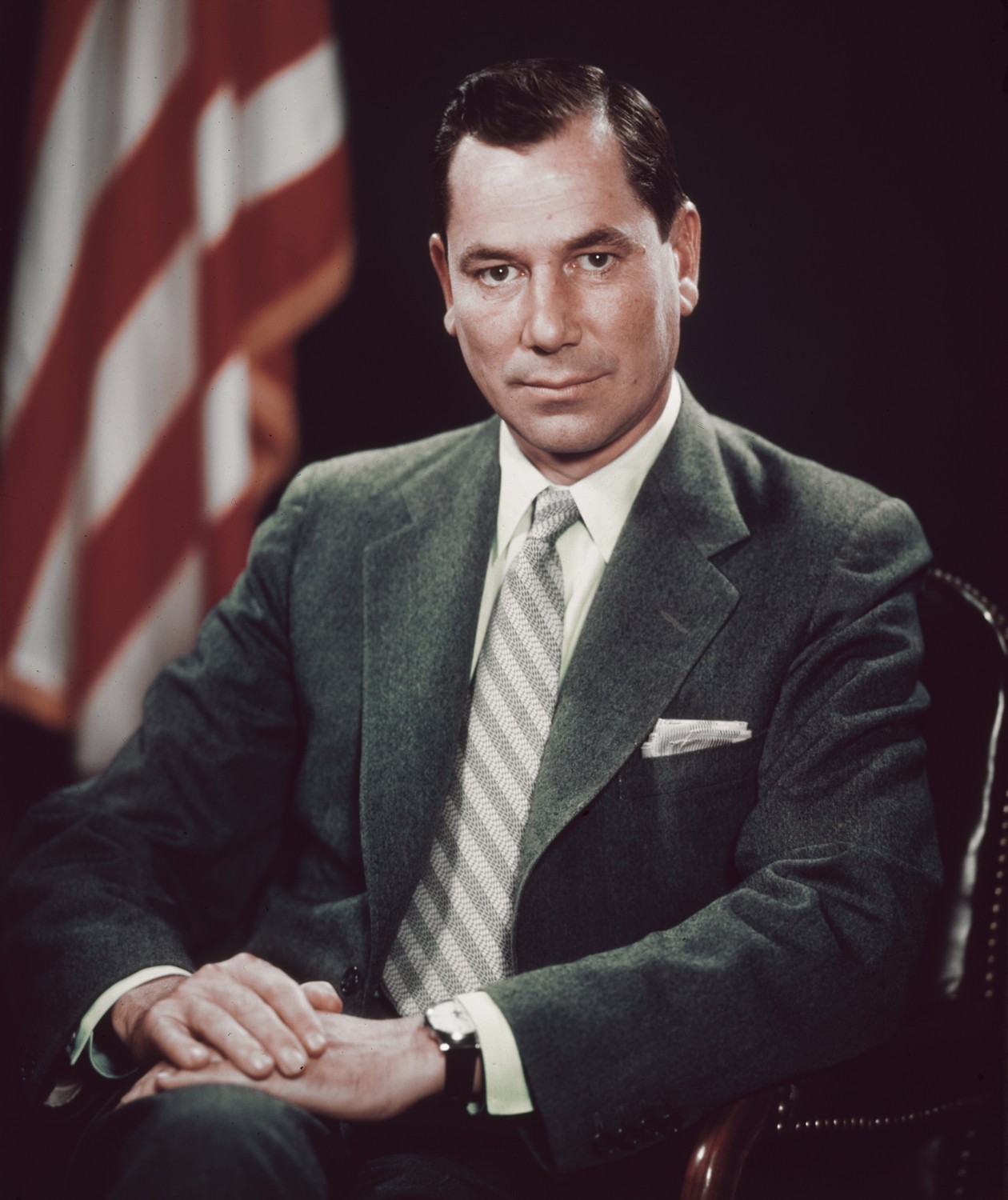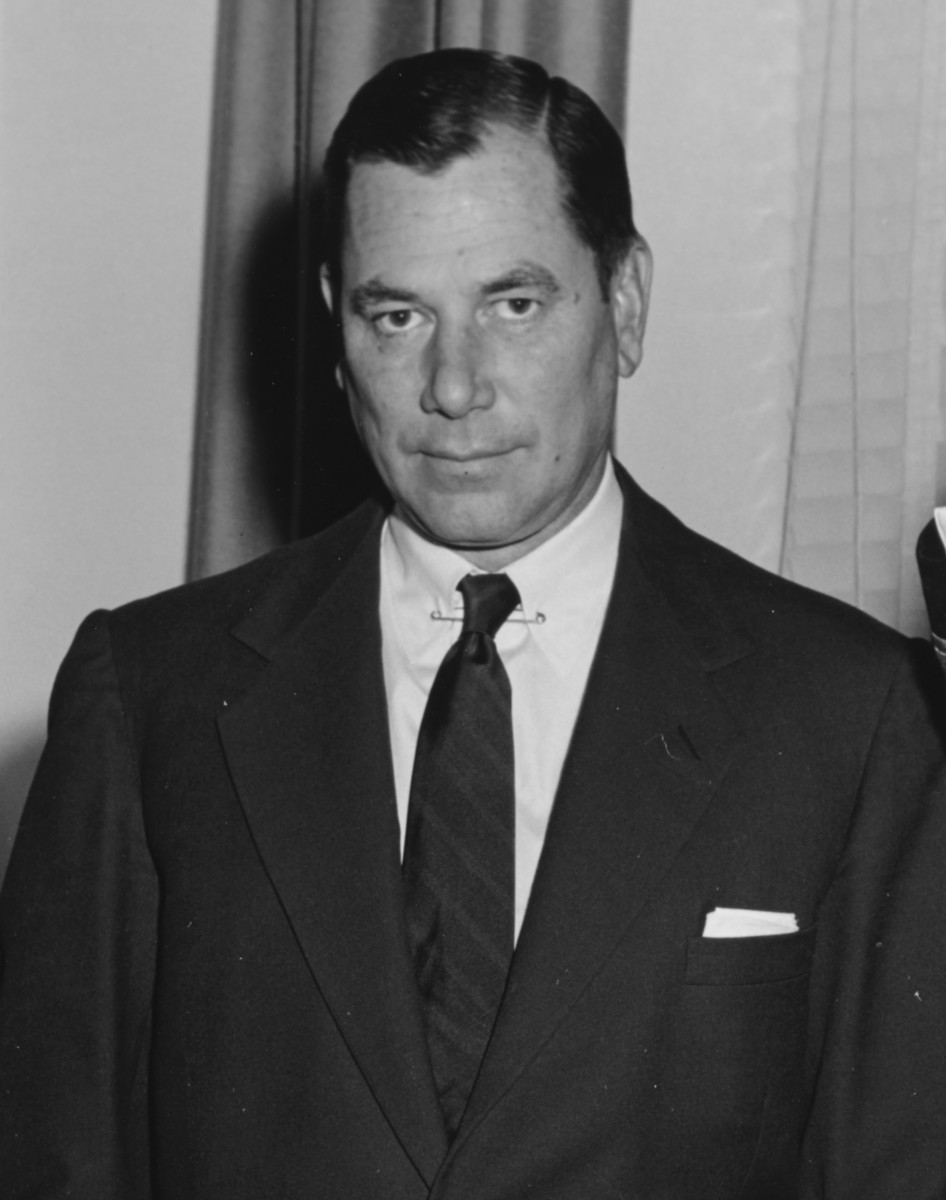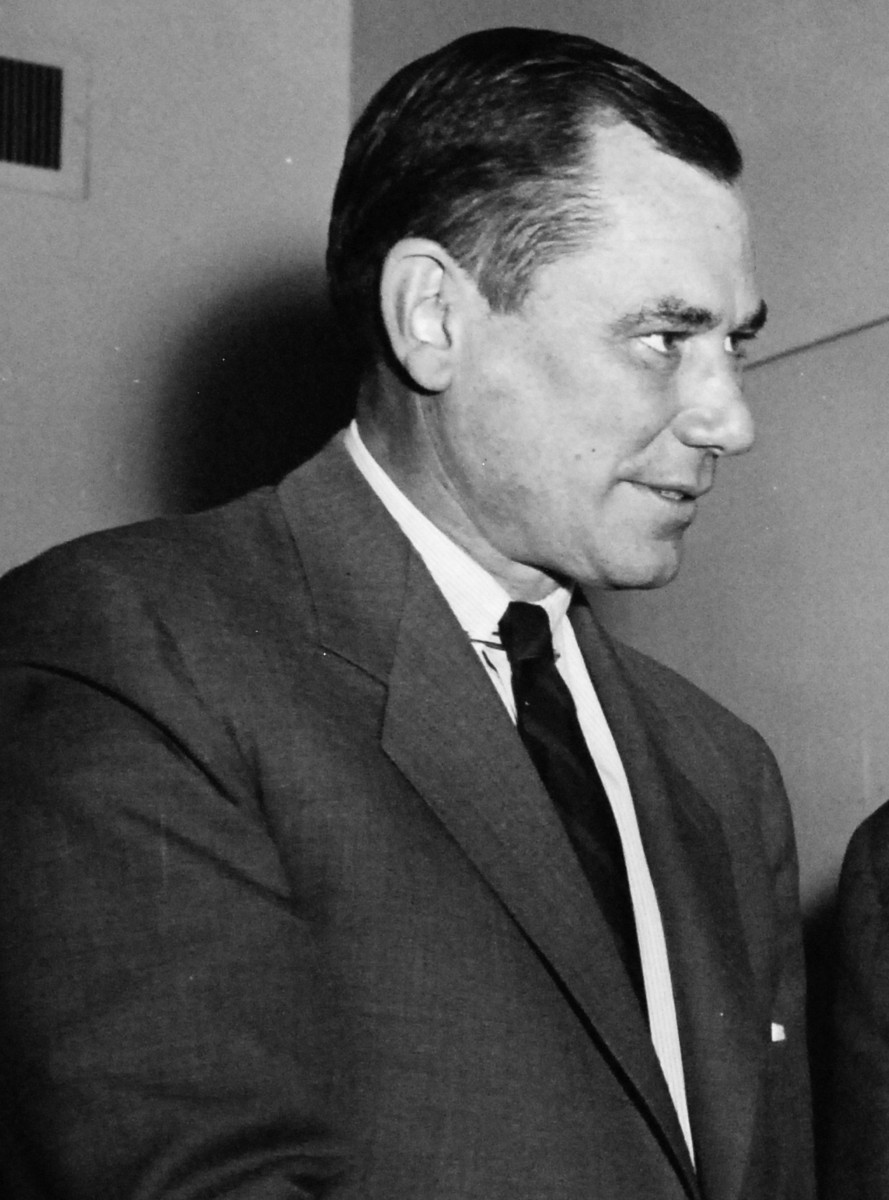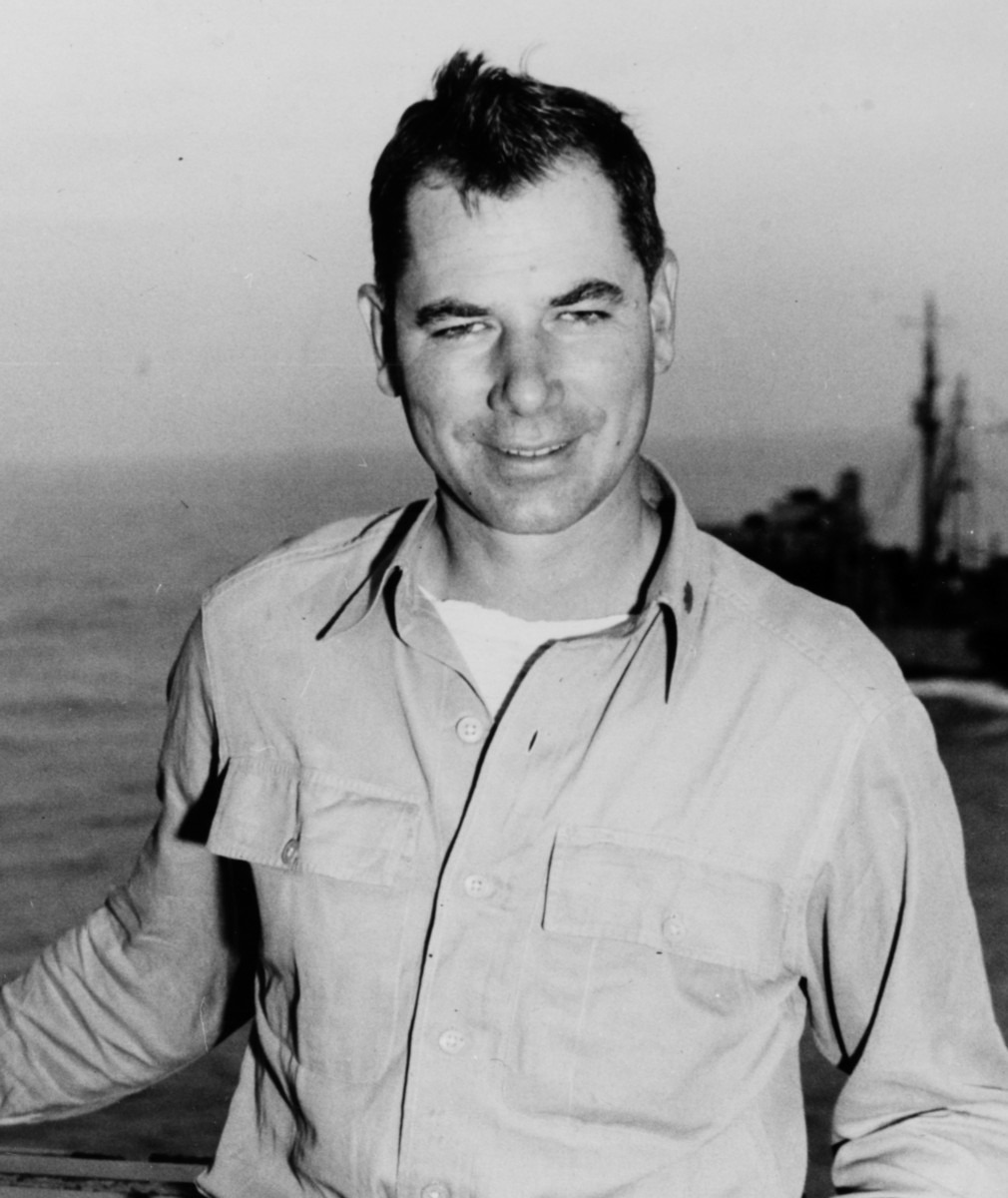 |
||||
|
HOME
|
US Navy -
ships
|
US Navy - air
units
|
USMC - air
units
|
International
Navies
|
Weapon Systems
|
Special Reports |
||||
|
US Navy - Guided Missile Cruiser CG 51 - USS Thomas S. Gates |
||||
|
||||
| 11/23 | ||||
|
Type,
class: Guided Missile Cruiser (CG); Ticonderoga
class Builder: Bath Iron Works, Bath, Maine, USA STATUS: Awarded: May 20, 1982 Laid down: August 31, 1984 Launched: December 14, 1985 Commissioned: August 22, 1987 Decommissioned: December 16, 2005 Fate: sold for scrap / scrapped in New Orleans, Louisiana Namesake: Thomas Sovereign Gates, Jr. (1906-1983) Ships Motto: DEFENDER OF THE REPUBLIC Technical Data: see: INFO > Ticonderoga class Guided Missile Cruiser - CG |
||||
| images | ||||
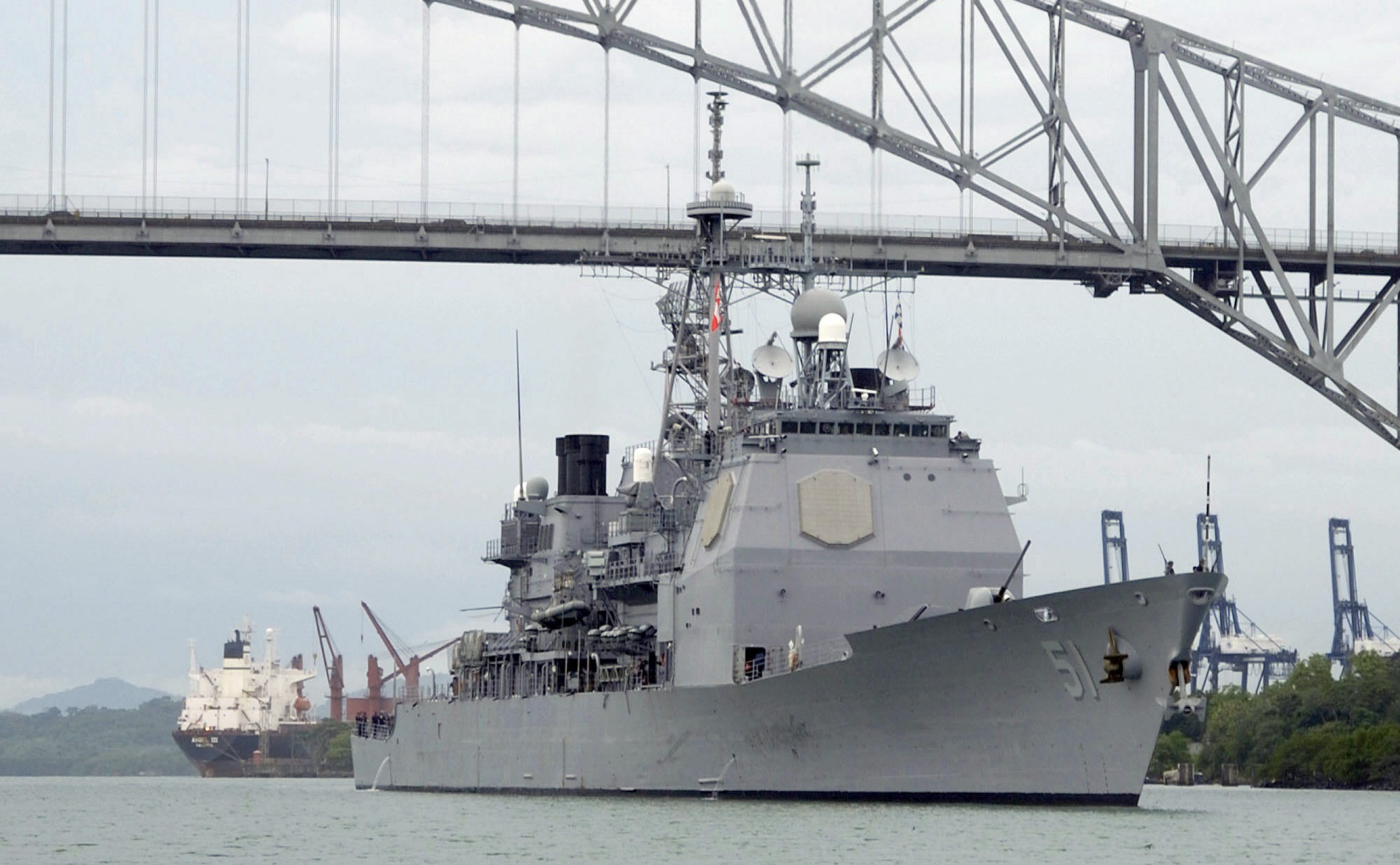 Port of Vasco Nunez de Balboa, Panama during exercise PANAMAX 2005 - August 2005 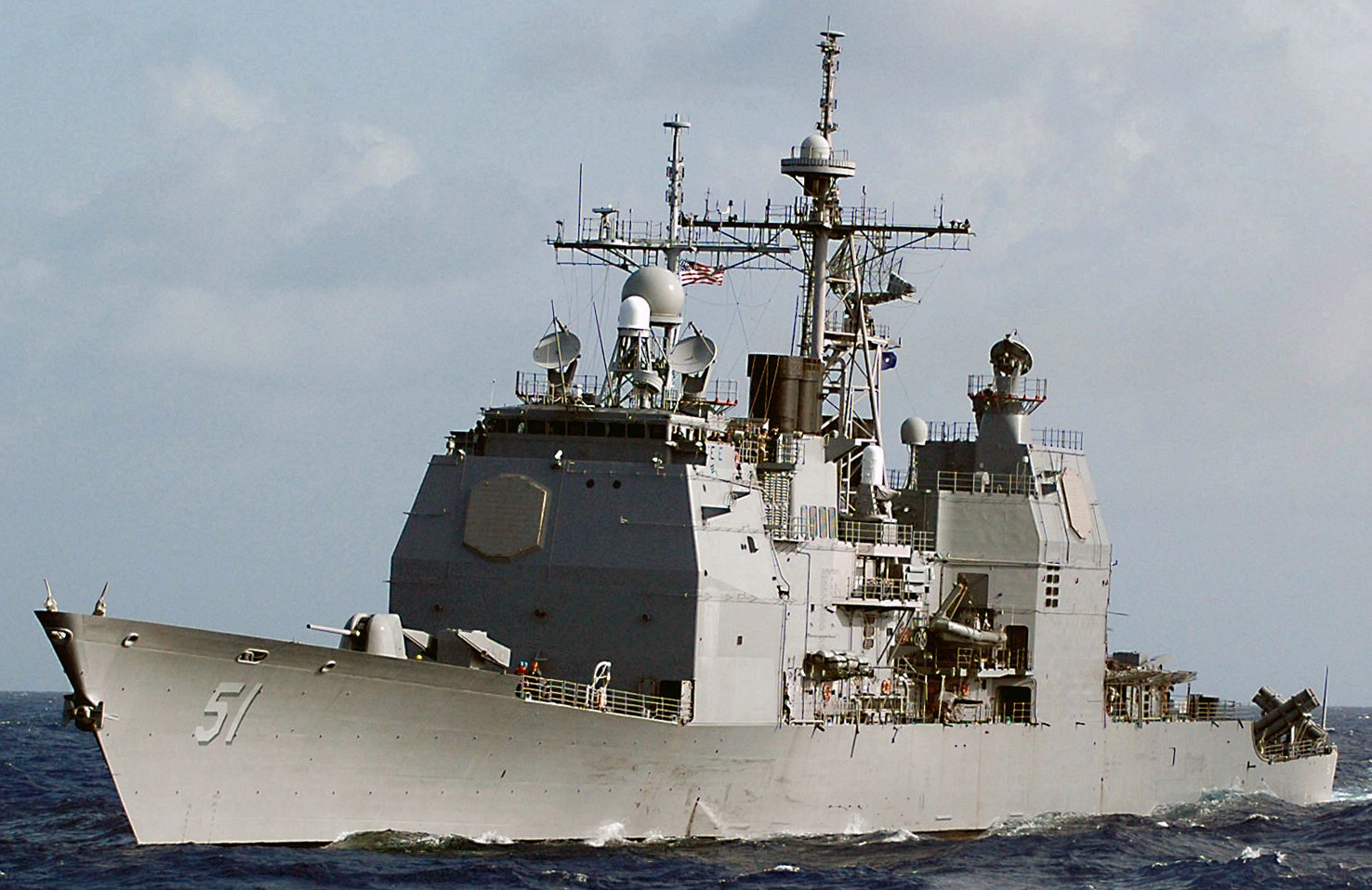 during exercise UNITAS - July 2005 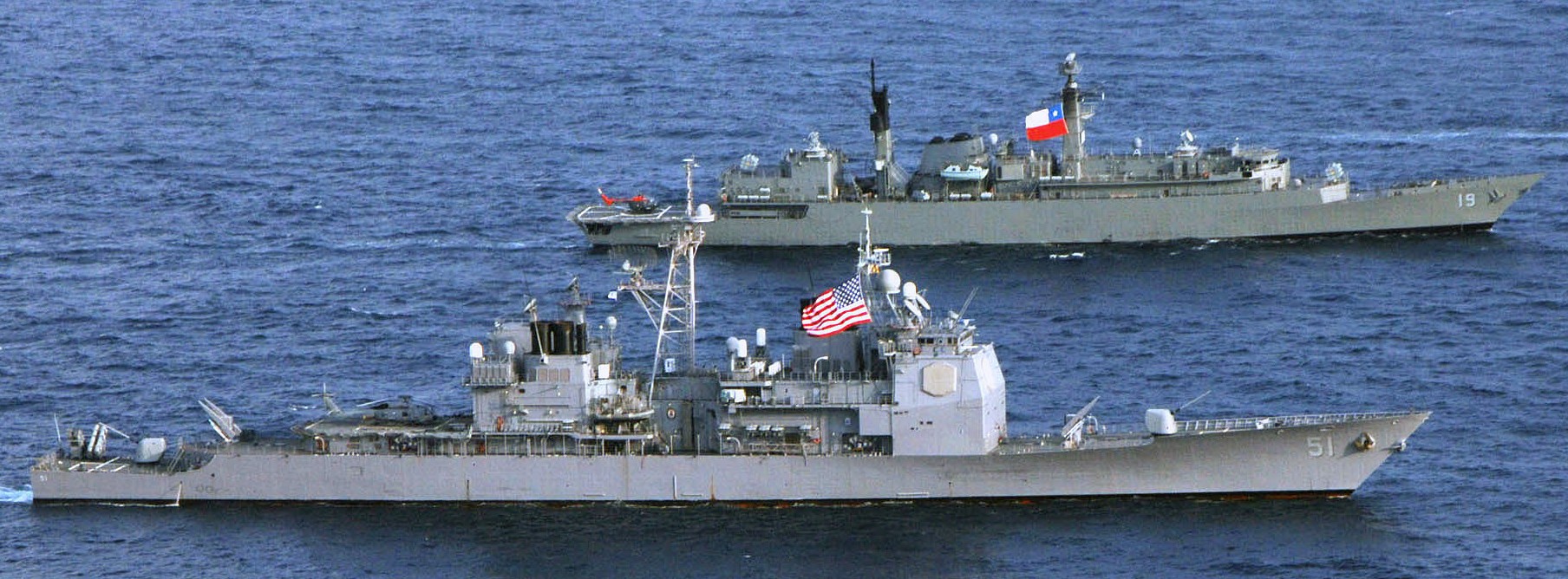 during exercise UNITAS - July 2005 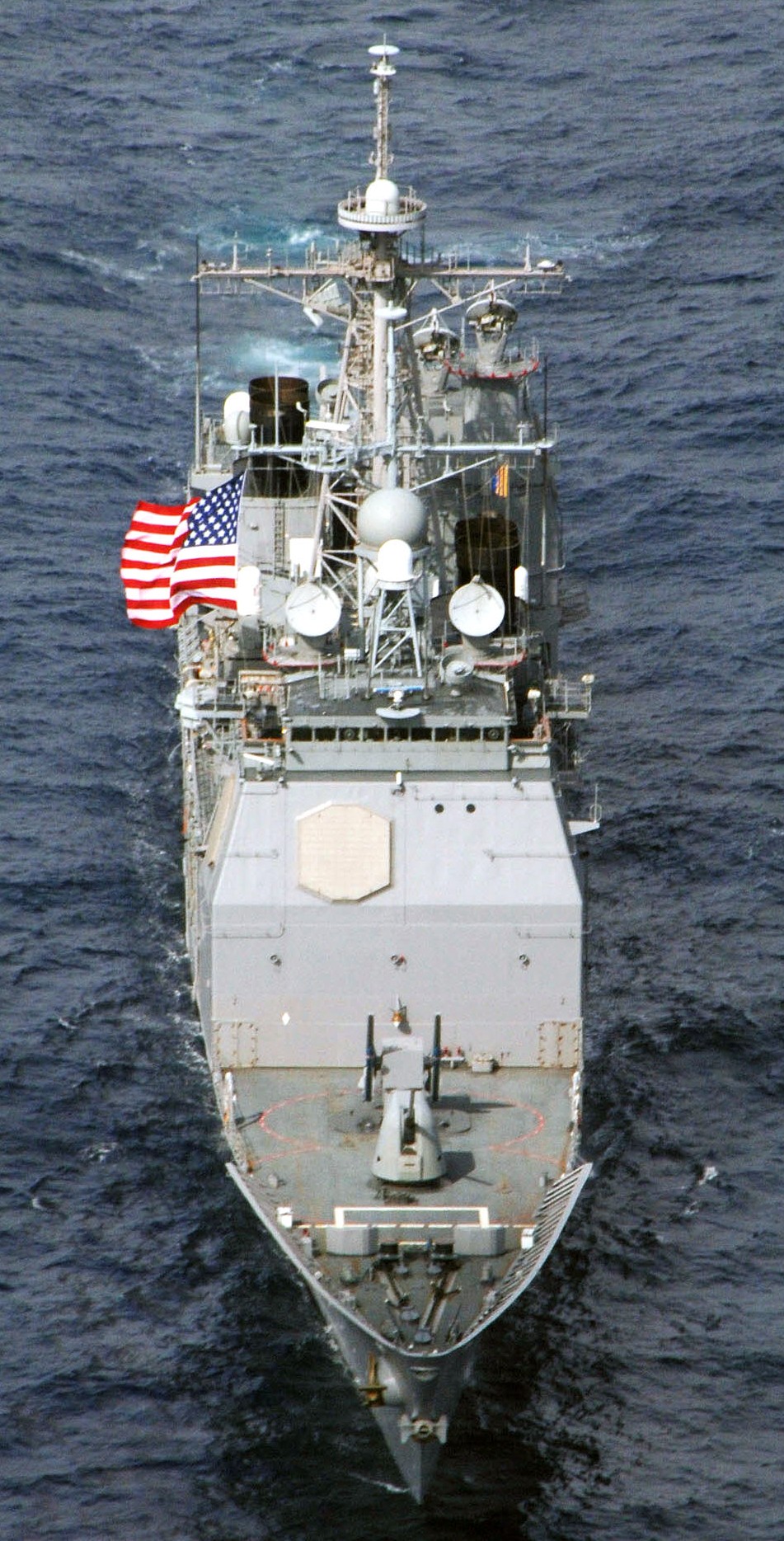 during exercise UNITAS - July 2005 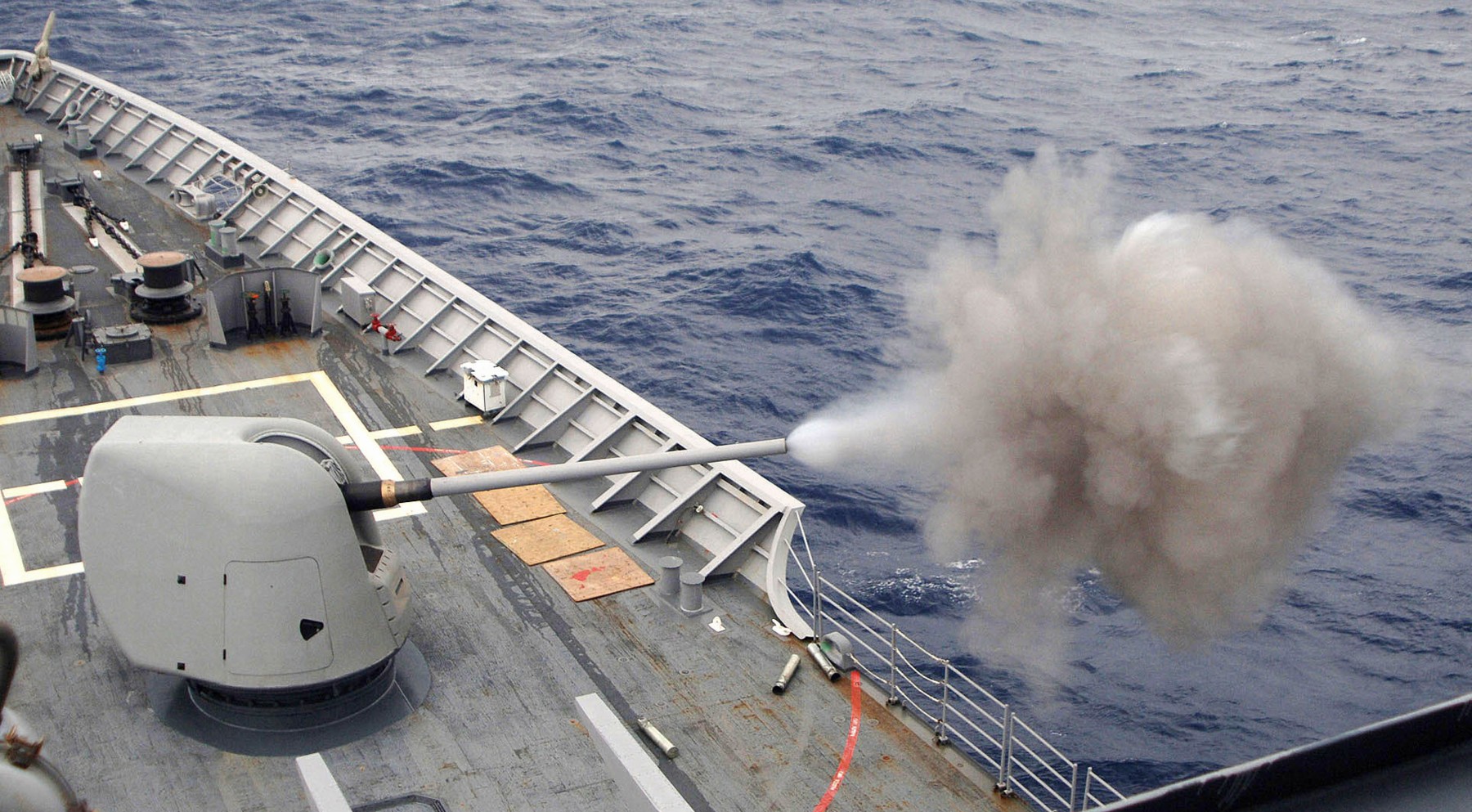 Mk.45 Mod.2 gun fire during exercise UNITAS - July 2005 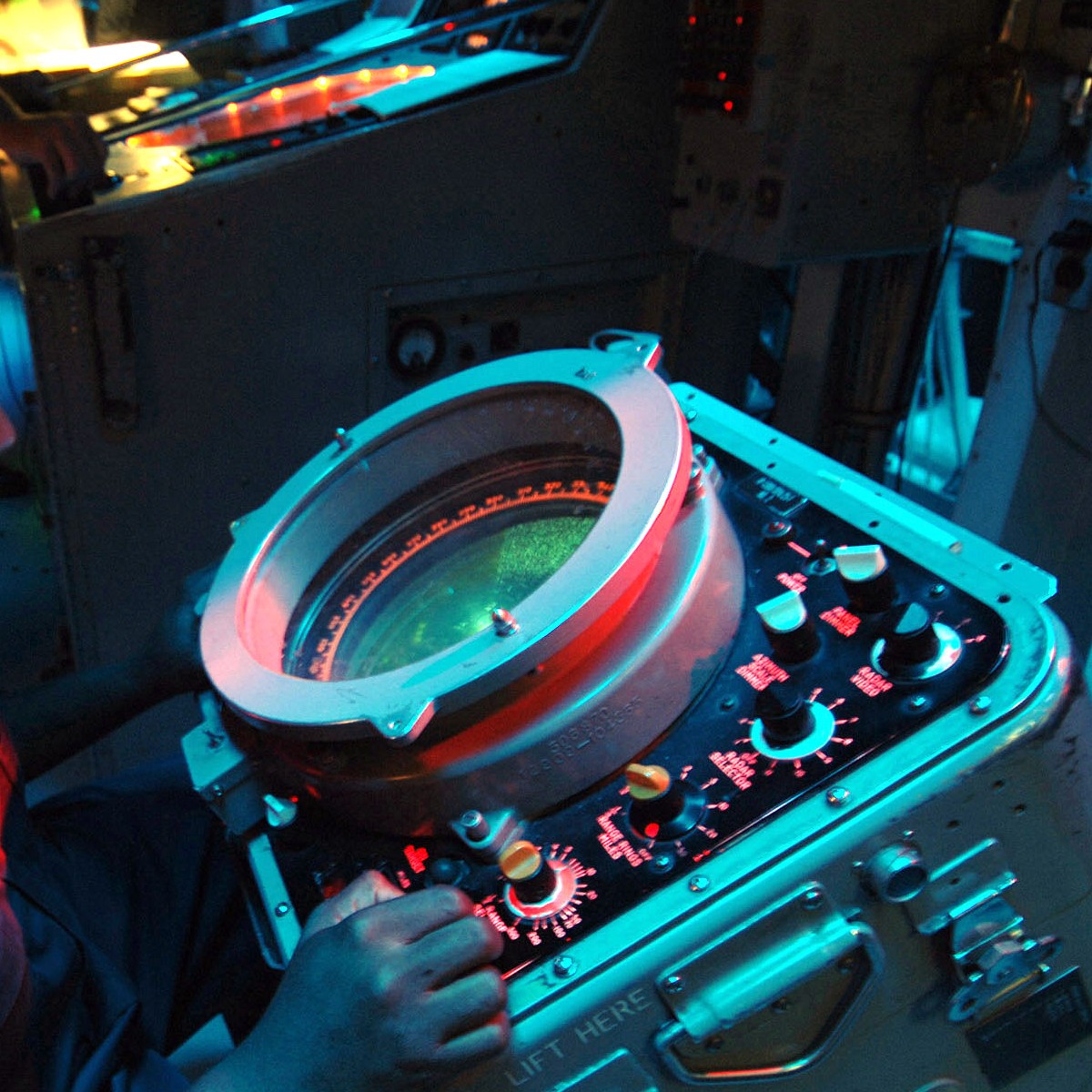 SPA-25F Radar Repeater in the Combat Information Center (CIC) - exercise UNITAS - July 2005 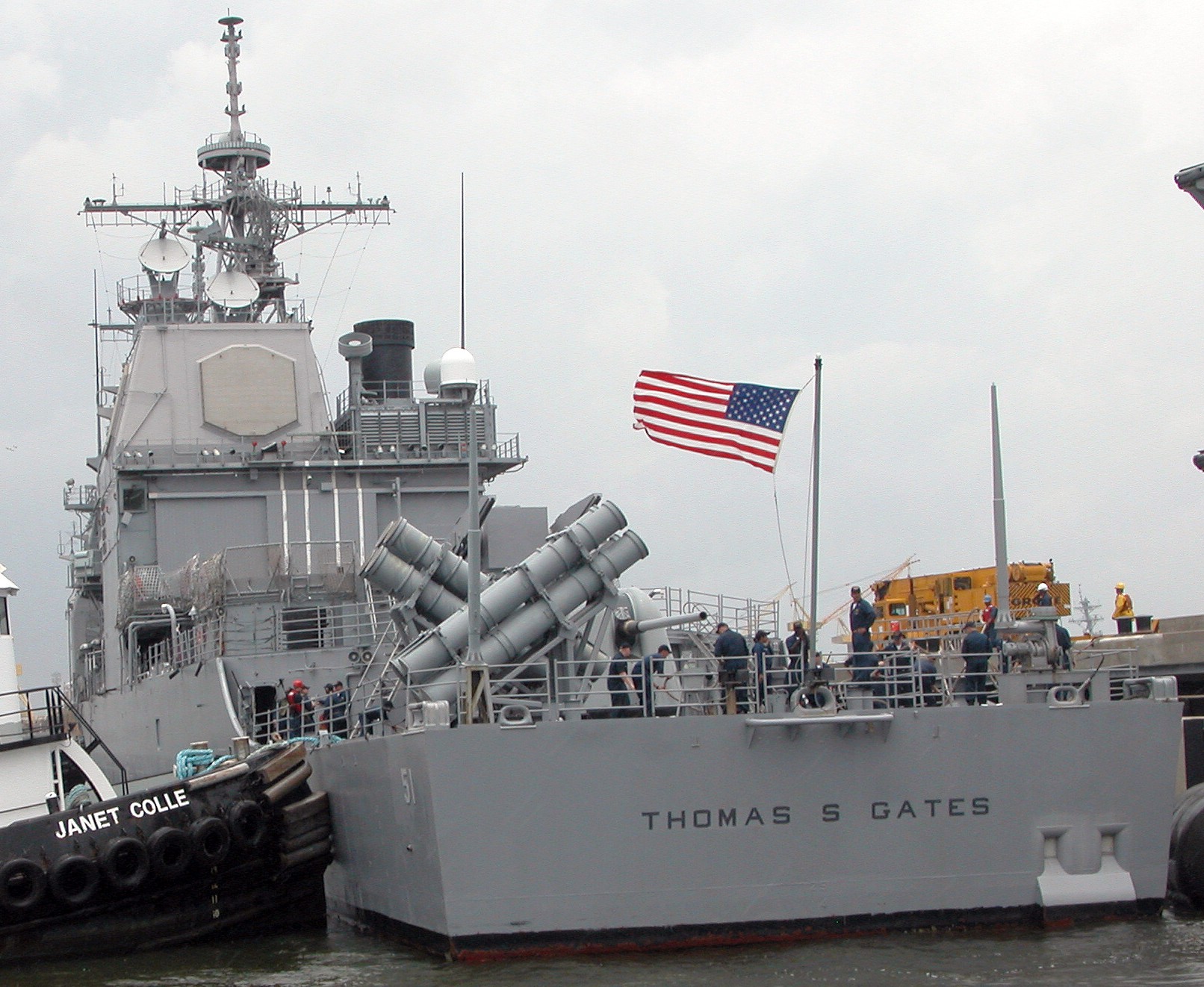 Naval Station Pascagoula, Mississippi - June 2005 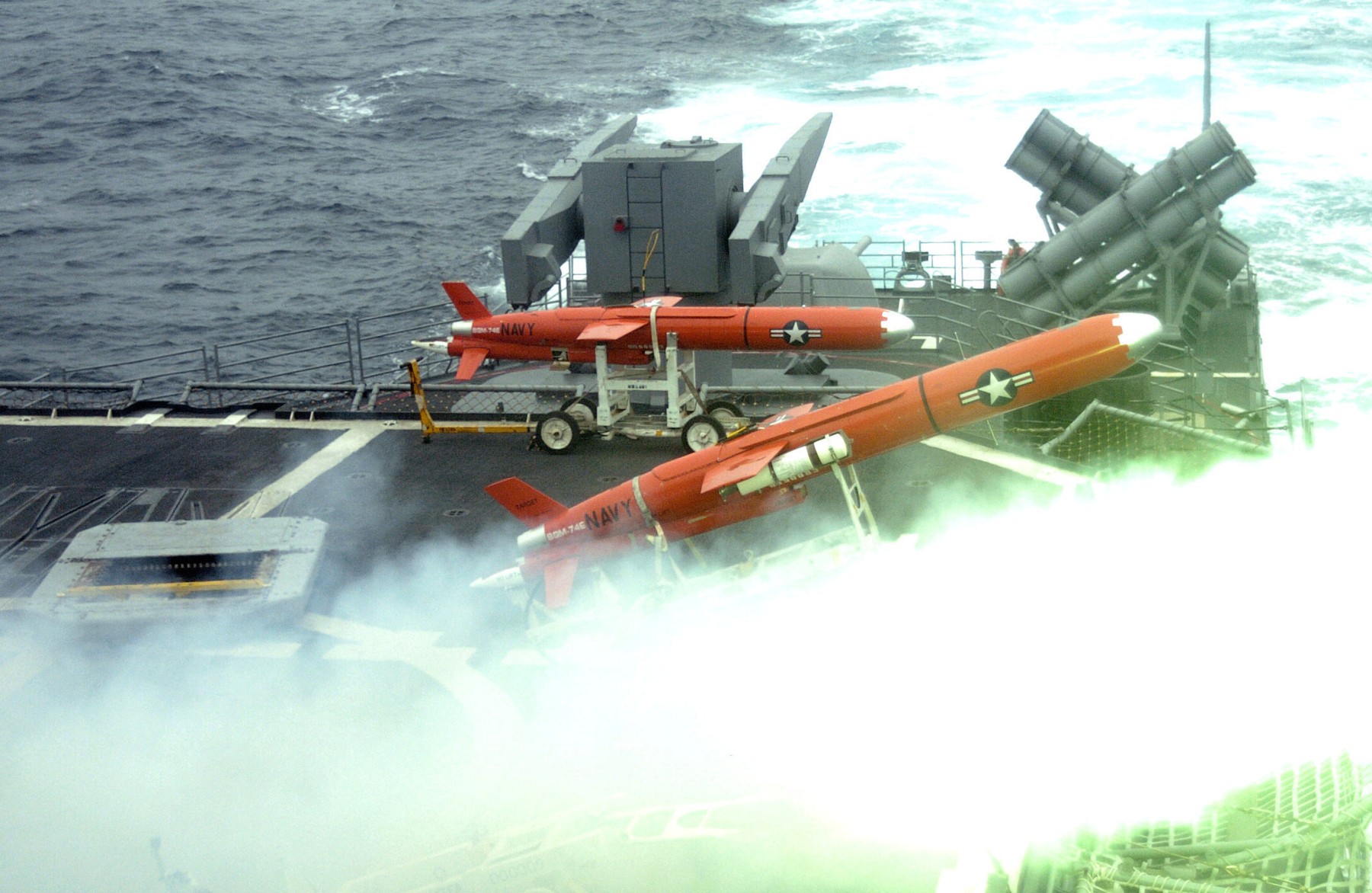 BQM-74E aerial target drones were launched during exercise UNITAS - South Atlantic Ocean - July 2004 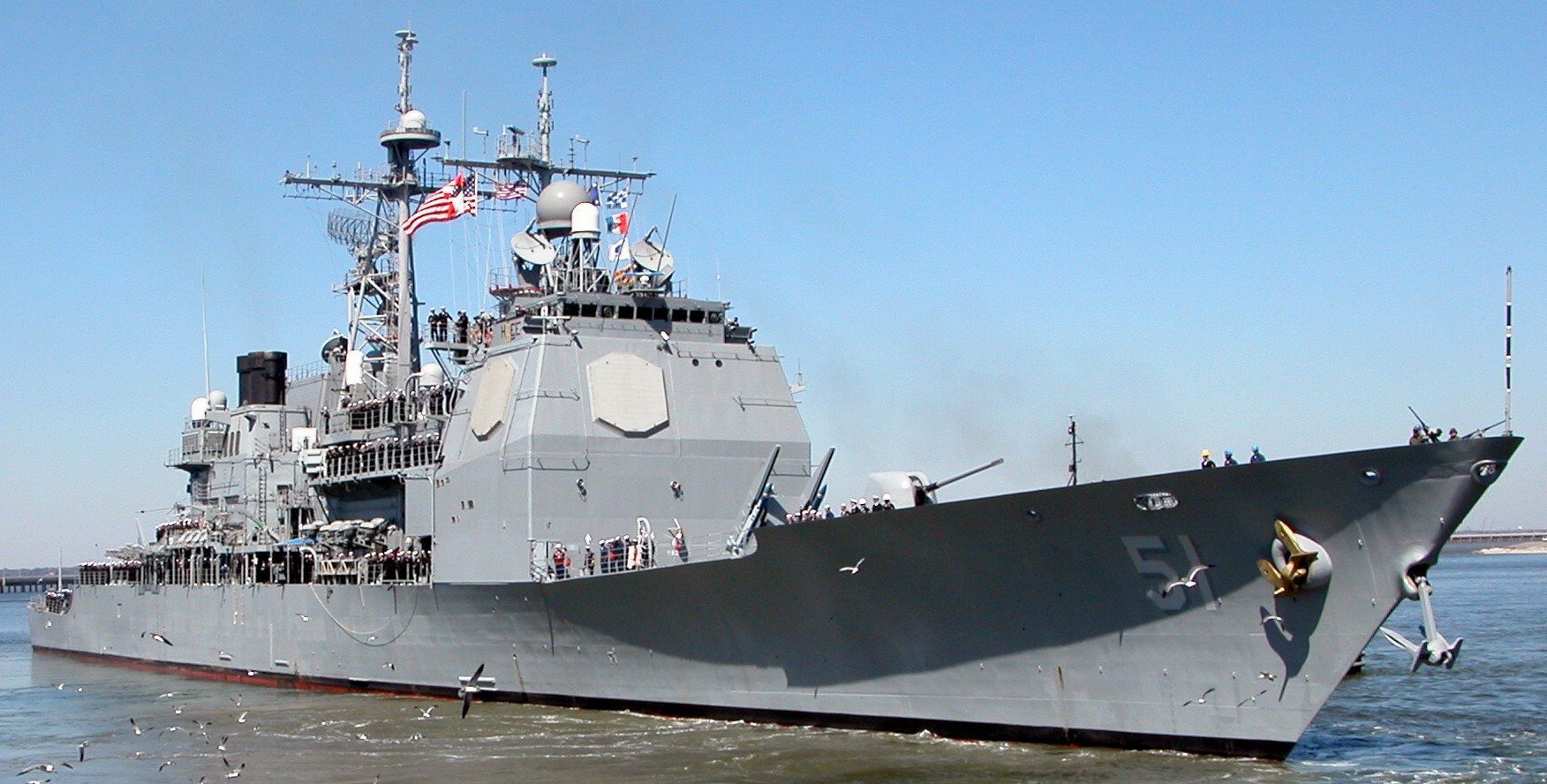 Naval Station Pascagoula, Mississippi - March 2004 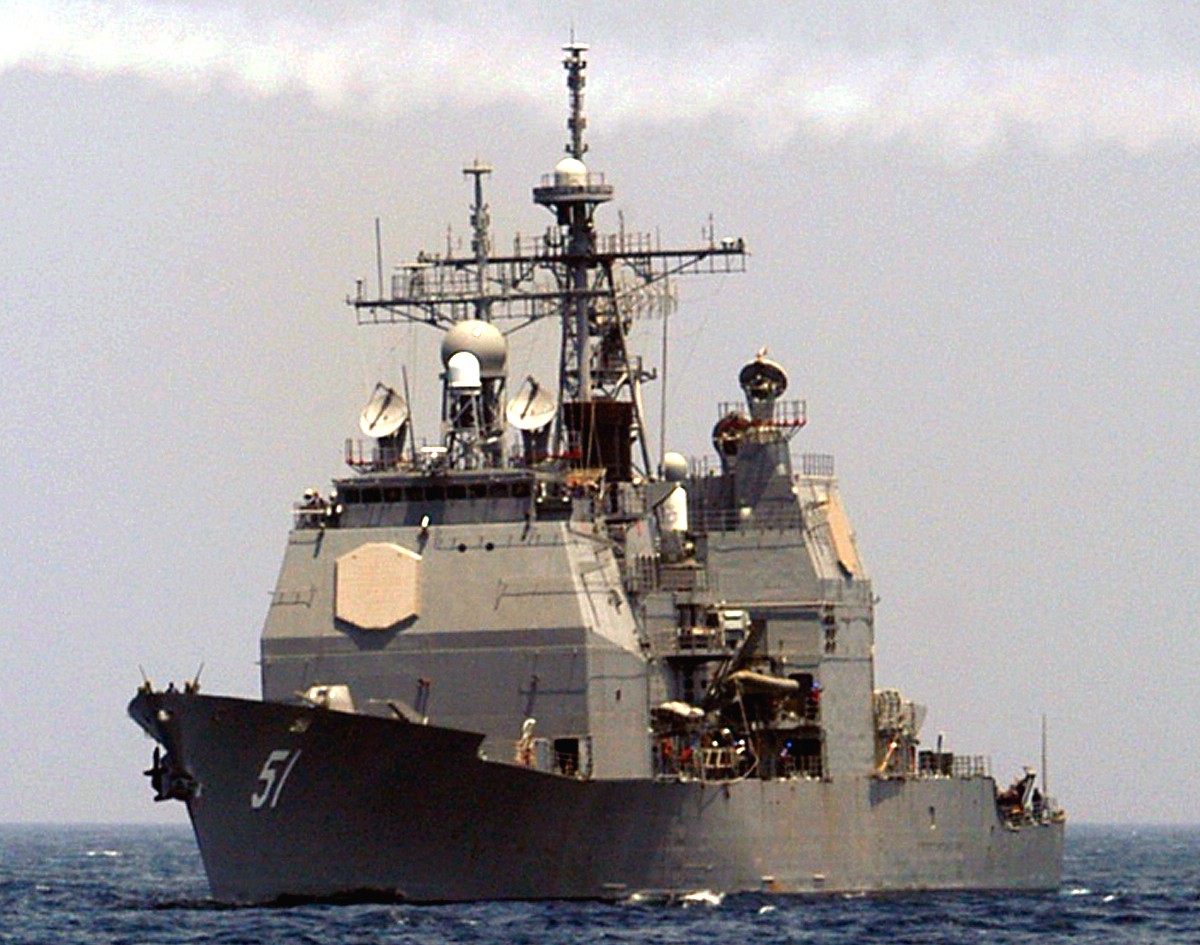 Gulf of Mexico - May 2003 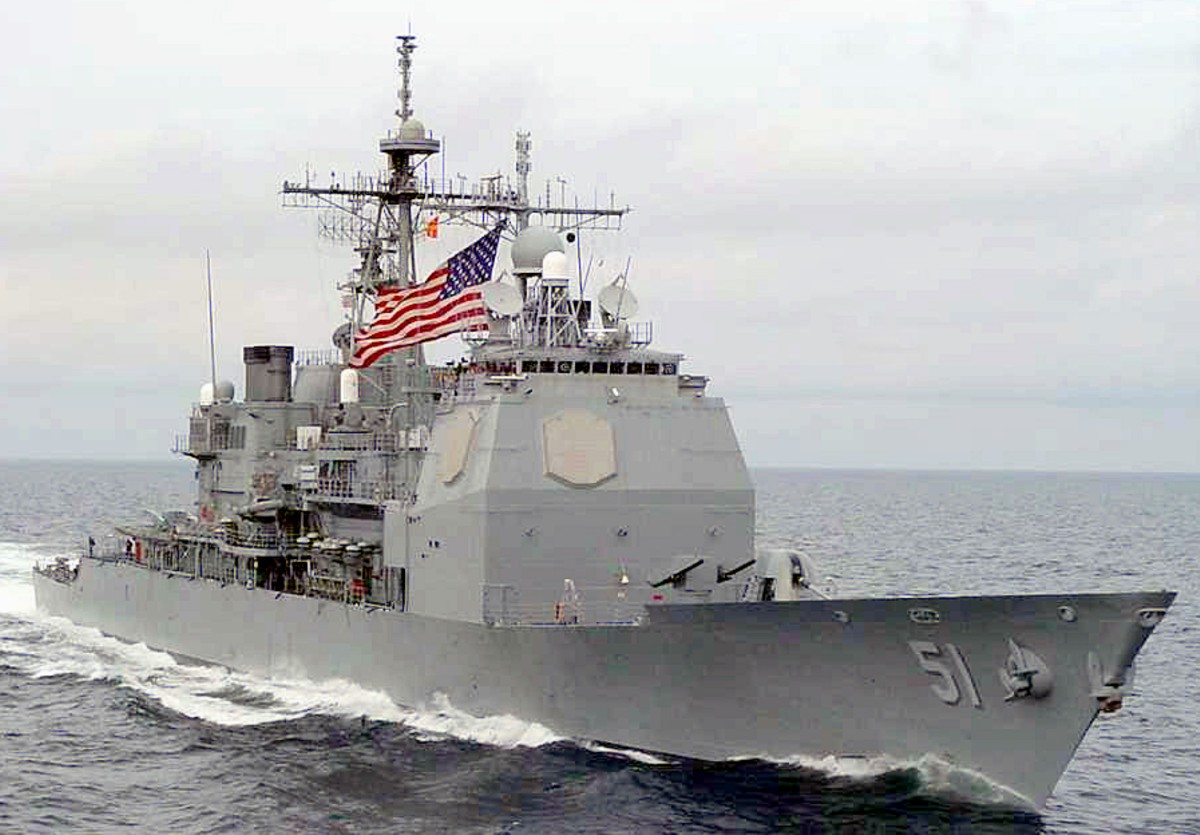 during exercise UNITAS - off Brazil - June 2002 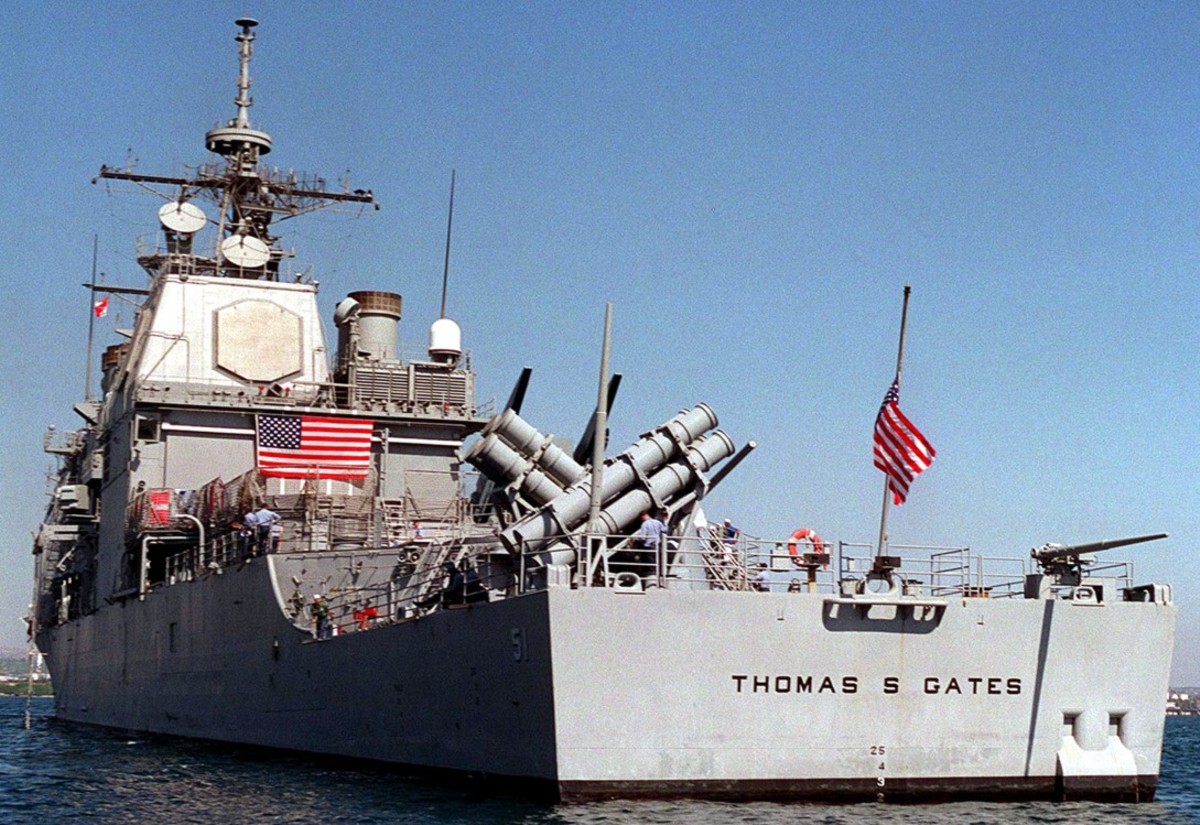 Augusta Bay, Sicily, Italy - July 1997 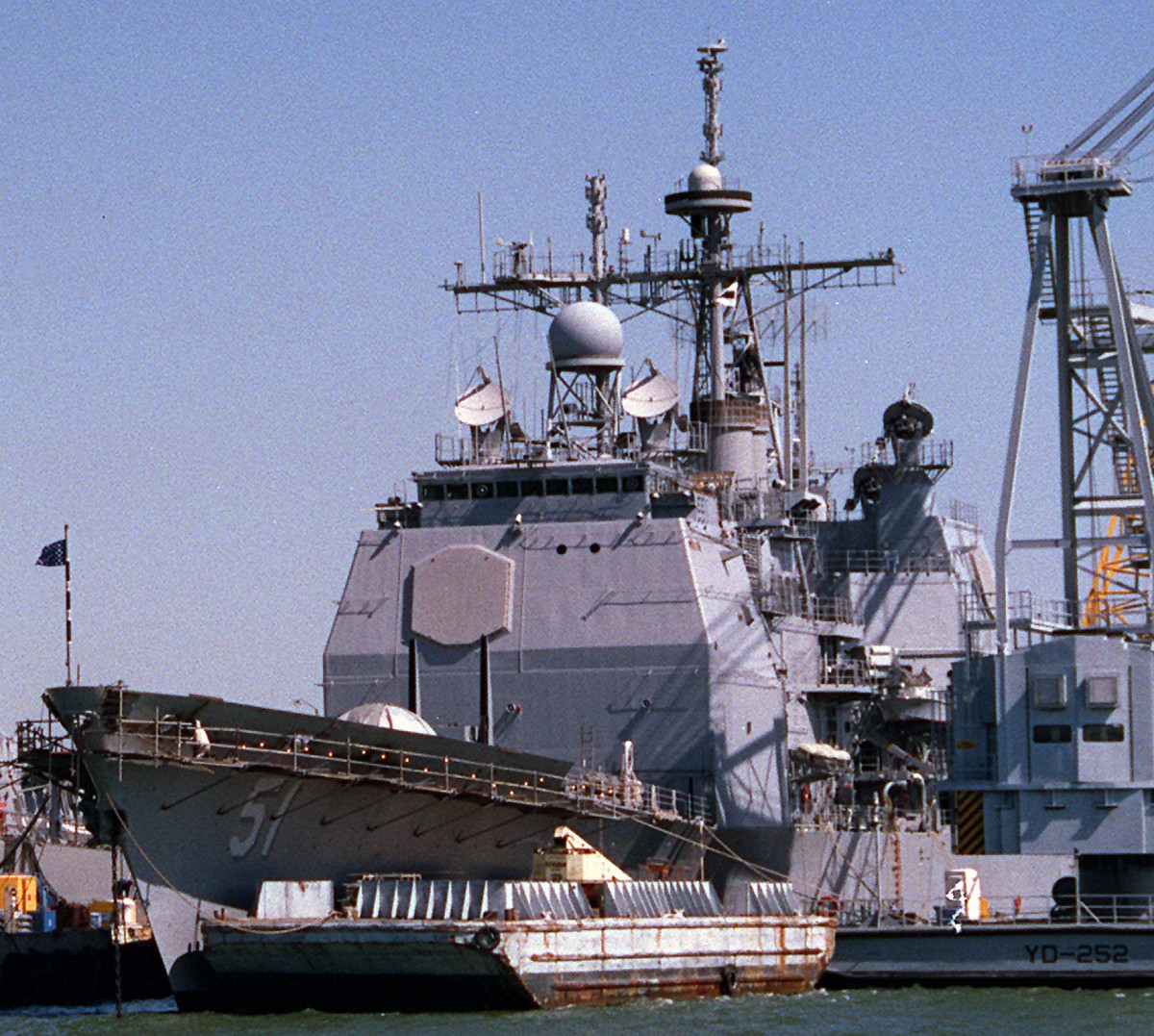 Naval Station Norfolk, Virginia - October 1993 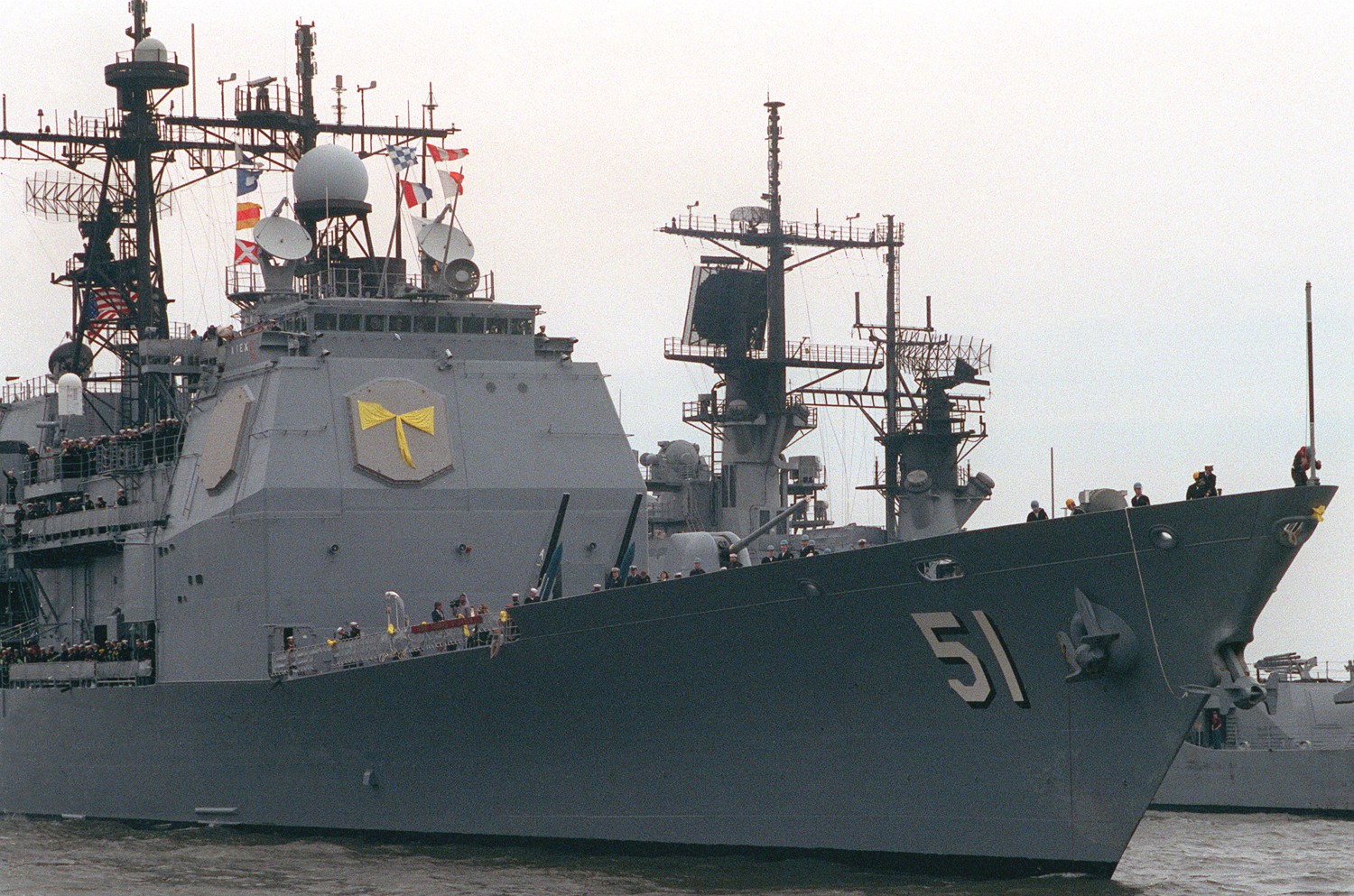 returning to Naval Station Norfolk, Virginia after Operation Desert Shield/Storm - March 1991 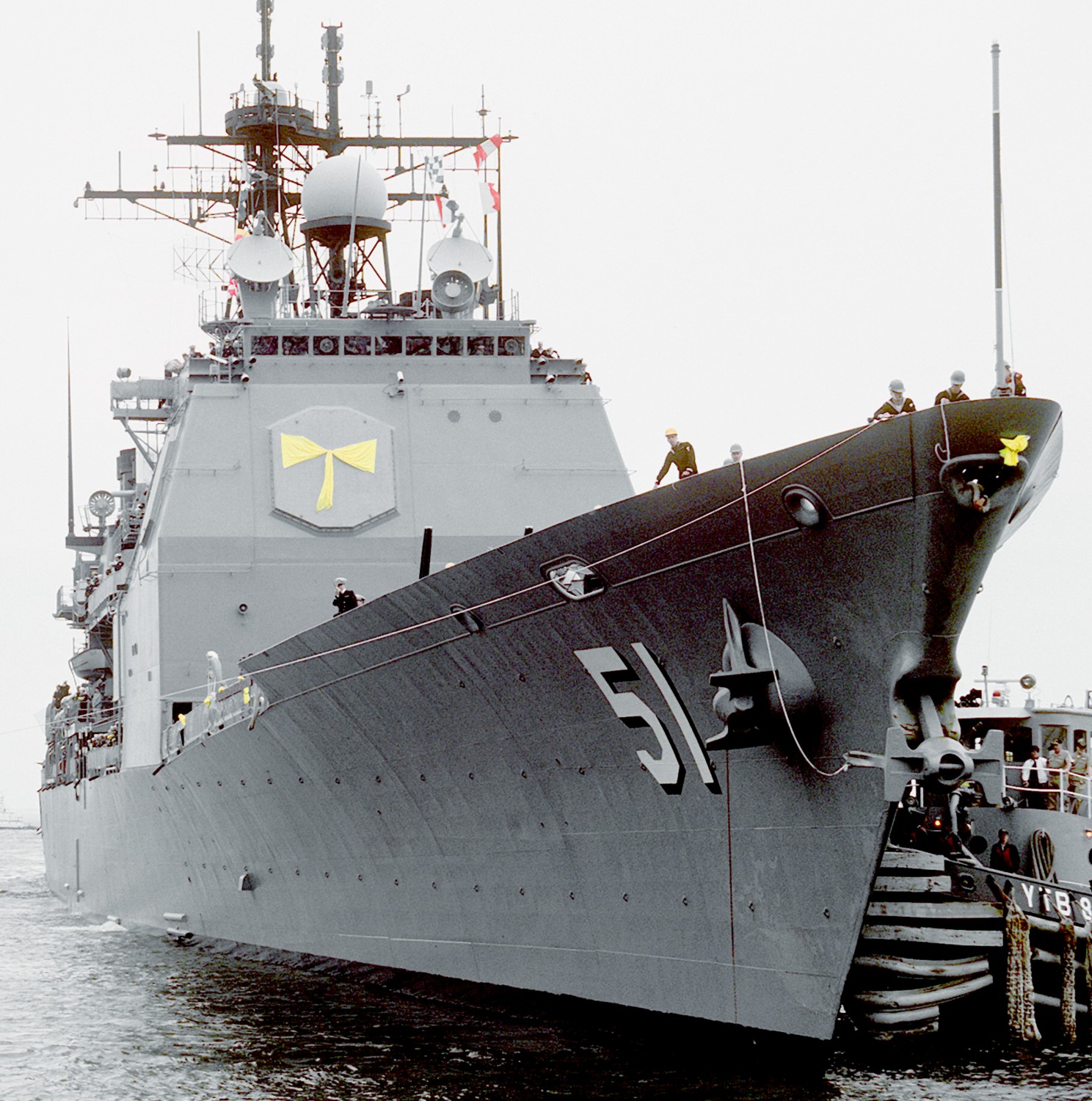 returning to Naval Station Norfolk, Virginia after Operation Desert Shield/Storm - March 1991 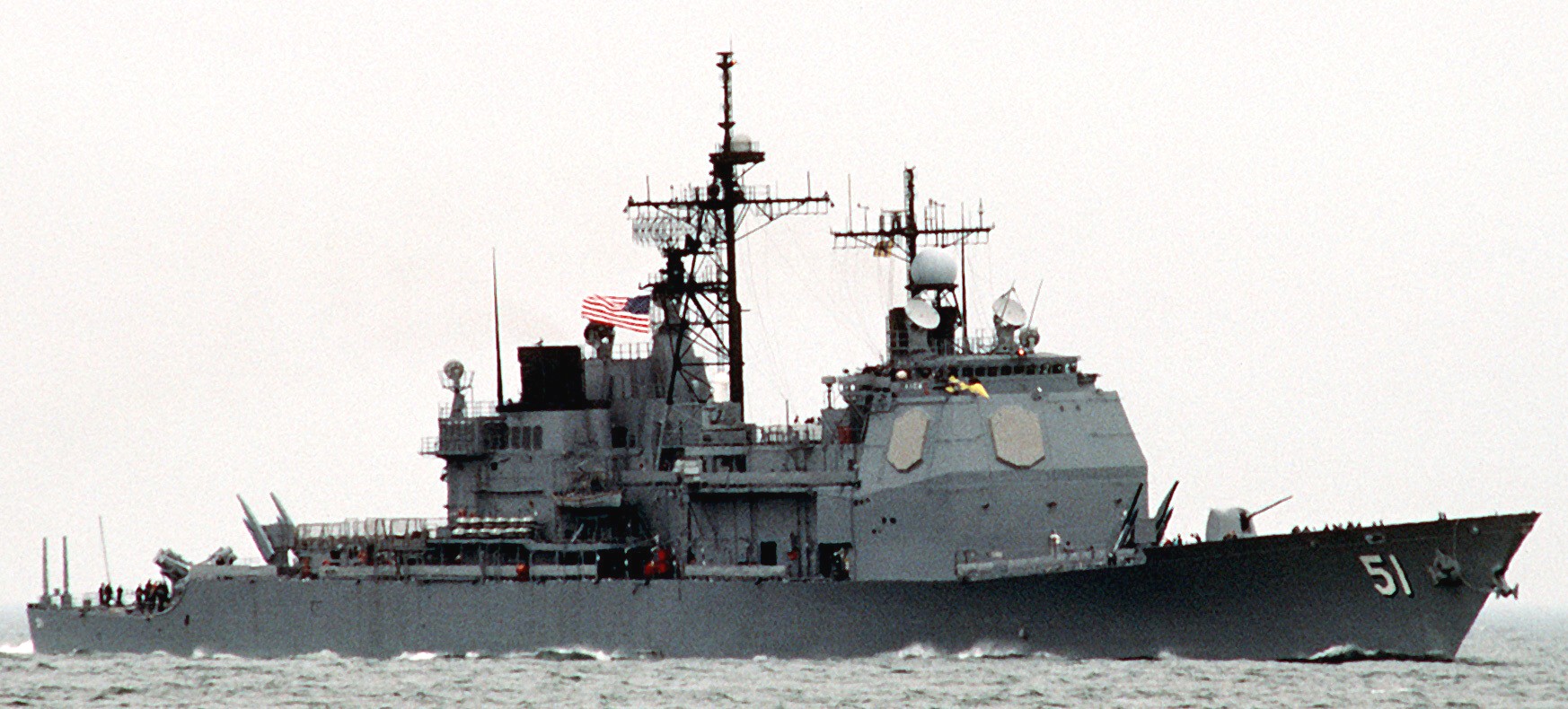 returning to Naval Station Norfolk, Virginia after Operation Desert Shield/Storm - March 1991 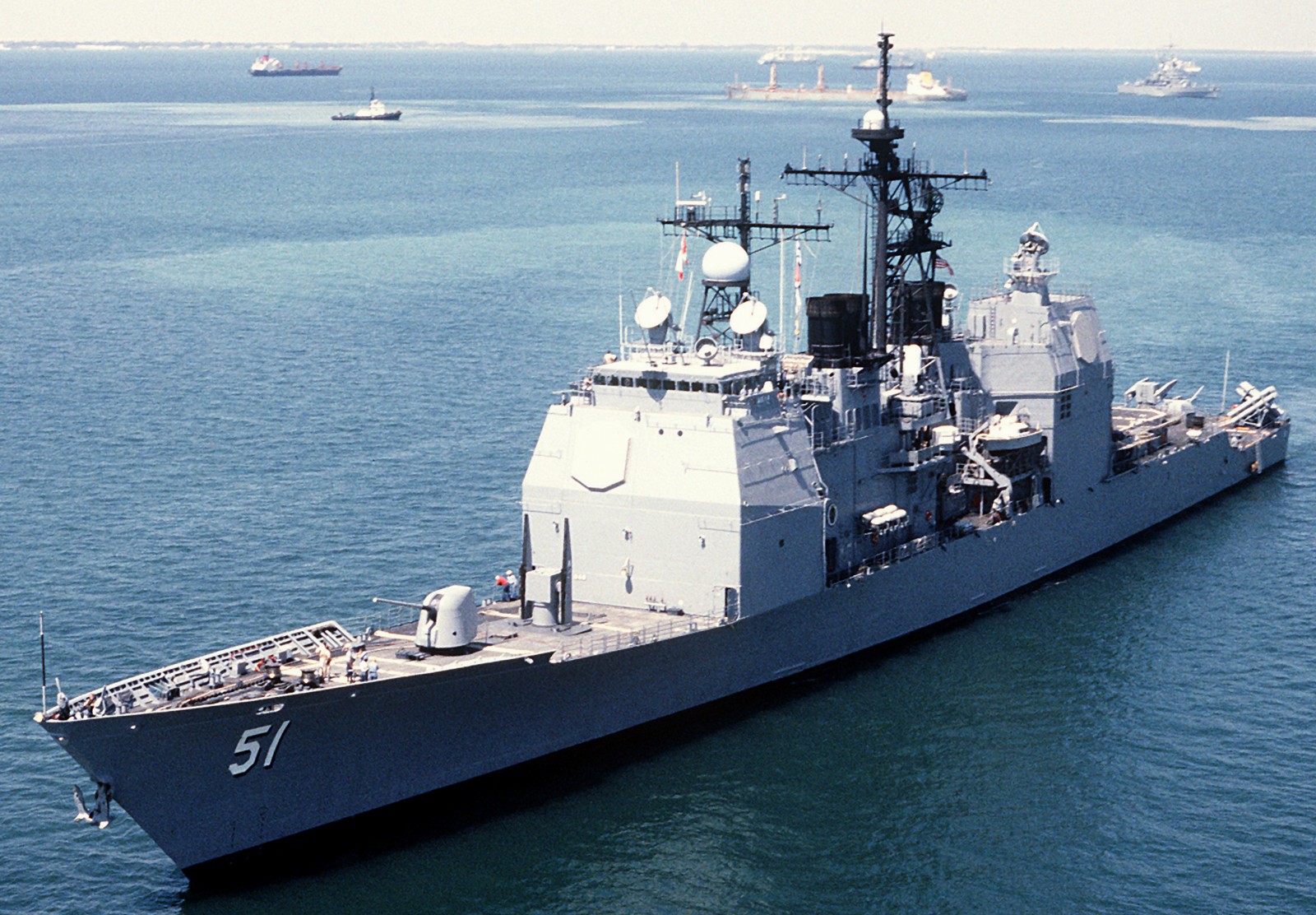 Great Bitter Lake (Suez Canal), Egypt - September 1990 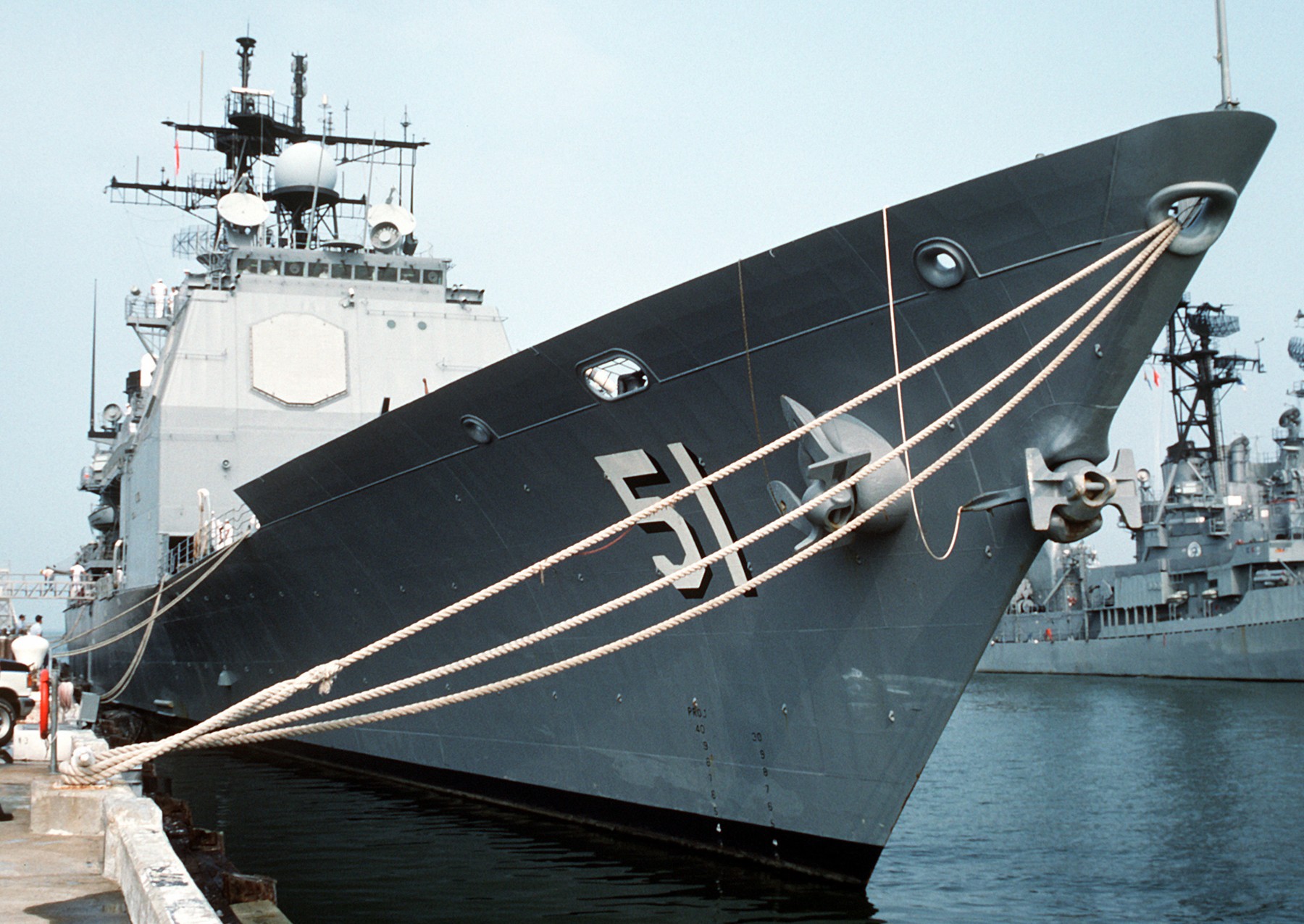 Naval Station Norfolk, Virginia - August 1990 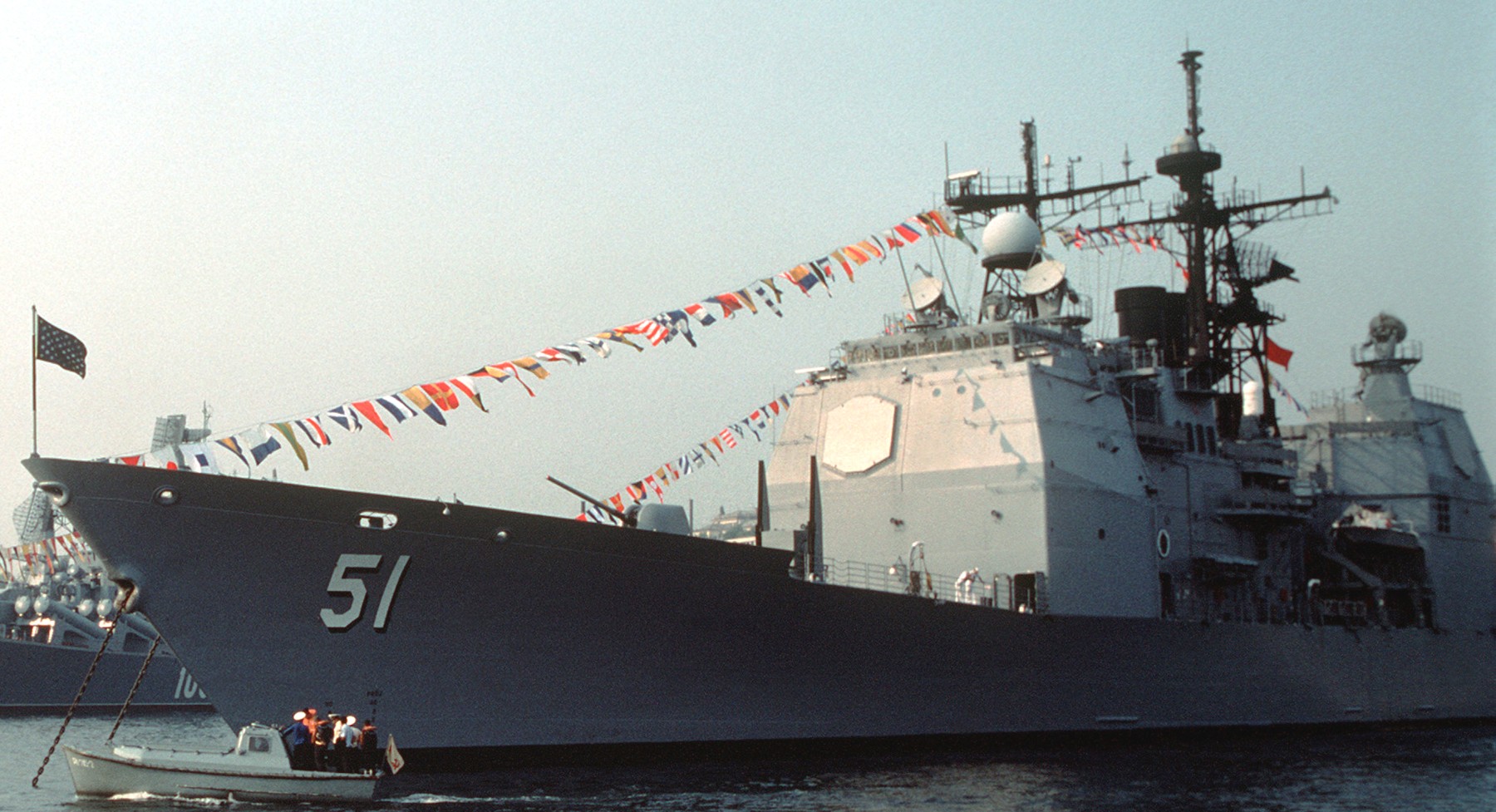 Sevastopol, USSR - August 1989 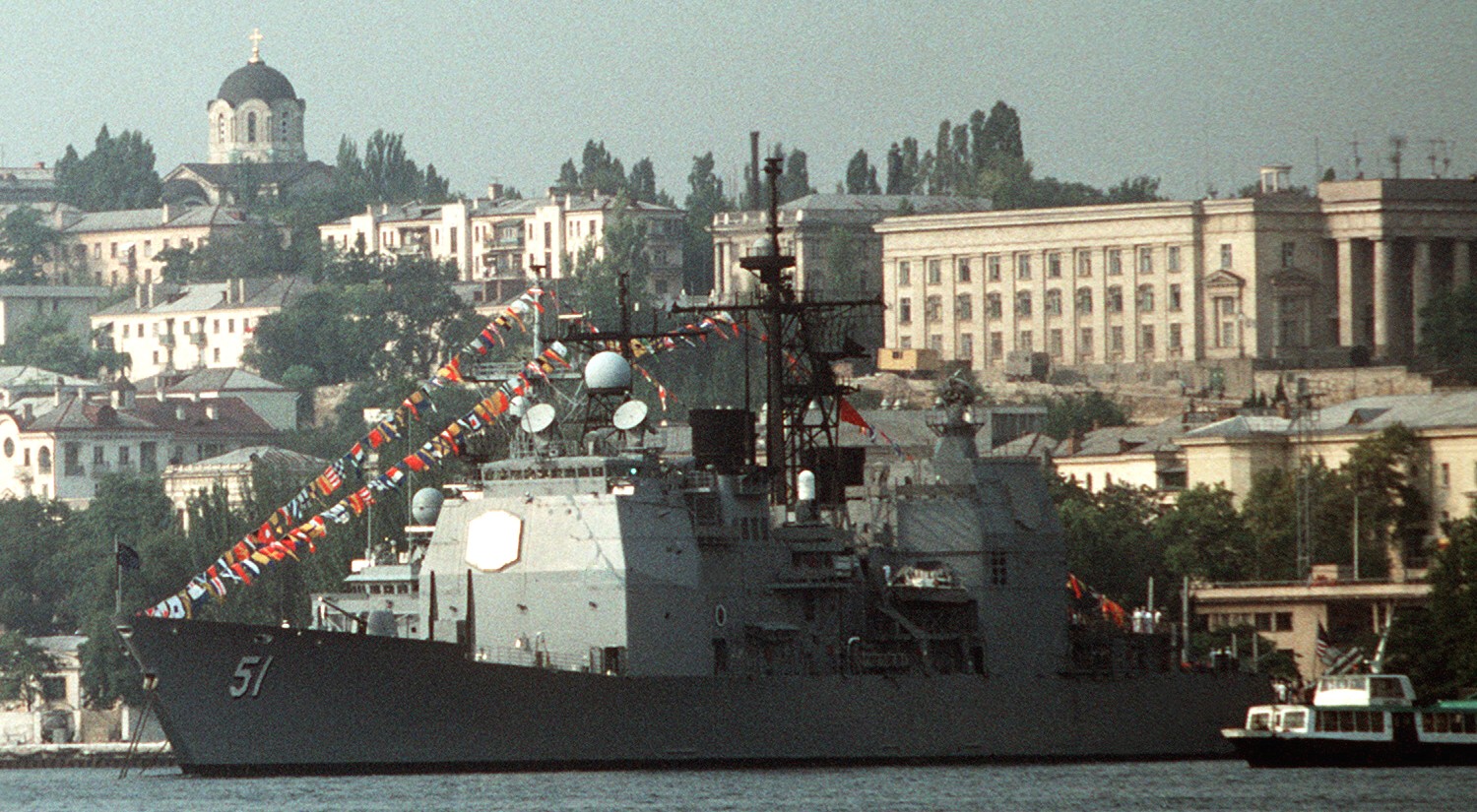 Sevastopol, USSR - August 1989 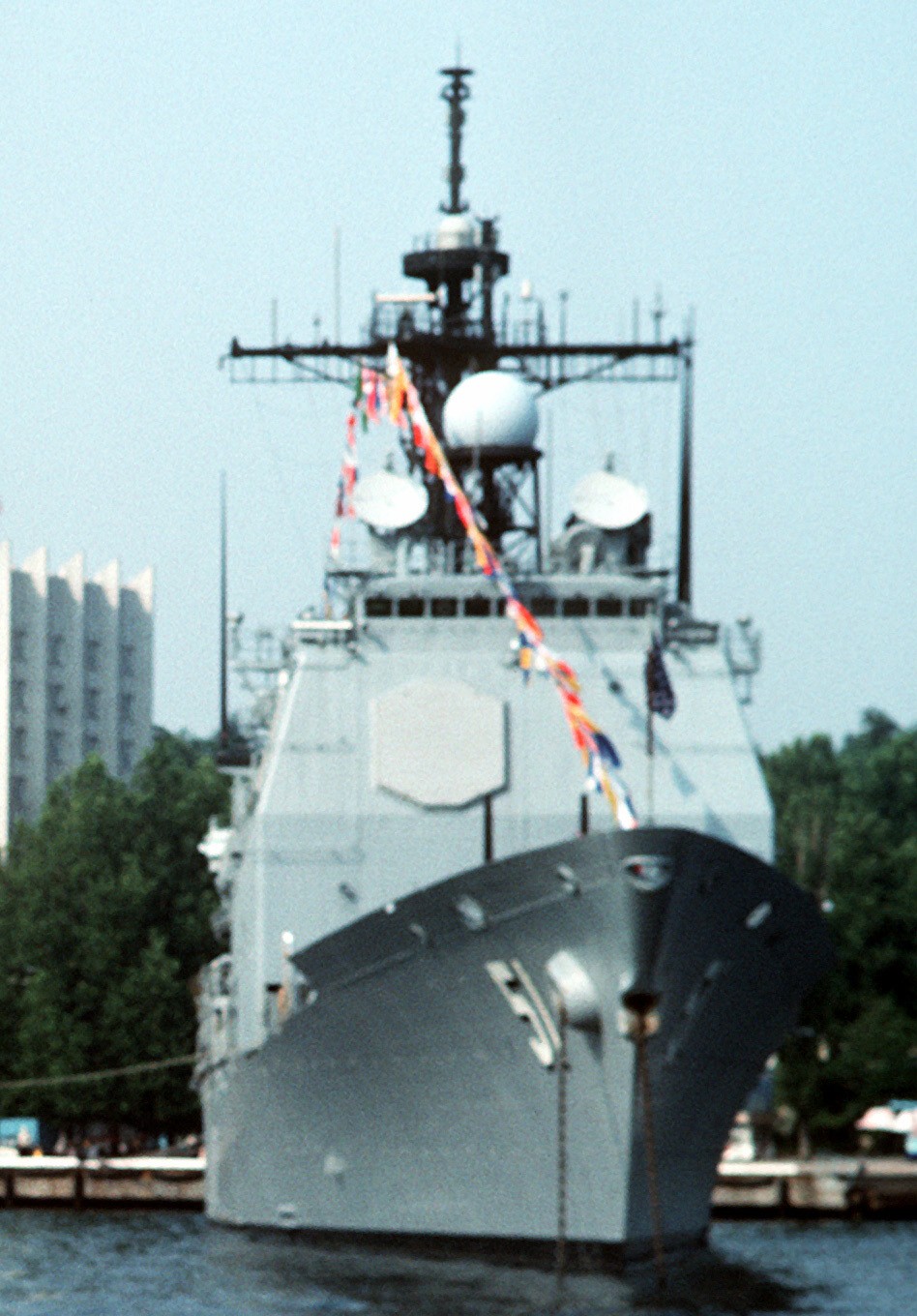 Sevastopol, USSR - August 1989 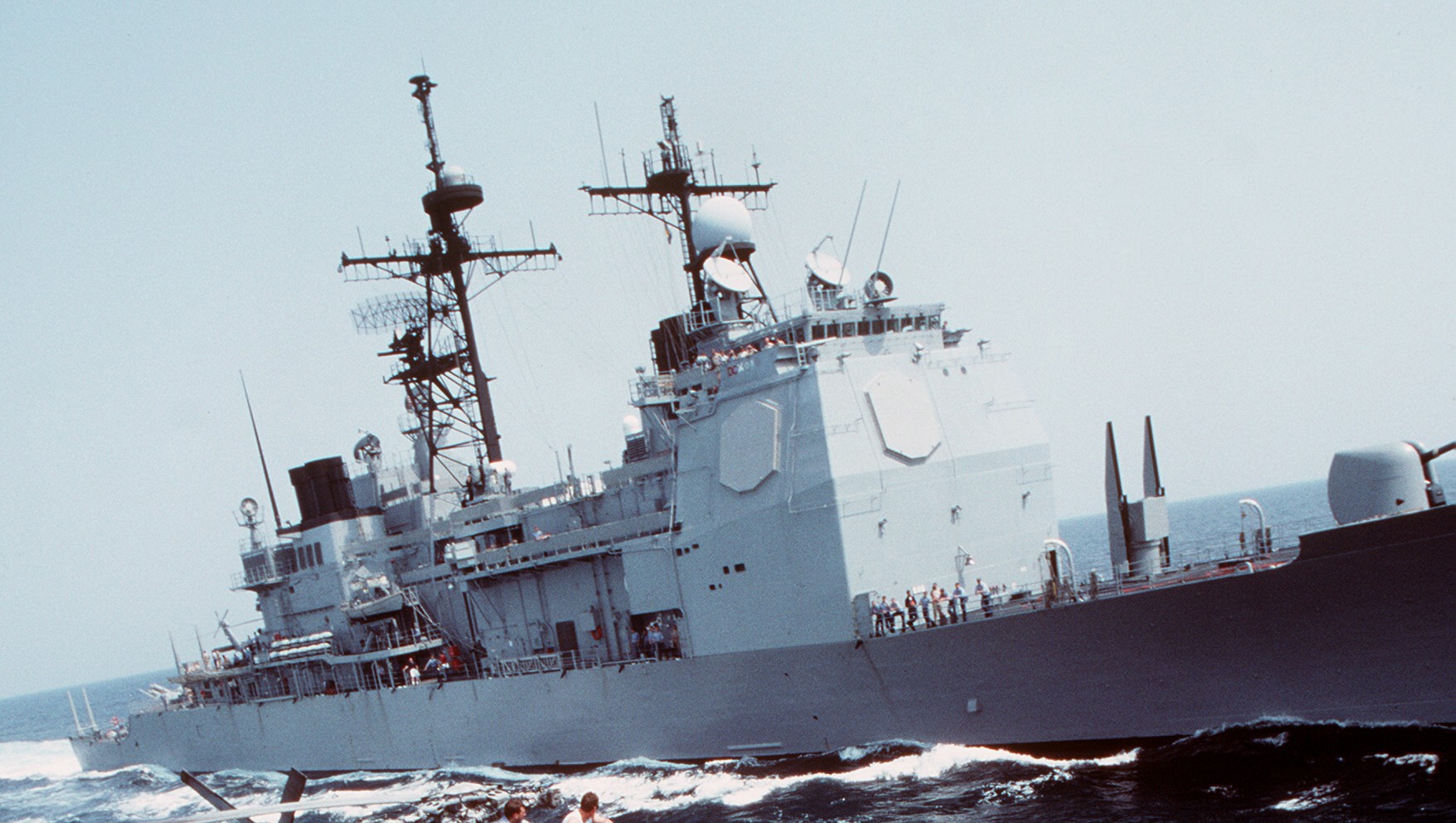 Black Sea - August 1989 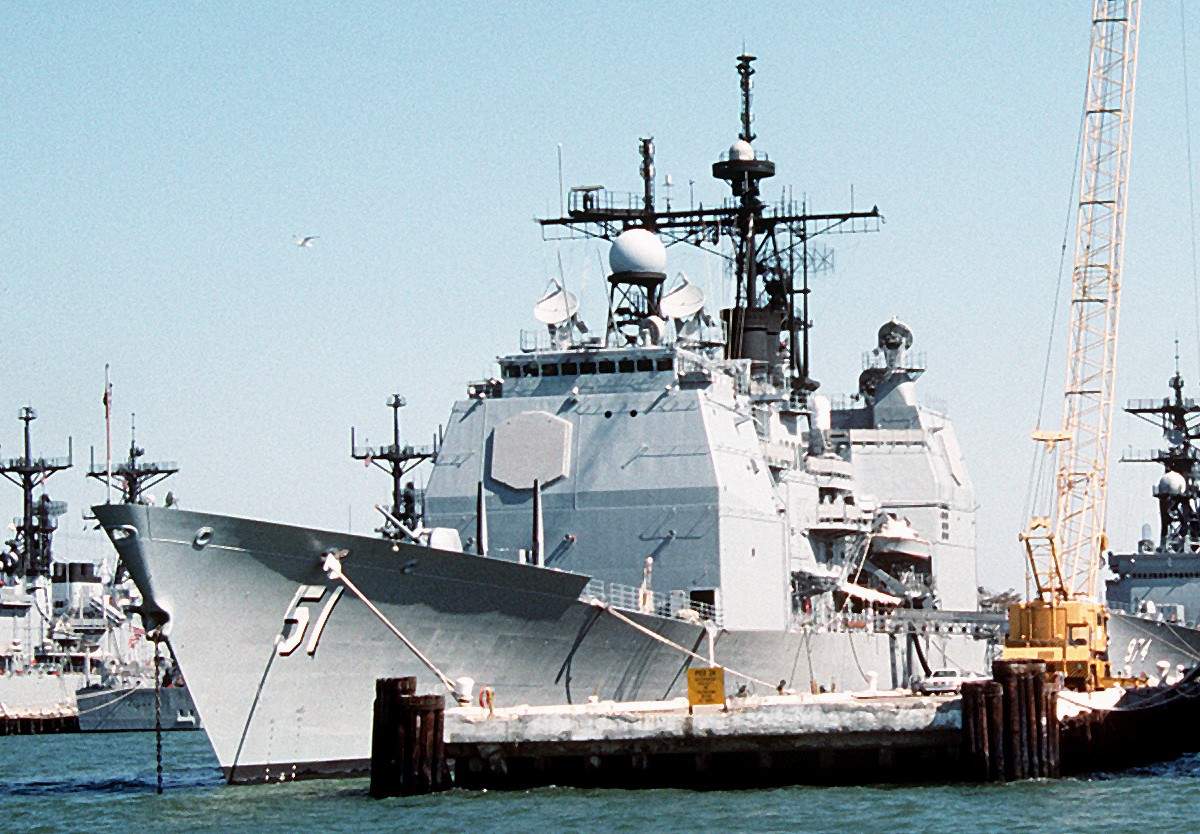 Naval Station Norfolk, Virginia - October 1988 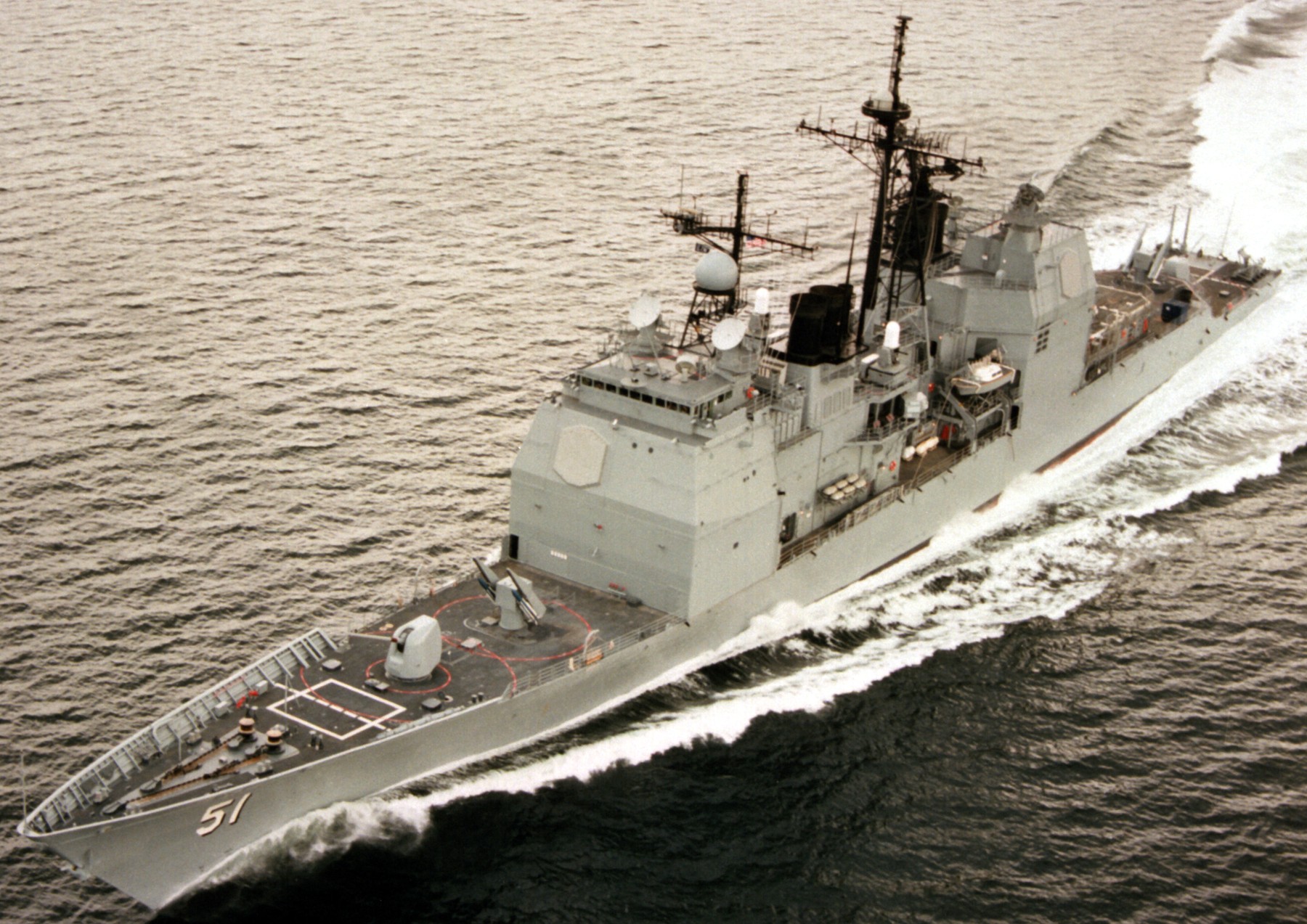 sea trials - Atlantic Ocean - 1987 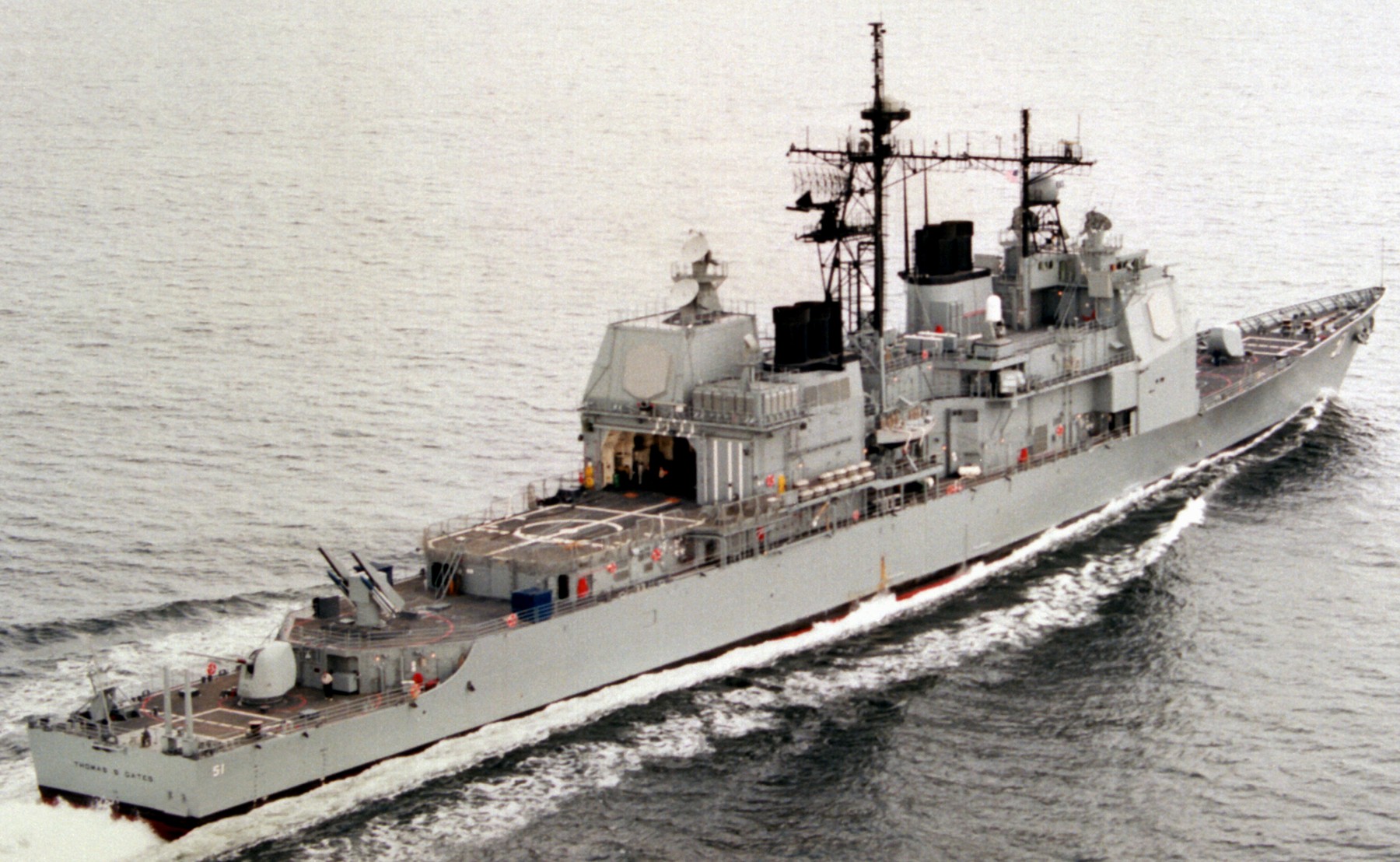 sea trials - Atlantic Ocean - 1987 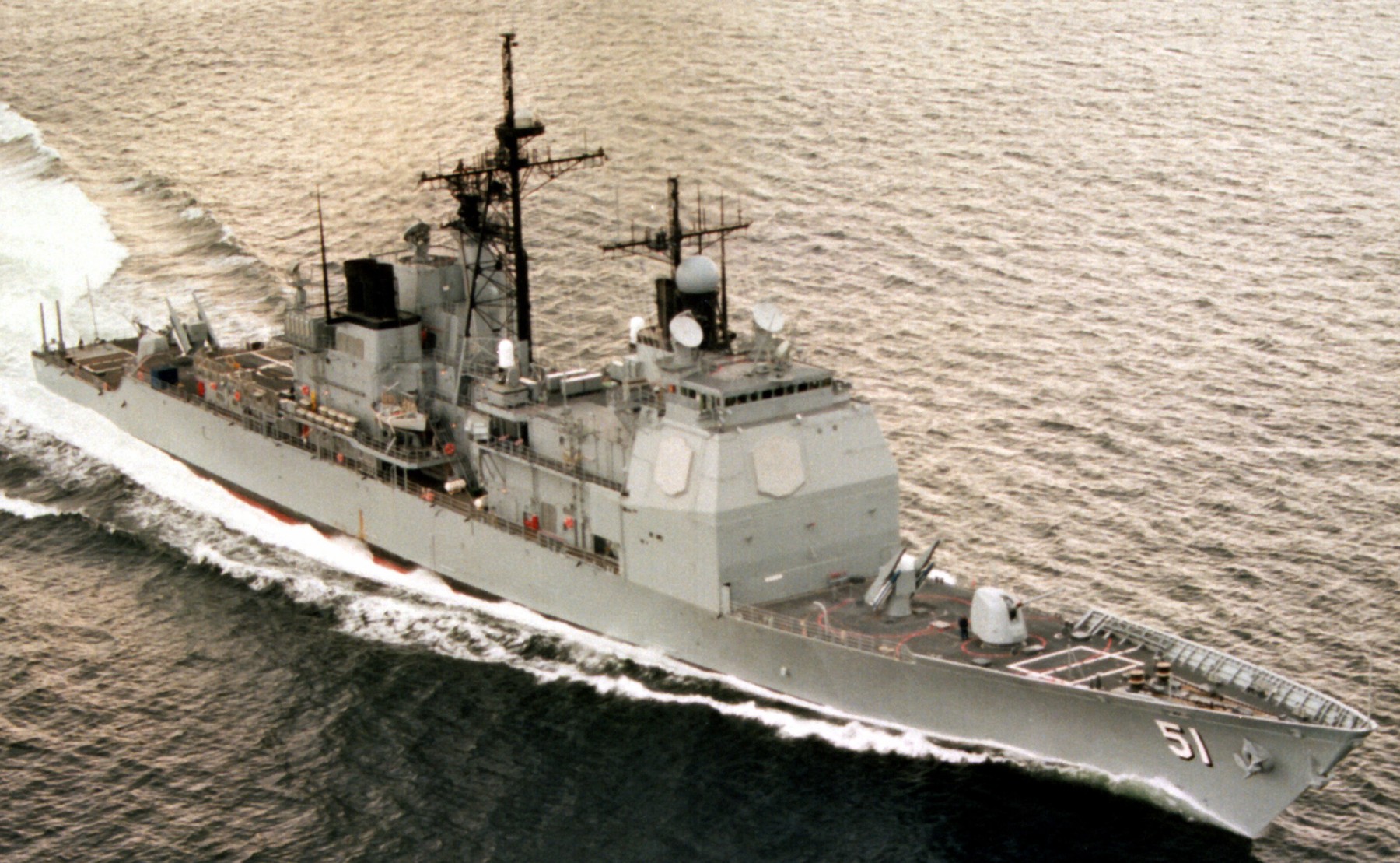 sea trials - Atlantic Ocean - 1987  sea trials - Atlantic Ocean - 1987  sea trials - Atlantic Ocean - 1987 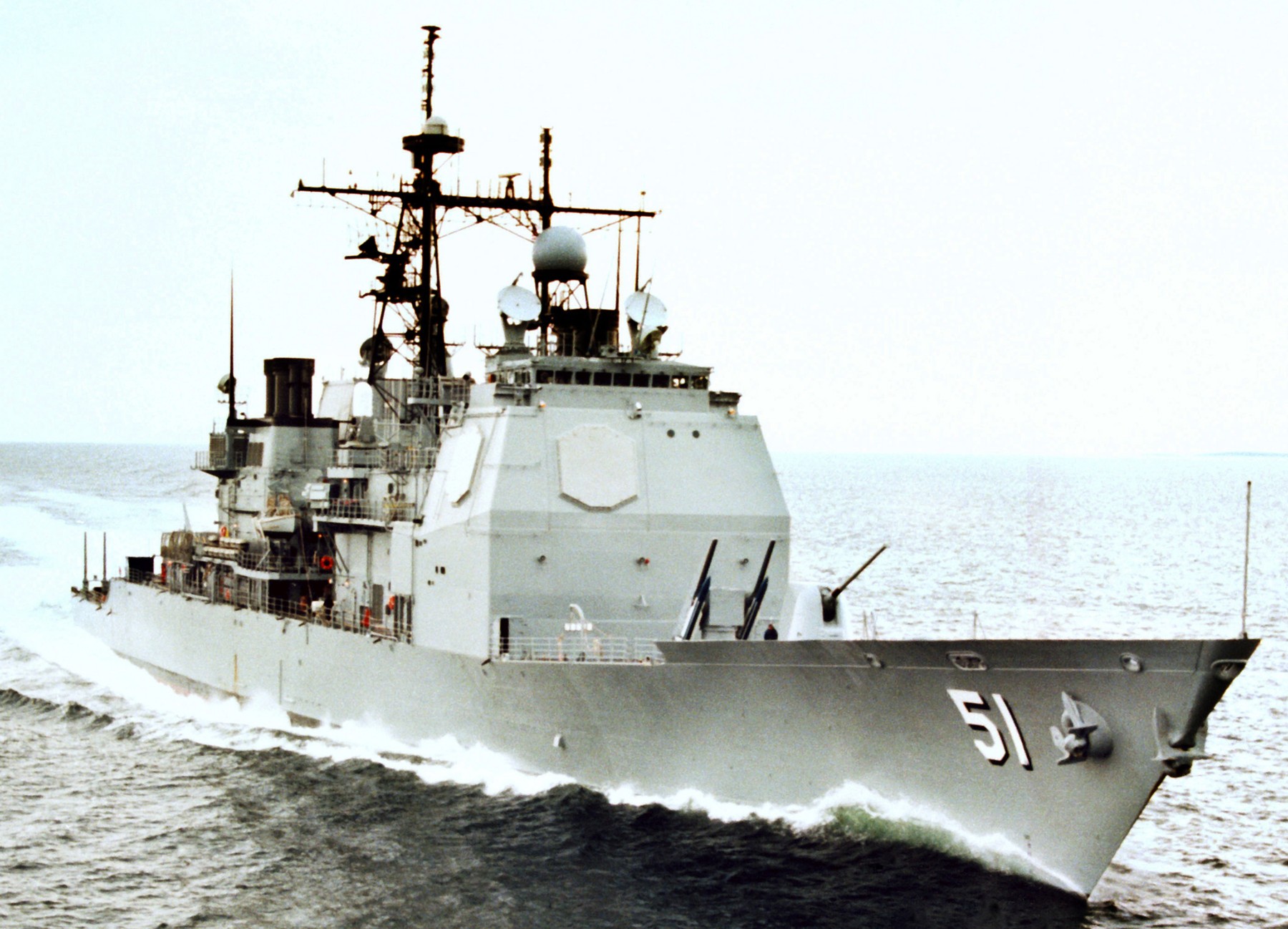 sea trials - Atlantic Ocean - 1987 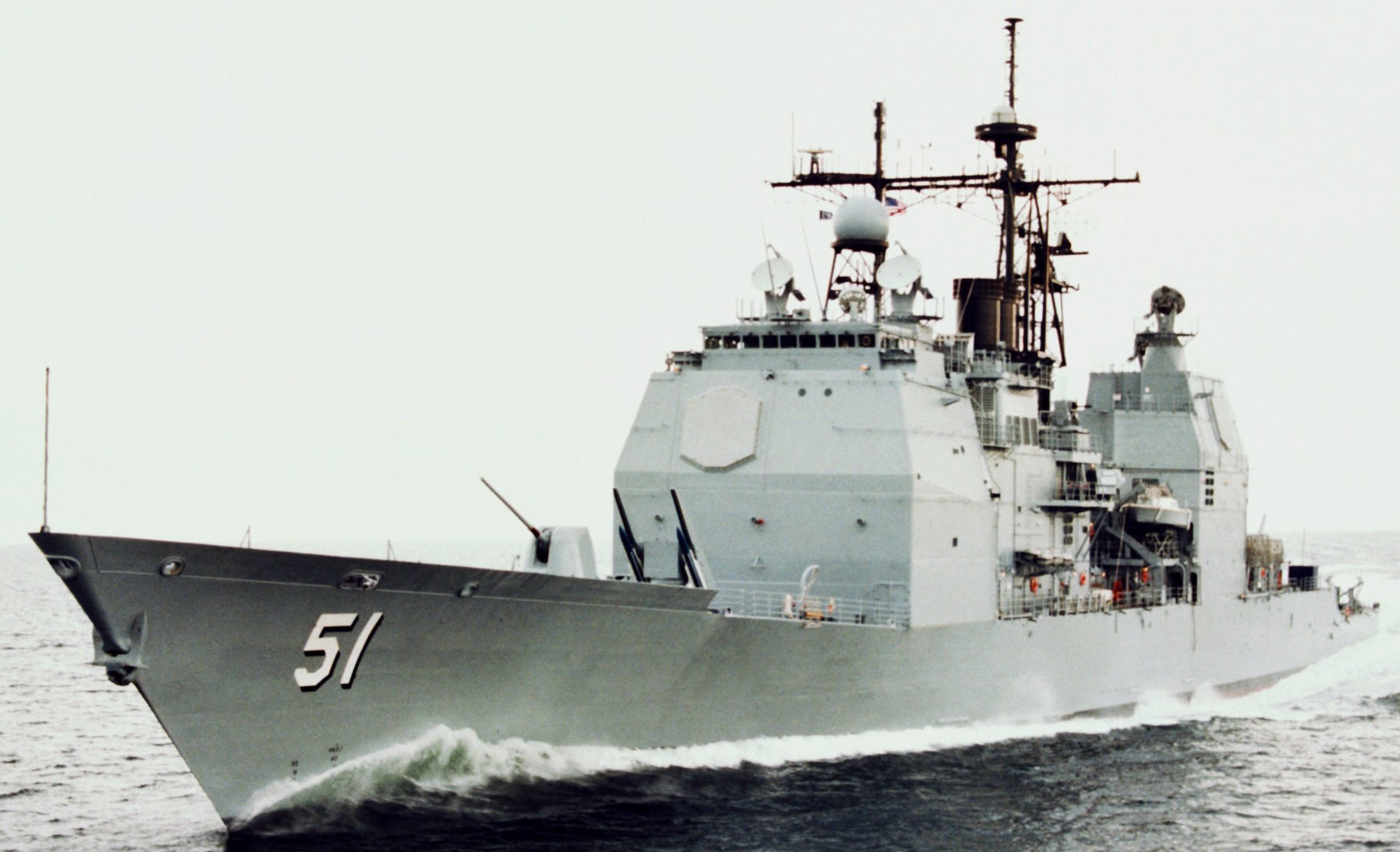 sea trials - Atlantic Ocean - 1987 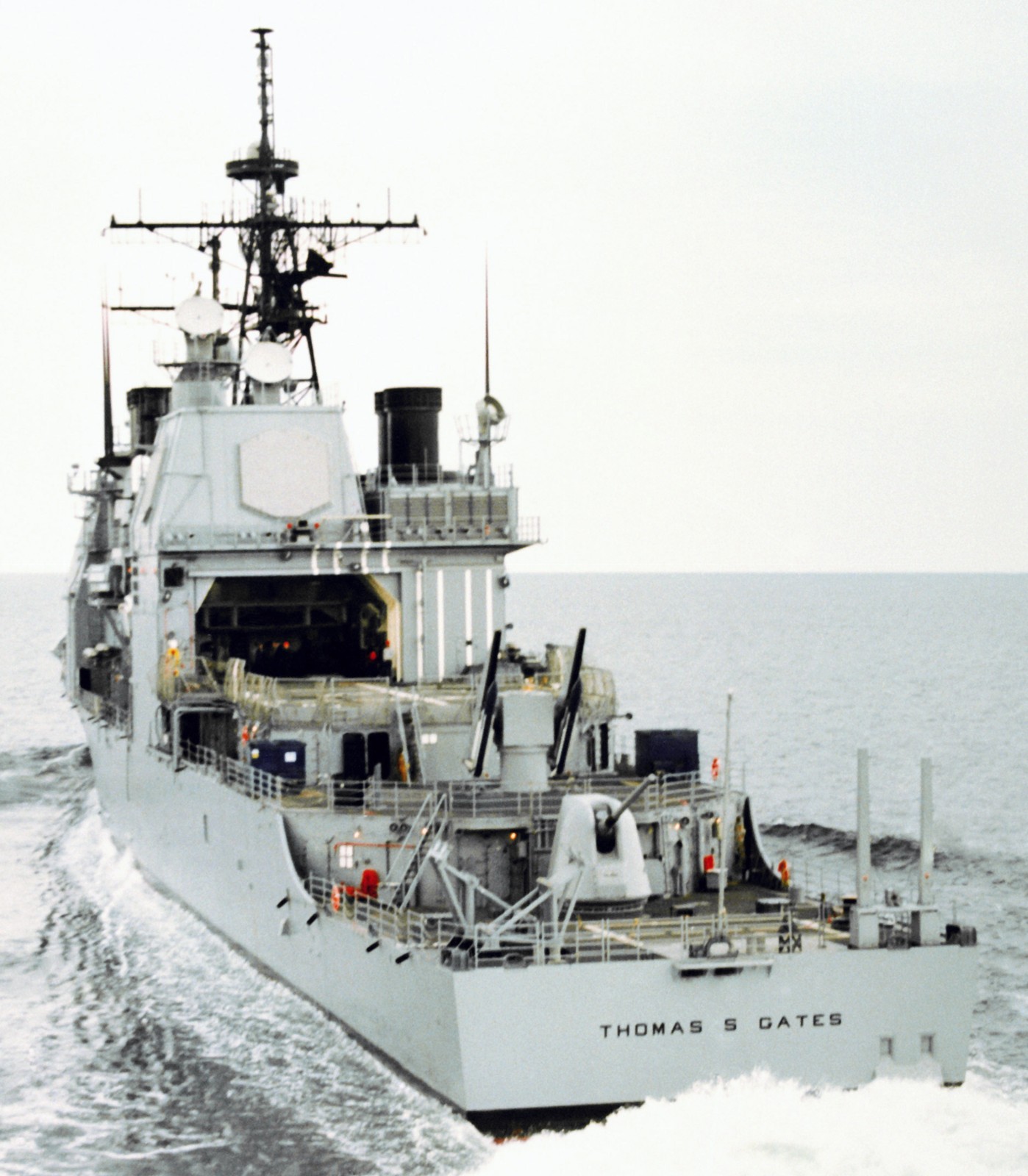 sea trials - Atlantic Ocean - 1987 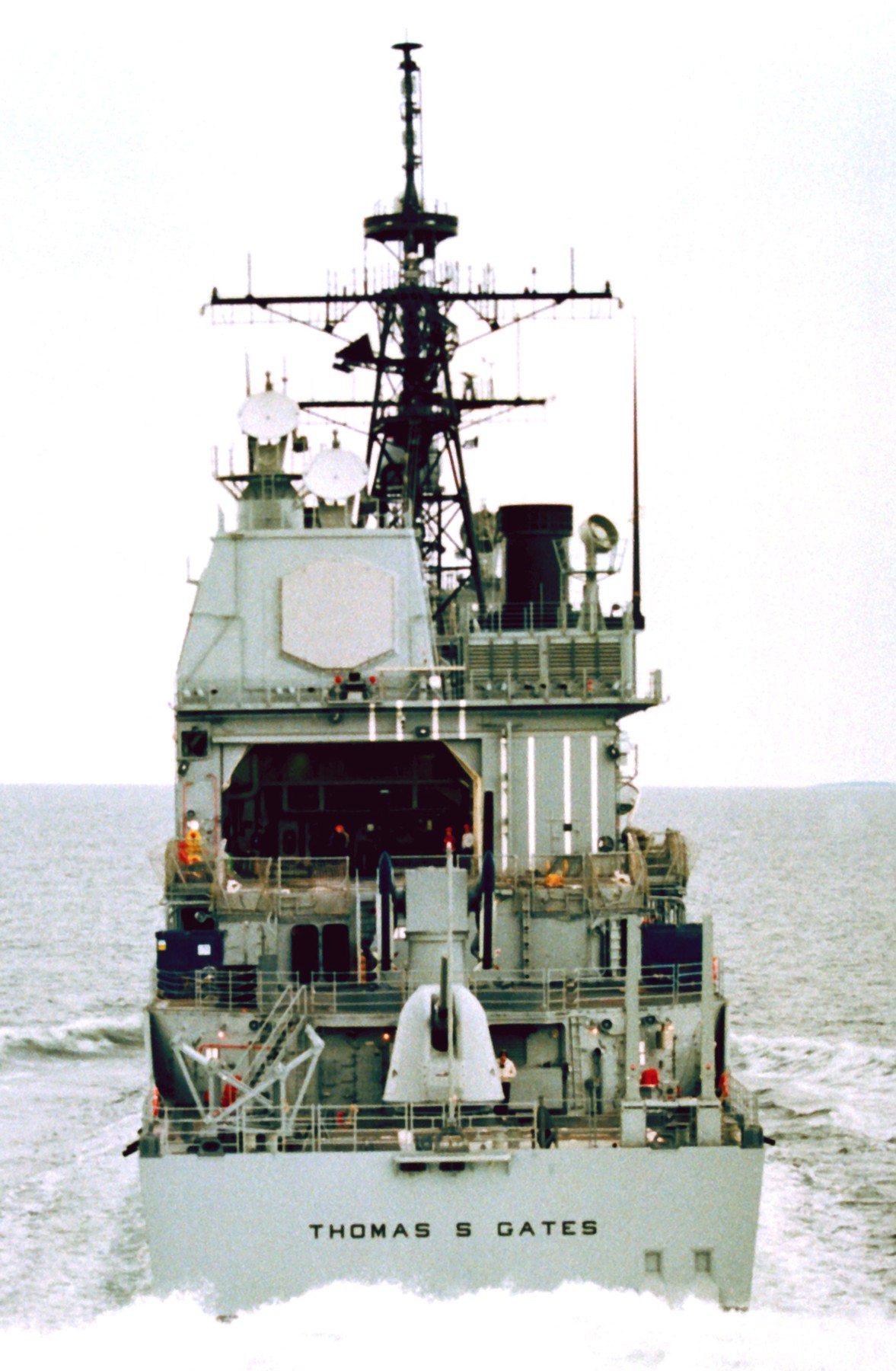 sea trials - Atlantic Ocean - 1987 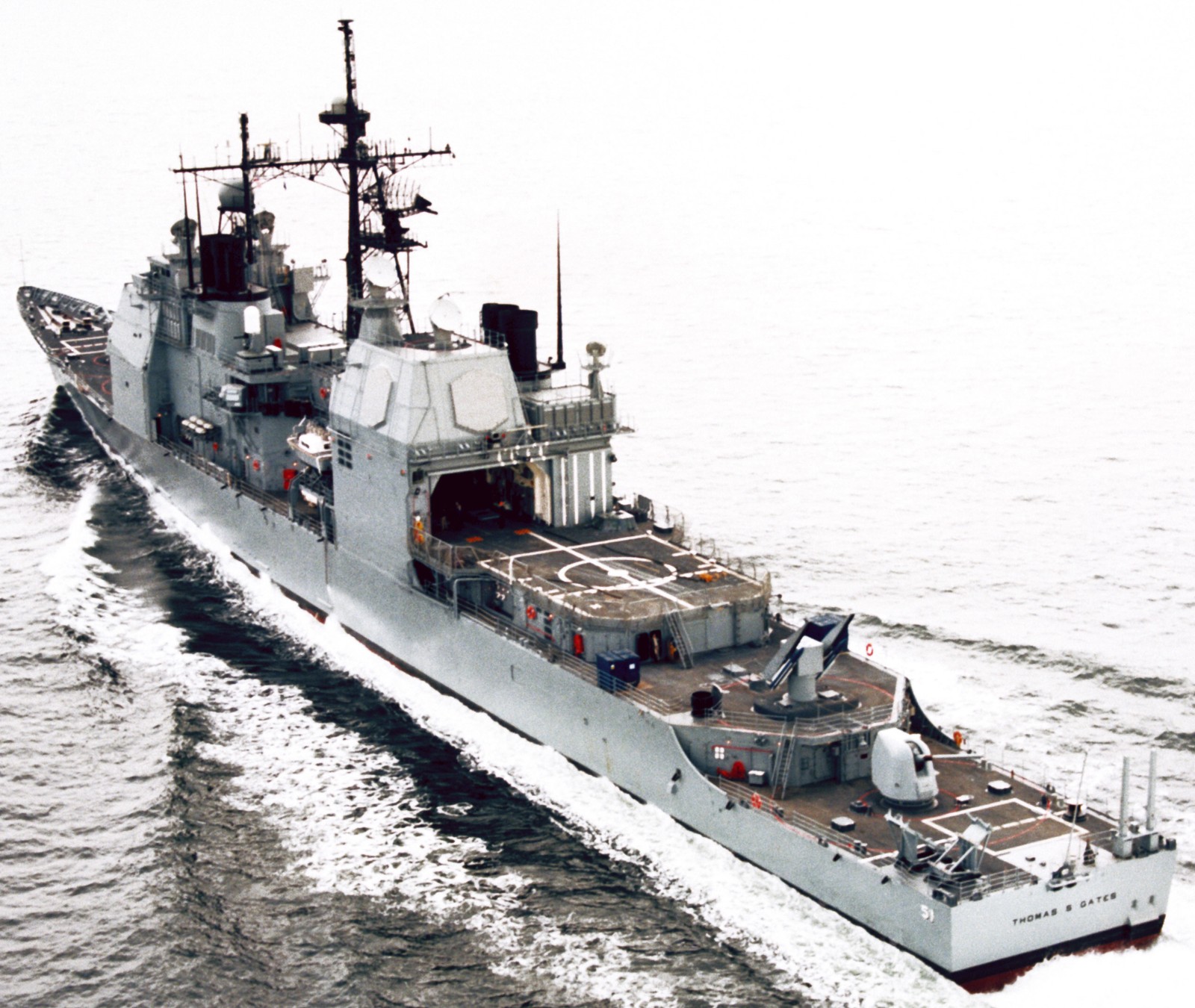 sea trials - Atlantic Ocean - 1987 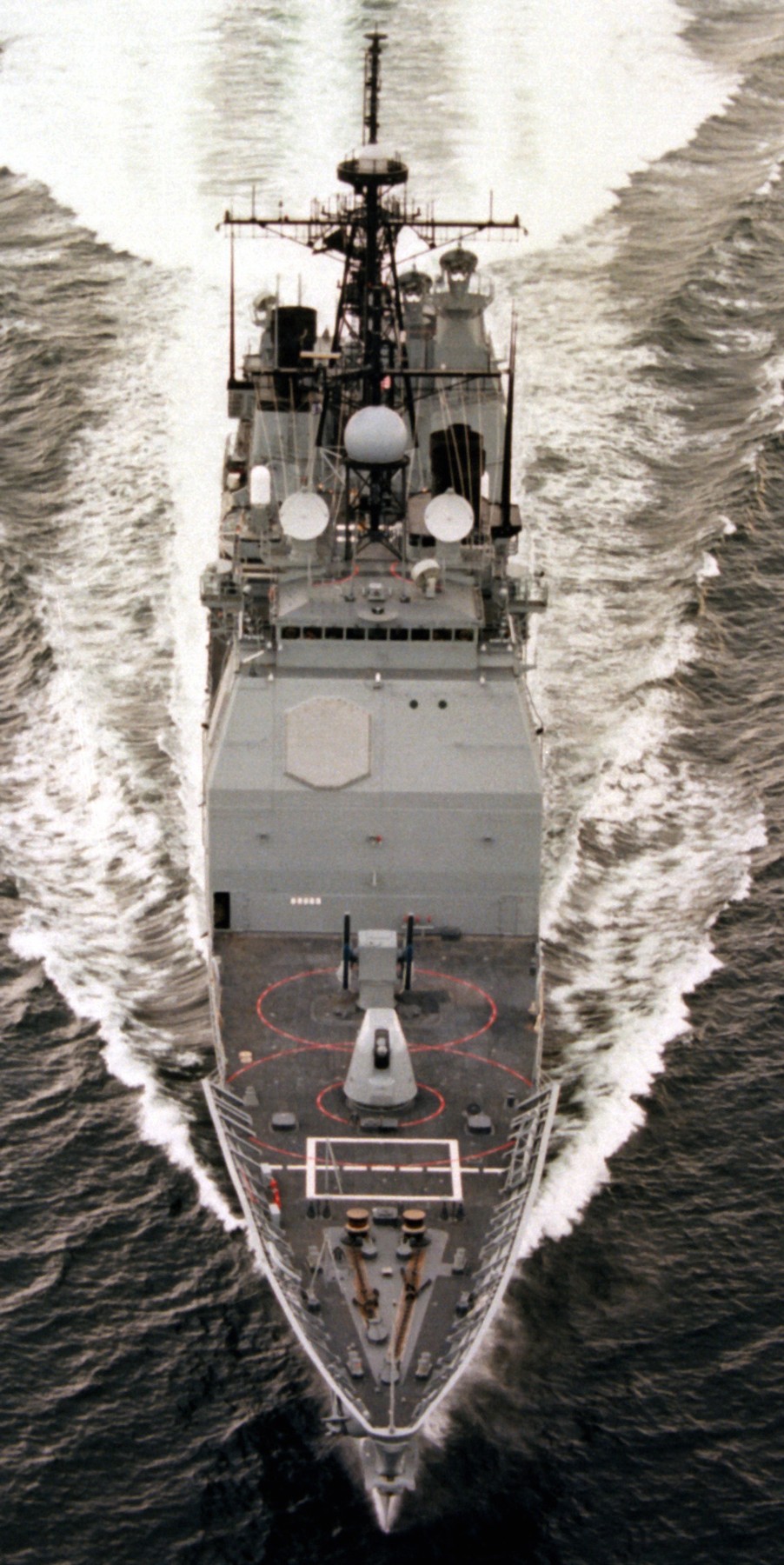 sea trials - Atlantic Ocean - 1987 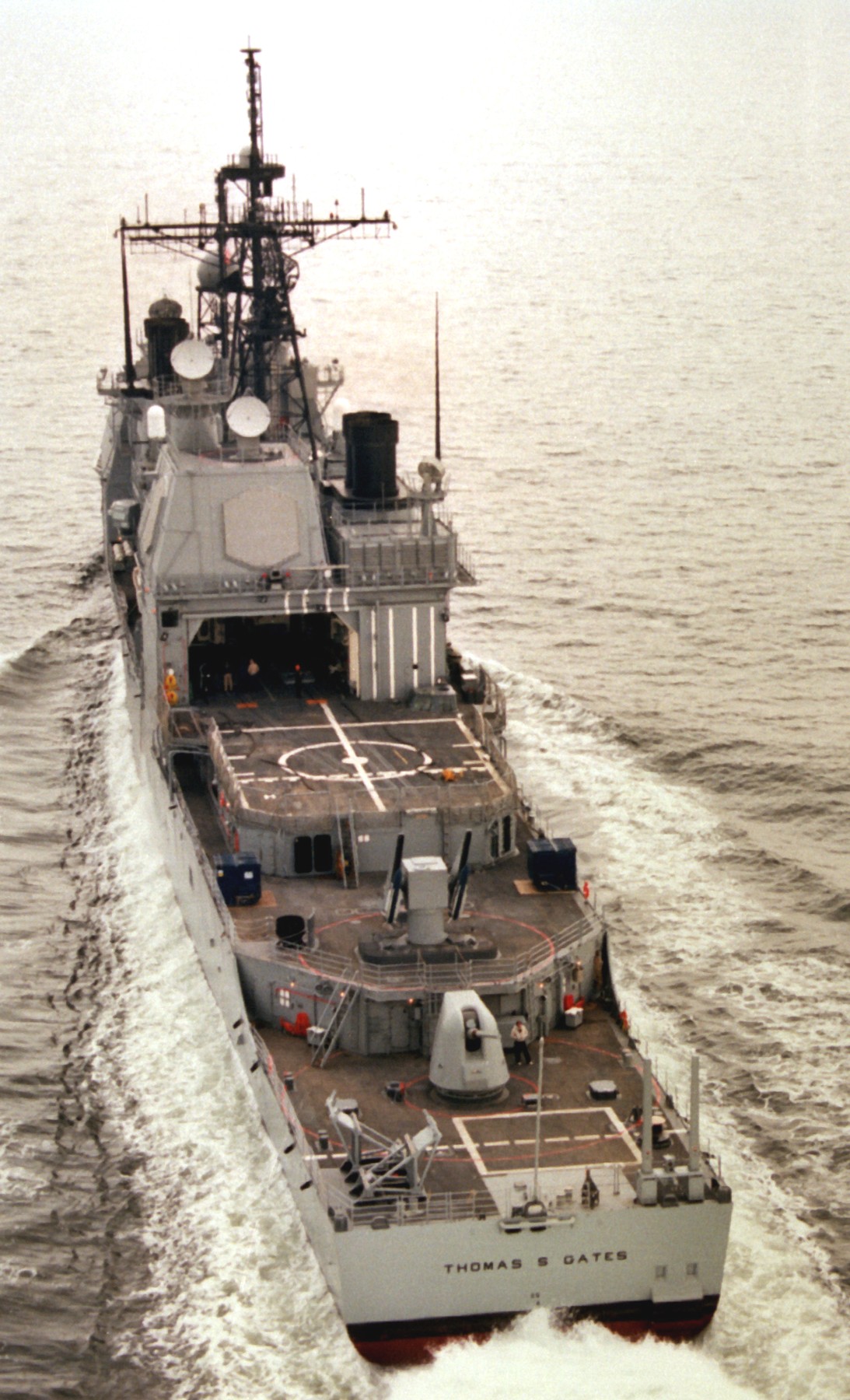 sea trials - Atlantic Ocean - 1987 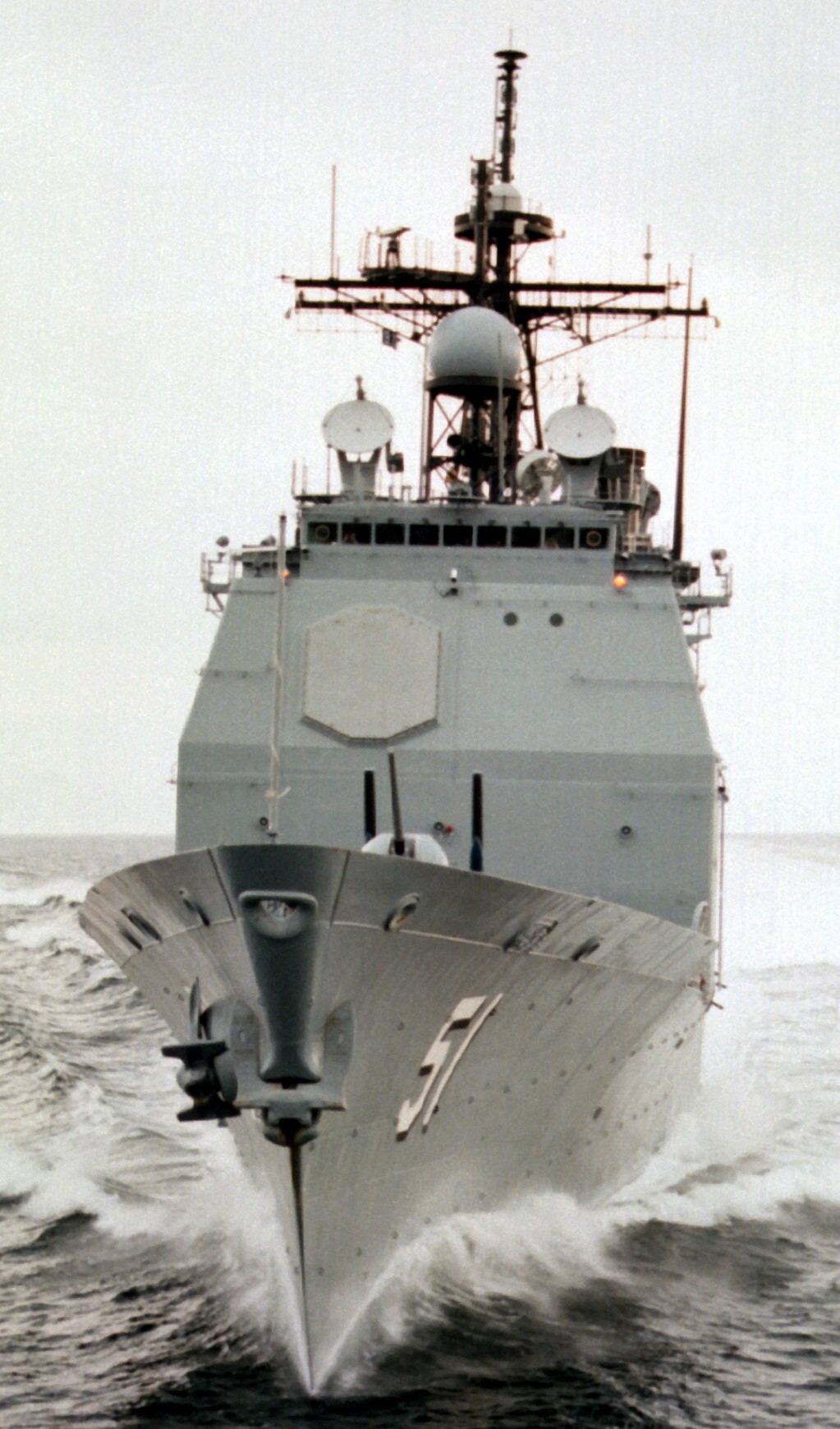 sea trials - Atlantic Ocean - 1987 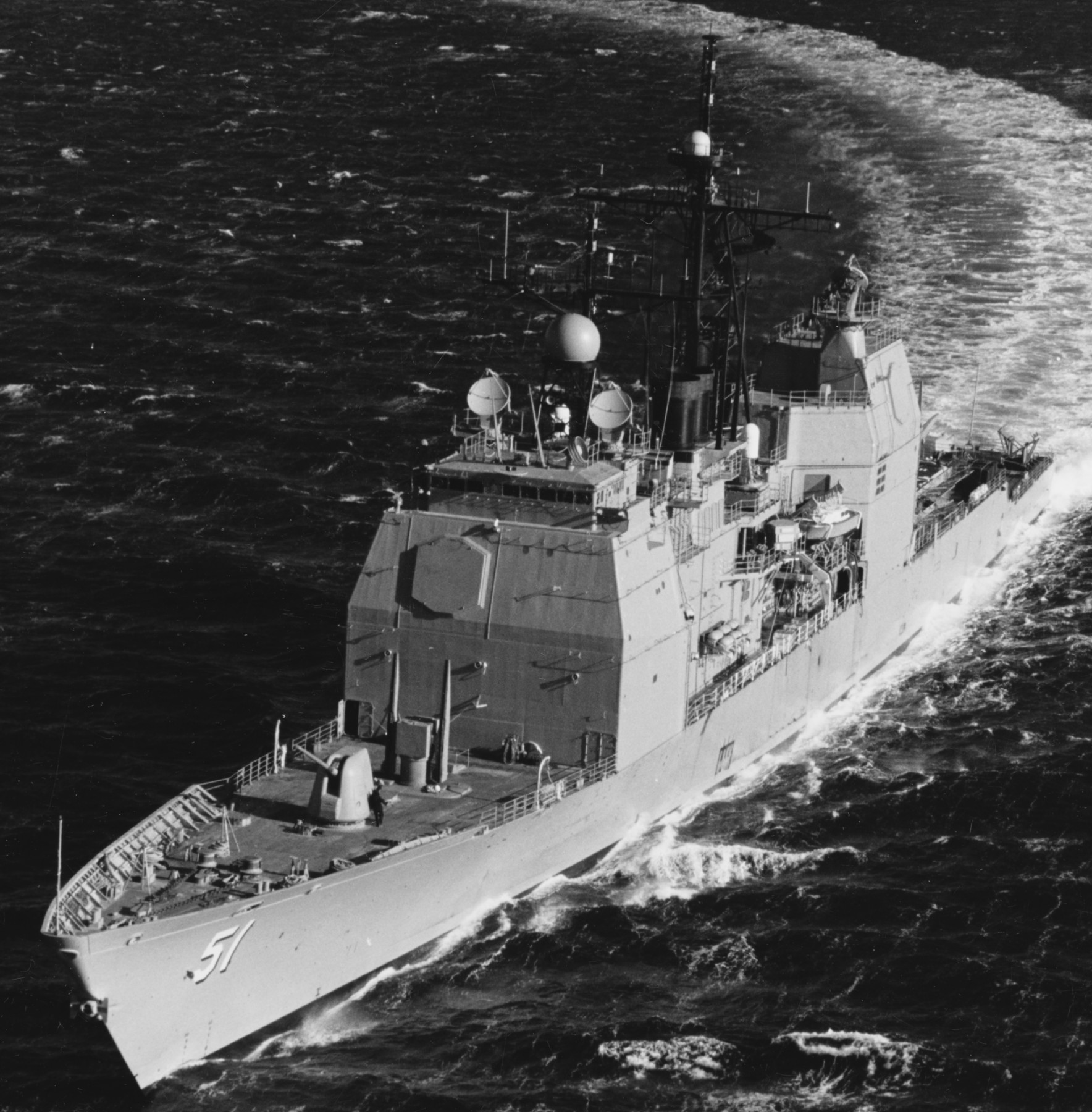 sea trials - Atlantic Ocean - 1987 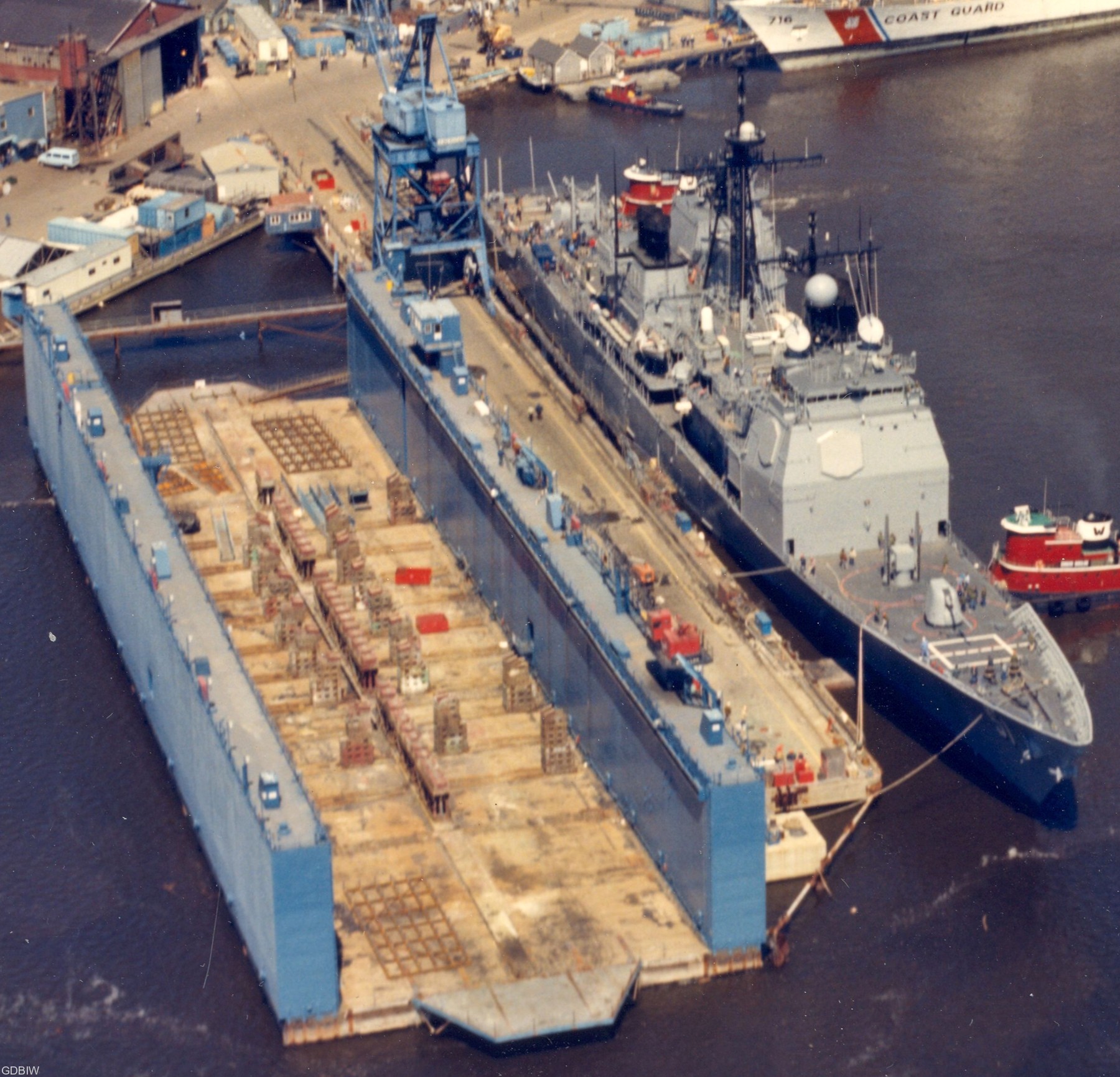 at Bath Iron Works, Maine - undated 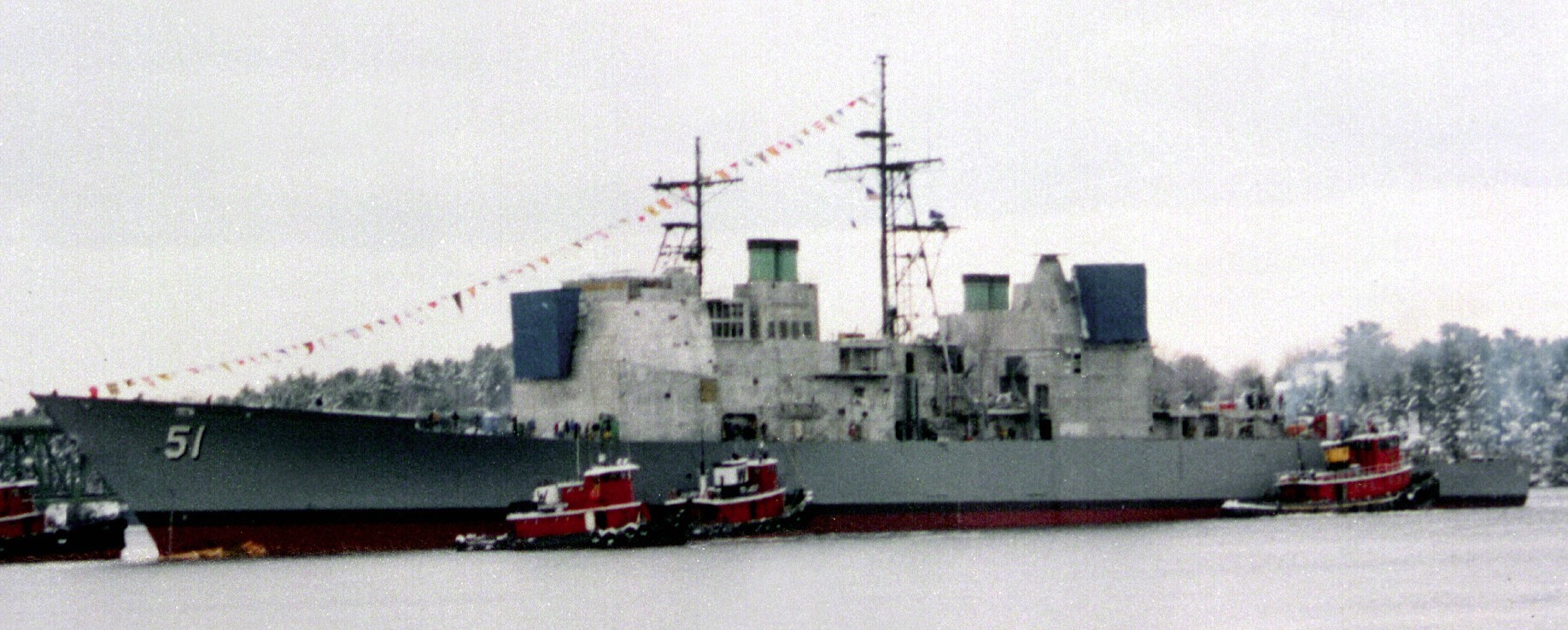 launching ceremony at Bath Iron Works, Maine - December 14, 1985 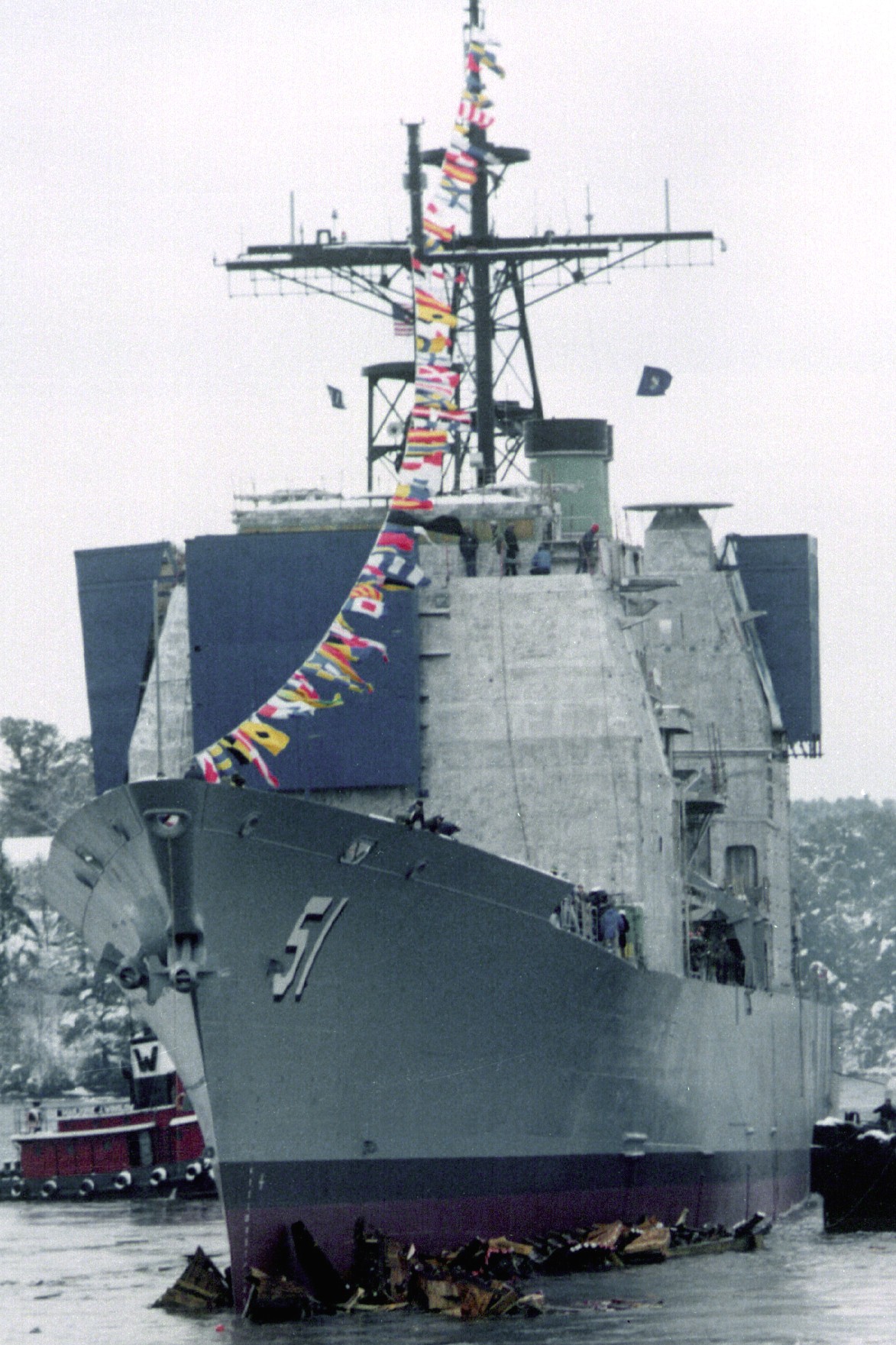 launching ceremony at Bath Iron Works, Maine - December 14, 1985 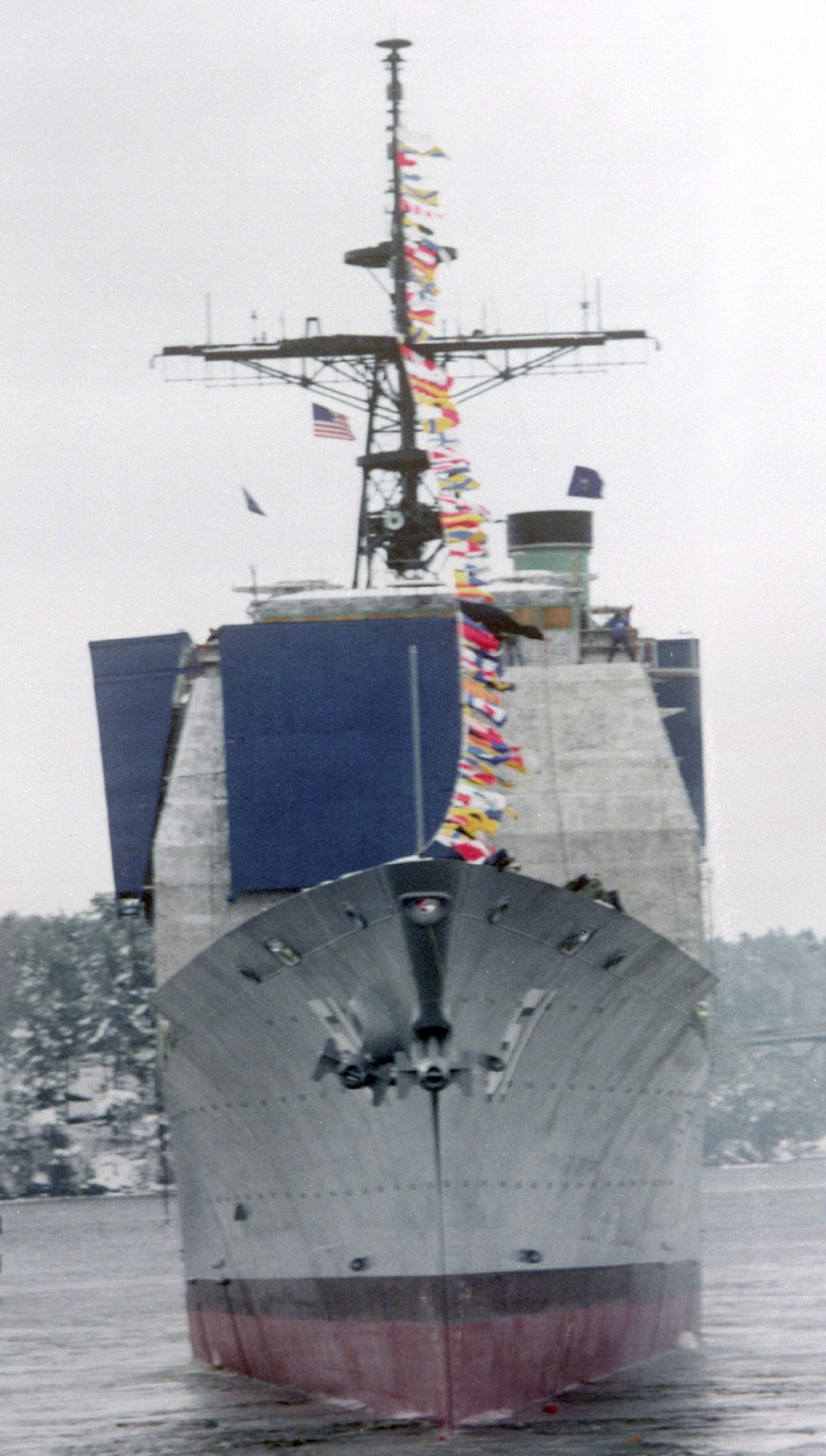 launching ceremony at Bath Iron Works, Maine - December 14, 1985  launching ceremony at Bath Iron Works, Maine - December 14, 1985 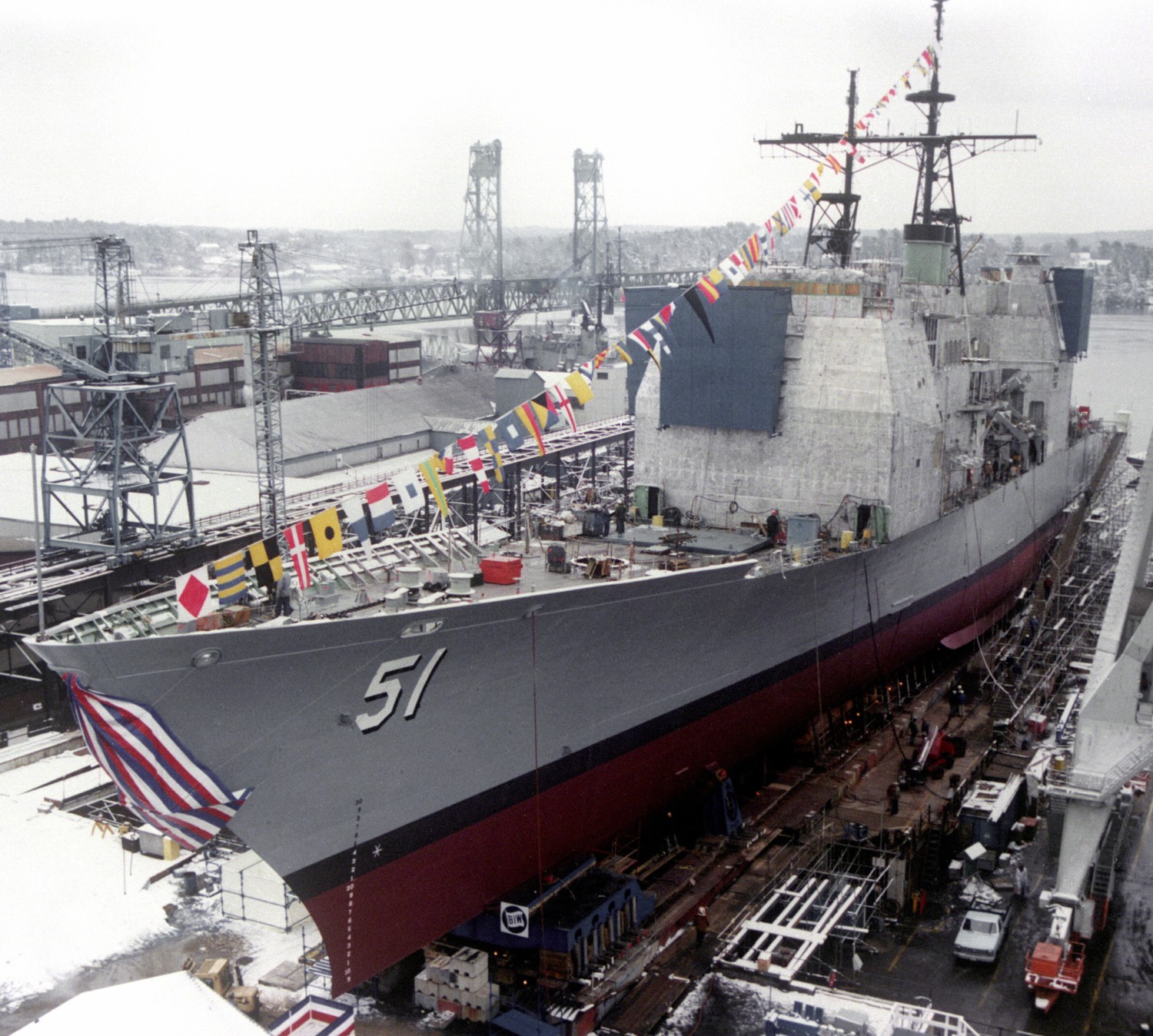 prepared for launch at Bath Iron Works, Maine - December 13, 1985 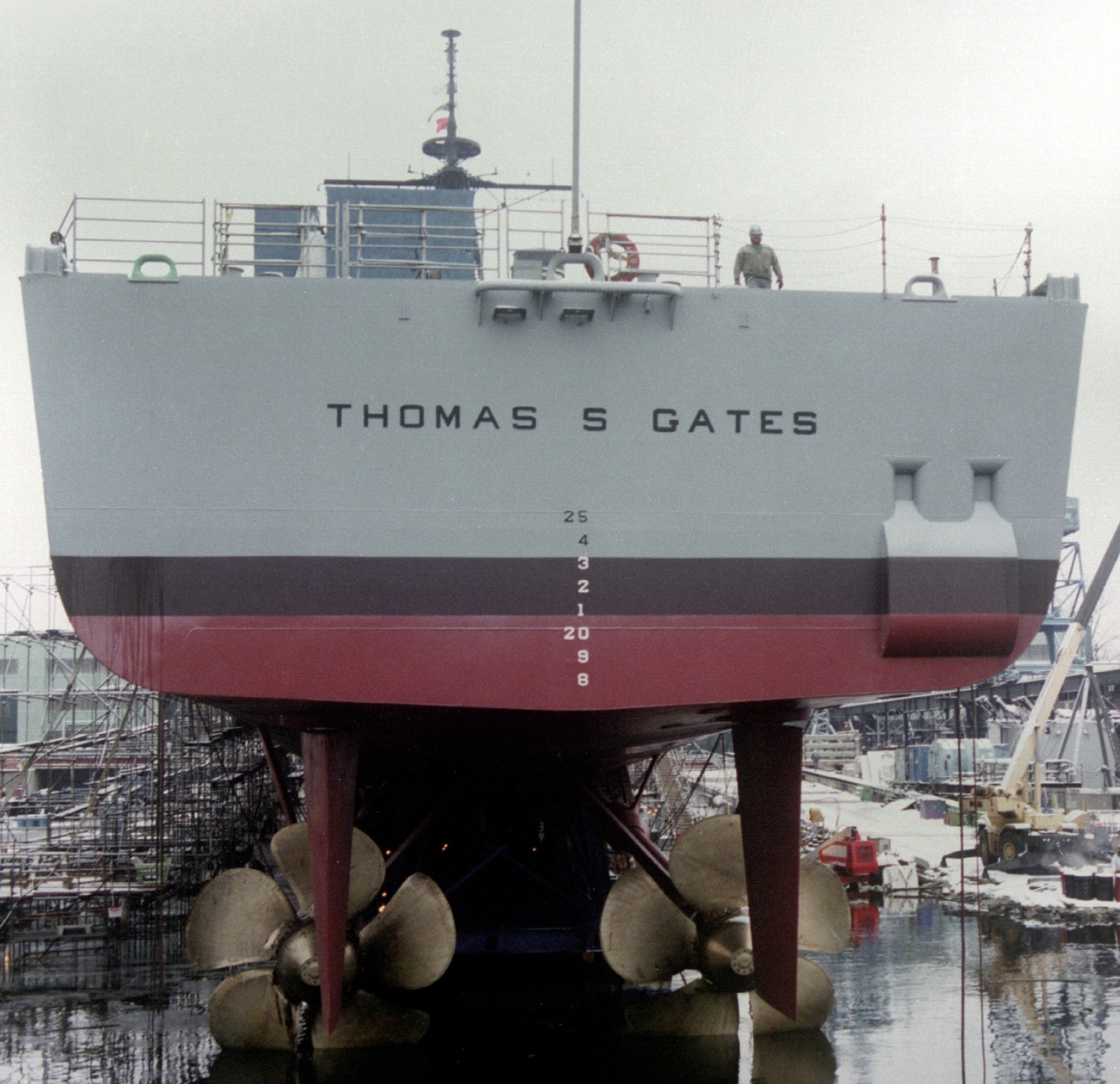 prepared for launch at Bath Iron Works, Maine - December 13, 1985 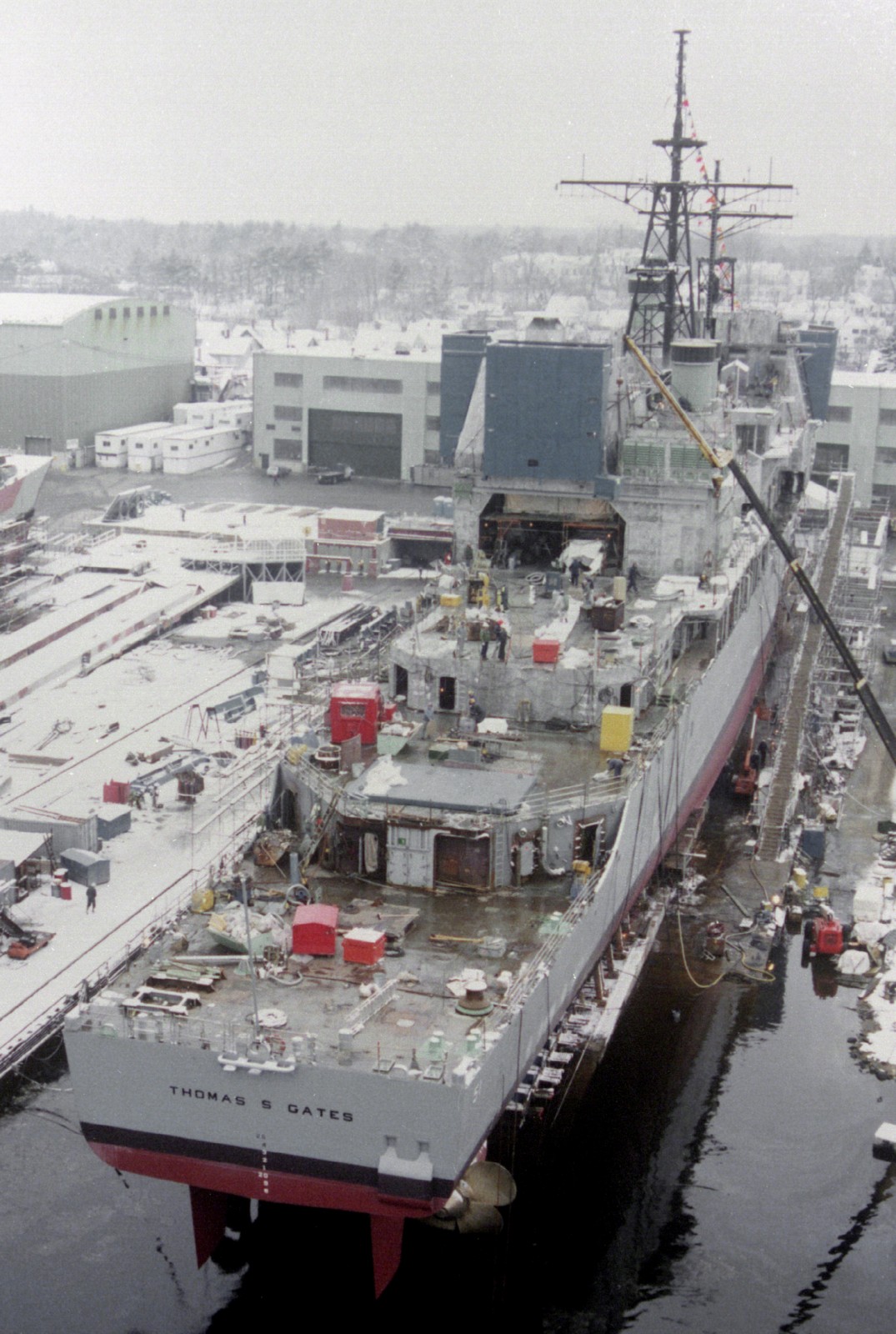 prepared for launch at Bath Iron Works, Maine - December 13, 1985 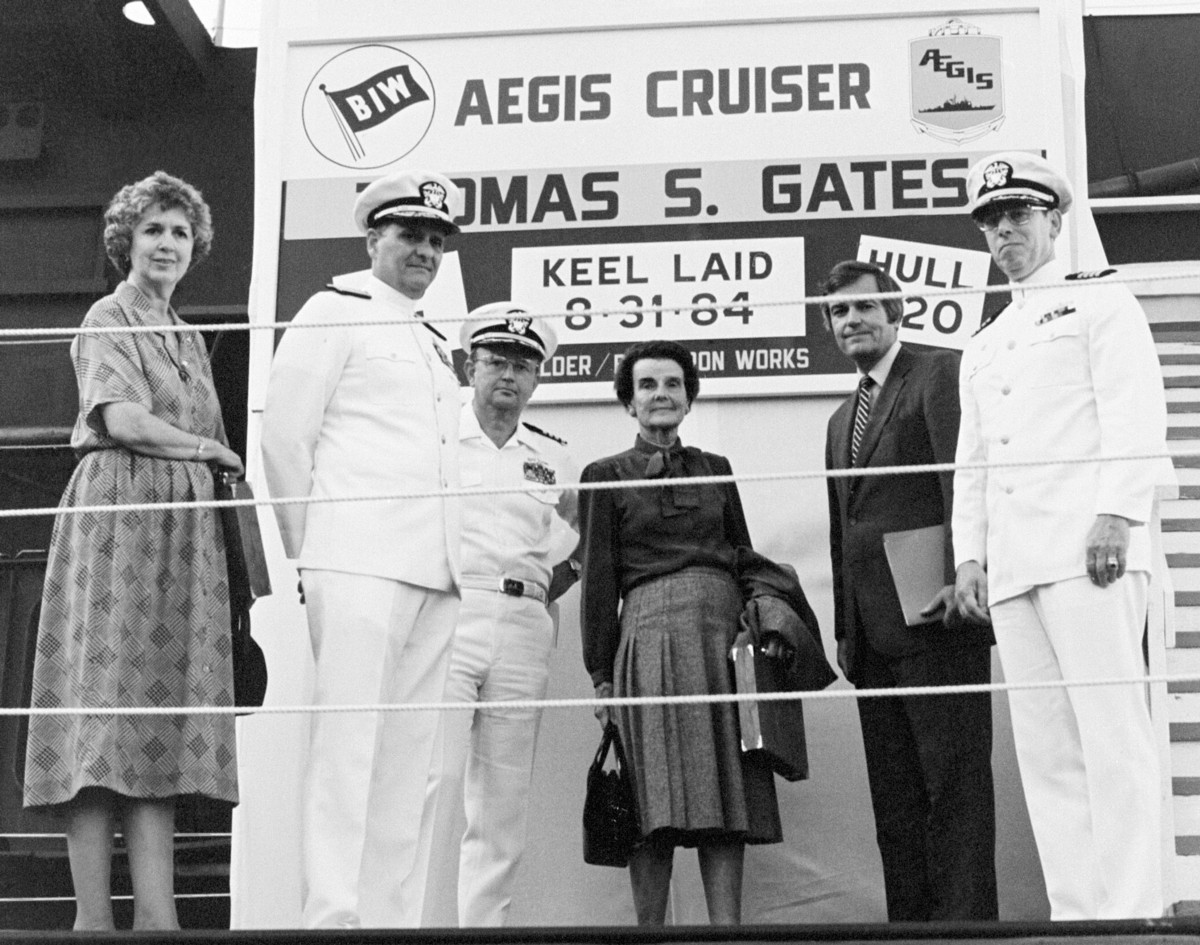 keel laying ceremony at Bath Iron Works, Maine - August 31, 1984 |
||||
|
USS Thomas S. Gates (CG 51): Chronology and Significant Events: 22 Aug 1987: Commissioned, Penn-s Landing, Philadelphia, Pennsylvania. 7 Jan 1988: Departed Norfolk for Guantanamo Bay. 10 Jan - 16 Feb 1988: Refresher Training, Guantanamo Bay. 12 Mar - 5 Jun 1988: Post shakedown Availability, Portland, Maine. 12 Jun - 1 Jul 1988: Fleet Exercise; flagship for RADM Jeremy Boorda, Commander, Cruiser Destroyer Group Eight) 15 Aug - 2 Sep 1988: During this time, Thomas S. Gates conducted independent ship exercises and type training; operated on the AUTEC range, transited to Roosevelt Roads, Puerto Rico, and underwent ANGLICO training. She also hosted Deputy Undersecretary of the Navy Seth Cropsey, and capped the period with a visit to Antigua, Netherlands Antilles. 2 - 16 Sep 1988: Intermediate Maintenance Availability (IMAV) alongside destroyer tender Shenandoah (AD-44), Norfolk, Virginia. 19 Sep 1988: While en route to Boston, conducted CNO VLS project with nuclear-powered attack submarines Providence (SSN-719) and Boston (SSN-703). 23-25 Sep 1988: Port visit to Boston, Massachusetts; Thomas S. Gates hosted 3,500 visitors. 26 Sep - 1 Oct 1988: Thomas S. Gates departed Boston for Newport, Rhode Island, on 26 September, and arrived at her destination the following day, where she served as Surface Warfare Officer School Command school ship, hosting 425 students from Engineering Officer of the Watch (EOOW), Damage Control Assistant (DCA), Surface Warfare Officer (SWO) Division Officer, Department Head, and Prospective Commanding Officer (PCO) courses between 27 September and 1 October. She departed on the latter day for Norfolk. 7 - 18 Nov 1988: Fleet Exercise (FleetEx) 1-89, upon the conclusion of which Thomas S. Gates returned to Norfolk. 28 Nov - 19 Dec 1988: Carrier escort operations, Puerto Rico Operating Area, punctuated by a port visit to St. Maarten (9-11 December). 19 Dec 1988 - 17 Jan 1989: Availability and upkeep alongside Shenandoah, Norfolk. 17 Jan - 30 Apr 1989: After conducting deck landing qualifications and type training in the Virginia capes operating area (17-21 January), Thomas S. Gates underwent a period of upkeep at Norfolk (21 January-8 February), after which time she participated in FleetEx 2-89 (Basic) with RADM Richard Macke (Commander Carrier Group 2) embarked as Composite Warfare Commander. Port visits to Port Canaveral, Florida (23-26 February) and Savannah, Georgia (14-21 March) followed, punctuated by upkeep at Norfolk (27 February-13 March). The guided missile cruiser underwent a maintenance period, followed by a Harpoon certification. She then participated in FleetEx 3-89 (Advanced) (13-30 April), after which time she prepared for her first extended deployment. 31 May 1989 - 10 Nov 1989: Maiden deployment. After transiting to the Mediterranean as part of the battle group formed around Coral Sea (CVA-43), Thomas S. Gates in-chopped to the Sixth Fleet on 10 June 1989; she participated in Operation National Week (10-19 June), conducting turnover with the guided missile cruiser Leyte Gulf (CG-55) at Augusta Bay, Sicily (15 June). After visiting Palma, Majorca (20-27 June) and Toulon, France (30 June-15 July), where she underwent an IMAV, Thomas S. Gates transited to the eastern Mediterranean (15-21 July); following a port visit to Izmir, Turkey (21-23 July), Thomas S. Gates participated in Exercise Demon Jazz 89 (24-29 July). She then visited Istanbul, Turkey (31 July-2 August), where she embarked VADM Paul Ilg, Deputy Commander in Chief U.S. Naval Forces, Europe, and then stood into the Black Sea (3-4 August). Accompanied by the guided missile frigate Kauffman (FFG-59), Thomas S. Gates visited Sevastapol, USSR, from 4-8 August, and then returned to Istanbul, where she disembarked VADM Ilg (9-10 August).- Owing to the crisis in Lebanon, which had dictated that the fleet flagship, guided missile cruiser Belknap (CG-26) not carry out her scheduled visit to Sevastapol, Thomas S. Gates then operated in support of the Coral Sea and America (CVA-66) battle groups off Beirut. Returning to Toulon, Thomas S. Gates there underwent a period of maintenance (7-13 September). After taking part in NATO Exercise Display Determination 89 (14 September- 3 October) in concert with units of the French and Turkish Navies, she conducted a period of escort operations (3-11 October) as she transited to the western Mediterranean. She then underwent a period of maintenance in Marseilles, France (11-22 October) before she participated in Exercise National Week (24-31 October), during which she conducted turnover with her relief, Yorktown (CG-48) at Pollensa Bay, Majorca (29 October). Out-chopping to Commander, 2d Fleet, on 31 October, Thomas S. Gates then conducted her return transit to Norfolk (31 October-10 November). 10 Nov 1989 - 18 Jan 1990: Following her return from her maiden extended deployment, Thomas S. Gates underwent a period of upkeep (10-19 November), followed by a maintenance period (20 November-12 December), type training (12-14 December), and further upkeep that extended into the new year (14 December 1989-17 January 1990). A -fast- cruise and embarkation of HSL-44 Detachment 9 (Magnum 455) culminated that period. 19 Jan - 2 Mar 1990: Thomas S. Gates escorted battleship Wisconsin (BB-64) to Guantanamo Bay (19-21 January), after which time she embarked a U.S. Coast Guard Law Enforcement Detachment (23 January). Embarking Caribbean Squadron staff members during an in-port period at Roosevelt Roads (25-26 January), the guided missile cruiser embarked CAPT Galen R. Siddall, USCG, Commander Caribbean Squadron (ComCaribRon) on 29 January.- Thomas S. Gates spent the last days of January and first week of February engaged in anti-drug operations, taking part in 41 boardings of vessels suspected of carrying drugs. Following a port visit to Curacao, Netherlands Antilles (CAPT Siddall disembarking on 9 February), the guided missile cruiser conducted high-intensity operations (as Task Unit 44.7.3) until 25 February, when she reached Port Everglades to begin a three-day port visit (25-27 February), after which time she got underway to return to her home port. 3 - 21 Jun 1990: Thomas S. Gates underwent upkeep upon her return to Norfolk (3-4 March), after which point she received an IMAV there (5-23 March). Following a combat systems assessment off the Virginia capes (28-29 March), the guided missile cruiser served as engineering school ship out of Newport (30 March - 4 April). The ship visited New York City (6-8 April), then offloaded ammunition at Earle, N.J. (9-10 April); Thomas S. Gates then underwent upkeep (13-15 April), after which time she underwent a concurrent restricted availability and IMAV (16 April-15 June), followed by further upkeep (16-17 June) and sea trials off the Virginia capes (18 June). 22 Jun - 14 Aug 1990: Thomas S. Gates operated out of Norfolk during this time, conducting midshipman training (26-29 June; 10-13 and 24-27 July), interspersed with upkeep, and (20 July) embarkation of HSL-44, Detachment 9 (Magnum 447), punctuated with a transit to the waters off Puerto Rico (28-29 July) and operations there, conducting naval gunfire support services and qualifications off Vieques (30 July-3 August) and antisubmarine warfare operations with the submarine John Marshall (SSN-611) (4-6 August), followed by the transit to Norfolk (7-9 August),- upon return from which she received word (10 August) of her impending deployment to the Middle East in the wake of Iraq-s invasion of neighboring Kuwait (2 August). Despite her imminent departure, Thomas S. Gates hosted 2,800 visitors as the Norfolk Naval Station-s -Visit Ship- (11-12 August), after which time, during continued preparations for sea, she underwent a communications security management inspection (13-14 August). 15 Aug 1990 - 28 Mar 1991: Following that relatively short period (five days!) of intensive preparations, Thomas S. Gates deployed as an element of the battle group (RADM Riley D. Mixson) formed around the aircraft carrier John F. Kennedy (CV-67) to participate in Operation Desert Shield. The group exercised at sea (16-21 August), then began its voyage toward the Mediterranean (22 August), transiting the Strait of Gibraltar on 30 August to become Task Force (TF) 60. On 1 September, the ship experienced a gas turbine casualty while transiting the western Mediterranean that compelled her to put in to Augusta Bay, Sicily, for an engine changeout (3-11 September), after which time she rejoined TF-60 (13 September) off Port Said, Egypt. Thomas S. Gates began her maiden transit of the Suez Canal (14 September), leading the battle group on its passage through that historic waterway. Becoming part of Task Group (TG) 150.5 (15 September) upon entering the Red Sea, the guided missile cruiser rode -shotgun- for John F. Kennedy and operated as anti-air warfare commander (16 September-14 October) before being detached from the carrier on 15 October. With a USCG detachment embarked, Thomas S. Gates transited the Strait of Tiran, at the mouth of the Gulf of Aqaba, and conducted maritime interdiction operations to enforce United Nations-enforced sanctions against the ingress of Iraqi goods (15-19 October); the boarding operations conducted during this time -putting to good use skills developed in February in the Caribbean Sea-- The ship then visited Hurghada, Egypt (20-23 October), after which time she served as -Gate Guard- in the Gulf of Suez, screening all shipping traffic. TG 150.5 became TF-60 on 26 October, and on the 27th transited the Suez Canal. Between 28 October and 11 December, Thomas S. Gates operated in the central and eastern Mediterranean, evolutions punctuated by port visits to Naples (31 October-2 November), Izmir, Turkey (7-13 November), and Haifa, Israel (16-17 November), and an IMAV alongside destroyer tender Yellowstone (AD-41) at Suda Bay, Crete (29 November-5 December). Transiting the Suez Canal on 9 December, the guided missile cruiser returned to the Red Sea, in-chopping to CTG 150.5 the following day. Thomas S. Gates then conducted maritime interdiction operations in the Strait of Tiran (10-14 December), completing her 37th boarding of the deployment on the latter date (14 December). Between 15 and 28 December, the ship rode shotgun for John F. Kennedy and served as anti air warfare commander, participating in three exercises with Royal Air Force units (20, 23, and 26 December) during that time.- She put in to Jeddah, Saudi Arabia, on 29 December in company with John F. Kennedy, where Vice President Dan Quayle addressed the crews of both ships on New Year-s Day 1991. Between 3 and 16 January, Thomas S. Gates conducted Desert Shield operations in the Red Sea, punctuating that period exercising the Royal Saudi Navy in an antisubmarine warfare exercise, Operation Camelot 91 (3-7 January). Iraq-s ignoring the UN-imposed deadline (16 January) for withdrawing from Kuwait, however, changed the complexion of events in the region, and Operation Desert Storm soon got underway early the following day (17 January). Over the ensuing weeks (17 January-13 February), Thomas S. Gates, as Red Crown (Inter Anti Aircraft Warfare Defense Zone Coordinator) coordinated the departures and returns of air strikes from John F. Kennedy, Saratoga (CV-60) and America (CV-66), -ensuring that all friendly aircraft returned safely through the air defense net while preventing any possible raid-following Iraqi aircraft getting through.-- Following a visit to Hurghada (14-18 February), Thomas S. Gates operated once more in the Red Sea (19 February-1 March), during which time (24 February) the ground war began in Iraq and Kuwait. Following the cease-fire (28 February), the ship conducted a brief period of maritime interdiction operations in the Gulf of Aqaba. Following an in-port period at Jeddah (2-10 March), where she underwent an IMAV alongside the destroyer tender Puget Sound (AD-38), Thomas S. Gates transited the Suez Canal (12 March). She then conducted anti submarine warfare exercises in the central Mediterranean (15-17 March), after which she transited the Strait of Gibraltar (18 March), headed for Norfolk, returning to her homeport on 28 March. 29 Mar - 28 Jul 1991: Thomas S. Gates alternated periods of upkeep out of Norfolk with an IMAV (1-10 May), a combat systems assessment rehearsal in the Virginia capes operating area (15-17 May), operations in the Puerto Rican operating area (29 May-11 June), a visit to Port Everglades (7-9 June), a combat systems assist visit (18-20 June) off the Virginia capes, and INSURV rehearsal (9 July) and an INSURV inspection (15-19 July) in those same waters. 29 Jul - 30 Aug 1991: Thomas S. Gates sailed from Norfolk (29 July) for the Caribbean. Pausing at Roosevelt Roads (2 August), she embarked RADM James A. Lair (Commander, TG 4.1) Commander, Carrier Group 2, and CAPT Grant W. Risinger, USCG, ComCaribRon; she conducted energetic counter-narcotics operations for the balance of the month, underway periods punctuated by port visits to Curacao (10 August) and La Guaira, Venezuela (19-21 August). Disembarking ComCarGru 2 and ComCaribRon at Roosevelt Roads on 26 August, the ship conducted missile exercises the following day (27 August), and then made the transit to Norfolk- (28-30 August). 31 Aug 1991 - 5 May 1992 : During this period, Thomas S. Gates alternated periods of upkeep and maintenance at Norfolk with local operations and training, highlighted by her participation in short-notice exercises Fast Break 01 (19-20 September) and Fast Break 03 (4-6 December 1991) off the Virginia capes, and FleetEx 2-92 (13 January-13 February 1992). During the latter period, she served as flagship for RADM P. A. Dur, Commander, Cruiser Destroyer Group 8 (17-26 January), embarking him at Roosevelt Roads (17 January). Operating in Puerto Rican waters, Thomas S. Gates conducted a missile-firing exercise (18 January), naval gunfire support qualifications at Vieques (19 January) and an ASW weapons firing evolution on the St. Croix range (20 January), capping that period with battle group operations (21-23 January), after which the ship visited Port Everglades (24-26 January), where she disembarked RADM Dur. The ship then returned to Puerto Rican waters for a combat systems assessment (27-28 January), then conducted a second stint of battle group exercises (29 January-13 February) that culminated with her return to Norfolk. Following a period of upkeep, Thomas S. Gates then participated in a multi-national exercise, Fabric Falcon Brave, off the Bay of Fundy (26 February-4 March) and another Fast Break evolution (25-26 March) off the Virginia capes. She spent the remainder of this period engaged in upkeep at Norfolk, punctuated by a dependents cruise in the Virginia capes operating area (30 April). 6 May - 6 Nov 1992 : Thomas S. Gates, with HSL-44 Detachment 9 embarked, deployed (Med 2-92) in company with guided missile cruiser Biddle (CG-34) and destroyer Comte de Grasse (DD-974) on 6 May 1992, and joined the battle group formed around the carrier Saratoga three days later. Transiting the Strait of Gibraltar on 18 May, the guided missile cruiser operated from one end of the Mediterranean to the other for almost two months, pausing at Augusta Bay (23-24 May), Naples (26-30 May), and Gaeta, Italy (4-7 June), participating in Exercise Dasix Lafayette 92-1 (9-11 June), and visiting Ibiza, Spain (13-19 June), a call enlivened by an emergency sortie from her anchorage (14 June) because of heavy seas. Following her participation in joint-service exercise Eclipse Bravo (21-28 June), Thomas S. Gates then visited Villefranche, France (30 June-10 July, during which time she received an IMAV alongside destroyer tender Yellowstone. She then operated in the Gulf of Lyon (11-12 July), after which she paused at Monaco (13-17 July). The guided missile cruiser participated in ASW exercises in the Strait of Bonafacio (19-20 July), before she was diverted to the Adriatic to serve as anti-air warfare commander for Commander TF 61 in support of Operation Provide Promise (23 July-2 September), monitoring the safety of relief flights into beleaguered Sarajevo. During that time, she took part in missile-firing exercises in the Ionian Sea (27 August). At the conclusion of those operations, she employed her embarked SH-60B Seahawk helicopters in search and rescue efforts in the wake of the crash of an Italian relief aircraft in the former region of Yugoslavia (3 September). Following a visit to Trieste, Italy (4-13 September), Thomas S. Gates then operated in the Adriatic and Ionian Seas (14-24 September), before pausing briefly for a port visit to Aksaz Karagac, Turkey (25 September). The guided missile cruiser then took part in a multi-phase NATO exercise, Display Determination 92, evolutions marred by tragedy when live missiles hit the Turkish destroyer Mauvemet (DM-357), formerly the light minelayer Gwin (DM-33), on 2 October; Thomas S. Gates provided a damage control boarding team, communications assistance, and directed her fire hoses on the flames on board the Turkish warship from 20 yards away; ten of the guided missile cruiser-s crew received decorations for the valor they displayed during the incident. The exercises began anew the next day at the request of the Turkish government. -Subsequently, Thomas S. Gates hosted dignitaries (Lieutenant General Mihov, Bulgarian Chief of Staff, on 4 October, and His Royal Highness Prince Philippe of Belgium on 6 October). Detached from Display Determination 92, the guided missile cruiser proceeded to Naples for a three-day port visit (8-11 October), then participated in Exercise Dasix Lafayette 92-2 (14-15 October), after which time she returned to the Adriatic and Ionian Seas (16-17 October), reprised her visit to Trieste (18-20 October), and operated once more in the Adriatic, turning over her duty as AAW commander to Gettysburg (CG-64) in those waters on 22 October, in the John F. Kennedy battle group, and then headed for home. Transiting the Strait of Gibraltar on 25 October and detached from the Saratoga battle group on 4 November, Thomas S. Gates stood in to Norfolk on 6 November. 7 Nov 1992 - 7 Feb 1993: Thomas S. Gates spent this period alternating upkeep with type training, and concluded it with an IMAV. 8 Feb - 21 Mar 1993: Underway for Rodman, Panama, on 8 February, Thomas S. Gates, HSL-44 Detachment 9 (Magnum 457) embarked, transited the Panama Canal on 12 February. Embarking RADM James R. Fitzgerald, Commander, Cruiser Destroyer Group 3 to serve as Commander Joint Task Group (JTG) 4.1, and ComCaribRon (Commander Task Unit 44.7.3), for the first of two periods of counter-narcotics operations during the first half of the year. Crossing the Equator on 20 February (during which time over 70% of the crew received initiation as “shellbacks”), Thomas S. Gates transited the Panama Canal (23 February), and then operated off the coast of South America, monitoring air and surface ship traffic (23 February-3 March) as flagship for JTG 4.1, punctuating the period with a visit to Martinique (26-28 February). Operating as JTG 4.1 flagship, RADM Michael A. McDevitt relieving RADM Fitzgerald on 3 March, during the first part of March, interrupting that work briefly for naval gunfire support qualification at Vieques (5 March), the guided missile cruiser debarked RADM McDevitt at Roosevelt Roads (14 March), and soon commenced the return voyage to Norfolk, diverting briefly to Mayport, Florida, due to a severe winter storm (18 March) before ultimately returning to Norfolk on 21 March, immediately commencing an IMAV alongside Yellowstone. 15 Apr 1993: Assigned to the newly-formed George Washington (CVN-73) battle group. 19 Apr - 24 May 1993: Thomas S. Gates sailed for Port Canaveral on 19 April, HSL-44 Detachment 9 (Magnum 457) embarked, and after a visit to that place (21-23 April), took on stores and fuel on 27 April to enable her to conduct her second anti-drug operations period of the year (27 April-19 May). She exercised briefly with the French helicopter carrier Jeanne D-Arc (R.97) and escort sloop Enseigne de Vasseau Henry (F.749) (8-9 May) during her counter-narcotics work, at the conclusion of which she conducted a missile exercise in the northern Puerto Rican operating area (19 May), before she conducted the return voyage to Norfolk. Jun – Aug 1993: Local operations for engineering training group visits, limited team training and combat systems assessment inspections. 7 Sep - 17 Dec 1993: Restricted availability at the Norfolk Naval Shipyard, including a dry dock period. 5 Jan - 20 May 1994: Sea trials and refresher training for upcoming deployment. Evolutions included Exercise Comptuex 1-94 (19 January - 18 February), Joint Task Group workups (8-11 March) and FleetEx 2-94 (8-24 April). Final preparations included a short dry dock period in Sustain (ADFM-7). During this period the warship hosted dignitaries on several occassions, including a send off visit by Chief of Naval Operations, Admiral Jeremy Boorda (20 May). 20 May - 17 Nov 1994: Underway in company with the George Washington Battle Group, Thomas S. Gates, HSL-44 Detachment 9 (Magnum 453) embarked, sailed to Britain to take part in ceremonies for the 50th anniversary of the D-Day landings in Normandy. On 5 June, she anchored off Point du Hoc along with a dozen other NATO warships as a backdrop for the ceremonies and put in to Le Havre on the 6th to allow veterans to tour the ship. Underway on 9 June, the cruiser sailed south to the Adriatic Sea (arriving there on the 20th via Gibraltar) for duty as "Redcrown" (AAW defense warship) in support of Operations Sharp Guard, Deny Flight and Provide Promise. An engine failure on the 24th sent the cruiser to Augusta Bay for repairs, where she remained until 5 July. The warship then sailed east to Haifa, Israel, for a port visit (10-12 July) before returning to the Adriatic on the 16th. After turning over duties on 27 July, the cruiser proceeded to the south of France for festivities celebrating the 50th anniversary of the amphibious landings at Theoule Sur Mer (10-16 August). Following a short repair period at Naples (16-23 August), Thomas S. Gates quickly steamed to the Suez Canal, transited the Red Sea and proceeded on to the Northern Arabian Gulf. Once there, she provided AAW coverage for Operation Southern Watch (27 August - 21 September), the Allied flights over Iraq designed to protect local Shia Arabs from attacks by Saddam Hussein's Baathist regime. Back in the Mediterranean on 29 September, she participated in NATO Exercise Dynamic Guard 94 (2-12 October) and conducted additional "Redcrown" ops in the Adriatic (17-31 October) before sailing for home, arriving in Norfolk on 17 November. 9 Jan - 2 Mar 1995: Thomas S. Gates, with HSL-44 Detachment 9 (Magnum 442) & Law Enforcement Detachment (LeDet) 8I embarked, got underway early in the year for counter-drug operations in the West Indies. The almost three month cruise also took the warship to Cartagena, Columbia, and to the gunnery training range off Puerto Rico. 6 Mar - 29 Nov 1995: Restricted availability at Norfolk Naval Shipyard. 16 Jan - 2 May 1996: Refresher training, aviation and other certifcations and inspections carried out until March, when the cruiser participated in NATO Exercise Unified Spirit 1996 (22 March - 1 April). 3 May - 22 Jun 1996: Underway for counter-drug ops, Thomas S. Gates, with HSL-48 Detachment 1 (Venom 507) & Law Enforcement Detachment (LeDet) 5G embarked, transited the Panama Canal and operated in the eastern Pacific. During this deployment, the ship held a "crossing the line ceremony" on 18 May. The cruiser returned to Norfolk on 22 June. July - Dec 1996: Following more service inspections in the summer, the warship began preparations for her upcoming deployment by carrying out training exercises off Puerto Rico in mid-November and early December, including a Harpoon missile exercise on 22 November. 7 Mar - 22 Mar 1997: Following holiday leave and upkeep, and a three week availability at Norfolk, Thomas S. Gates conducted two weeks of JTFEX 97-2 with the John F. Kennedy battle group in preparation for a Mediterranean deployment. 29 Apr - 27 Oct 1997: Departing Norfolk on 29 April, with HSL-48, Detachment 1 (Venom 500) embarked, the guided missile cruiser sailed across the Atlantic and in-chopped to the 6th Fleet on 11 May, the same day she relieved guided missile destroyer Ramage (DDG-61) as anti-air warfare commander. Following the week-long Exercise Linked Seas (11-18 May), pulled into Palma de Mallorca, Spain, for a five day port visit. Underway 26 May, the cruiser sailed to Barcelona, arriving there 3 June after conducting a burial at sea with the remains of three World War II veterans. The warship then shifted north on the 9th, arriving at Cannes, France, on 16 June after flying off Venom 500 on the 13th to participate in the Paris Air Show. Thomas S. Gates then sailed to La Maddalena, Italy, for a short maintenance period (24-29 June) alongside submarine tender Simon Lake (AS-33). Following Exercise INVITEX 97 (30 June-18 July) in the Tyrrhenean Sea, and a short visit to Naples (18-25 July), the cruiser steamed east for a diplomatic visit to Constanta, Rumania, arriving there via Corfu, Greece, on 11 August. The cruiser hosted a press conference on 14 August, as well as a reception for over 200 guests -- including Rear Admiral Traian Atanasiu, Romanian Chief of the General Staff -- before getting underway for joint Exercise Rescue Eagle 97 (17-18 August) in the Black Sea. The warship then sailed west, arriving in Rota, Spain, on 7 September after stops in Istanbul, Turkey and Livorno, Italy. The cruiser then participated in joint Exercise Strong Tarpon (14-21 September) in the eastern Atlantic before conducting return port visits to Palma de Mallorca, Barcelona and Cannes. After Thomas S. Gates put in to Gibraltar on 10 October, she turned over with guided missile cruiser South Carolina (CGN-37) on 16 October before sailing to Bermuda, arriving there 25 October. That same day, just after embarking crew relatives for a Tiger cruise home, the cruiser responded to a distress call, recovering two crewmen from the drifting sailboat Glou Glou. The warship arrived home at Norfolk on 27 October. 28 Oct 1997 - 13 Feb 1998: Post-deployment leave and restricted availability. 30 Mar - 15 Jun 1998: Thomas S. Gates conducted east coast operations out of Norfolk in the spring of 1998. These included a school ship visit to Newport, RI, and tow escort duty while USNS Apache (T-ATF-172) towed ex-Groton (SSN-694) south to Fort Lauderdale in April, and participation in JTFEX 98-2 in May. This cruise was followed by another availability at Norfolk (15 May - 15 June). 15 Jun - 29 Jun 1998: The cruiser sailed to Puerto Rico on 15 June, conducting a two SM-1 missile shoot off Roosevelt Roads and a Project Handclasp visit to Port-au-Prince, Haiti, before arriving at her new home port in Pascagoula, Mississippi on the 29th. 13 Jul - 18 Sep 1998: Restricted availability at Pascagoula; interrupted by a hurricane sortie 1-4 September. 19 Sep 1998 - 30 May 1999: Local operations out of Pascagoula and Norfolk, highlighted by a second hurricane sortie (23-30 September), guard ship operations for the launch of Space Shuttle Endeavor (OV-105) STS-88 (30 November - 11 December) and a gunnery exercise in the Virginia Capes operating area (25 February). The warship also visited Charleston, S.C. (1-8 March). Thomas S. Gates then participated in Exercise Index 99-1 (26 April - 6 May). 1 Jun - 24 Sep 1999: After embarking HSL-44, Detachment 1, the cruiser got underway for the West Indies, loading a Coast Guard LEO team at Guantanamo Bay on 5 June. The cruiser conducted eight-weeks of counter-drug ops in the southern Caribbean, broken only by port visits to Curacao, Netherlands Antilles; Cristobal, Panama; Aruba; and Cartagena, Columbia, until 9 August when the warship transited the Panama Canal. Counter-drug operations in the eastern Pacific continued until 12 September, with work punctuated by port visits to Rodman, Panama and Manta, Ecuador. The cruiser also carried out a "crossing the line" ceremony on 31 August, during which nearly 300 "pollywogs" became "shellbacks." Returning to the West Indies on 14 September, the cruiser conducted one last week of patrols before preparing for turnover with Yorktown (CG-48) at Jamaica. 25 Sep 1999: Thomas S. Gates responded to a call for assistance from Coast Guard cutter Resolute, then in the process of conducting boarding operations of the suspect merchant vessel Love. After an attempt by the Love's crew to scuttle their ship, the cruiser sent a damage control team to try and keep the merchant vessel seaworthy but those efforts failed after repeated attempts to stop the flooding. The cruiser then sank the awash vessel with 5-inch gunfire as it was as a hazard to navigation. 3 Oct 1999 - 31 Dec 1999: Thomas S. Gates returned to Pascagoula on 3 October and quickly resumed local operations, conducting port visits to Pensacola (14-16 November), Galveston, Texas (2-6 December), before returning to port for the holiday season. 1 Jan 2001 - 2 Jun 2002: Following local operations out of Pascagoula in the spring, the cruiser entered Bender Marine Shipyard, Mobile, Alabama, for a selective repair availability (07 May - 24 September). Following the attacks of 11 September, Thomas S. Gates served as a contingency "ready ship" for Operation Noble Eagle. Later in the fall, the warship made a short visit to Newport in October and conducted a Destroyer Squadron Six group sail (25 Oct - 6 Nov). In early 2002, the cruiser conducted SAR training and endured several administrative inspections in preparation for another counter-drug deployment. 3 Jun - 9 Sep 2002: Departing Pascagoula on 3 June, Thomas S. Gates, with HSL 42, Detachment 9 (Proud Warrior) embarked, transited the Panama Canal on 7 June to conduct counter-drug ops in the eastern Pacific. During a three-month deployment, the cruiser conducted six patrols out of Rodman, Panama, during which she made two major drug seizures (4.5 tons of cocaine) from "Go-Fast" speedboats off El Salvador. The warship also conducted a special forces exercise called Trident Warrior and a submarine tracking and gunnery exercise with the Peruvian Navy. 10 Sep - 18 Nov 2002: Following a very brief two-week maintenance period, Thomas S. Gates, got underway on 23 September for Exercise UNITAS 43-02 (8 - 28 October), a multi-national exercise with ships from Argentina, Brazil, Spain, Venezuala and Uruguay. During the exercise, the warships conducted maritime interdiction operation drills, submarine hunts and close-in ship handling. 19 Nov 2002 - 18 Nov 2003: Following leave and upkeep, Thomas S. Gates steamed to Naval Station Yorktown to offload ordnance in preparation for a two-month selected restricted availability. Returning south in mid-February 2003 after stops at Staten Island and Newport, the cruiser moored at Mobile to begin yard work on 1 March. She then sailed to Pascagoula to begin preparations for a deployment scheduled to begin the following year. In between department inspections and exams, the warship spent the 4th of July at Savannah, Georgia; conducted cruise missile qualifications in August and final engineering exams in September. The cruiser also rearmed with cruise missiles in October before conducting Exercise Miniwar 03-4 in November. 10 Mar 2004: Thomas S. Gates departed Pascagoula for operations in the Atlantic, with HSL 42, Detachment 9, embarked. 21 Mar 2004: Thomas S. Gates rendezvoused with cruise ship Celebrity Summit (Royal Caribbean International Cruise Lines) (Bahamian Registry) in the central Caribbean; the cruiser-s embarked USCG Enforcement Detachment boarding team, with the cooperation of the cruise ship-s captain and security force, apprehended Jose Miguel Battle, Jr. (El Padrino) suspected leader of The Corporation, an organized crime outfit. 22 Mar - 2 Aug 2004: Following port visits to New London, Philadelphia and Annapolis in April and May, Thomas S. Gates helped escort the nuclear-powered aircraft carrier Ronald Reagan (CVN-76) from Norfolk to San Diego via Cape Horn. During the circumnavigation of South America, the cruiser conducted exercises with warships from Brazil, Uruguay, Argentina, Chile and Peru. The highlight of the voyage was the passage through the Strait of Magellan, an exhausting 36-hour transit through very restricted waters. Due to Hurricane Katrina, her last deployment was cut short. The crew was given leave to take care of their families and other personal business. The Navy decommissioned Thomas S. Gates on 15 December 2005, four months earlier than the planned March 2006 date, and after serving only 18 years in the active fleet. She was stricken the same date and was berthed at the Naval Inactive Ship Maintenance Facility in Philadelphia, PA as of 2014. As of 2008, she was slated to be dismantled in the next five years along with her sisters Vincennes and Yorktown. As of July 2014, NAVSEA planned to place ex-Thomas S. Gates and ex-Ticonderoga up for bid to scrappers via the Defense Logistics Agency (DLA). DLA awarded a contract to scrap ex-Thomas S. Gates to ESCO Marine, 15 December 2014. She was towed to New Orleans, LA., for scrapping in July 2017. The Naval Vessel Register lists the ships decommissioning and strike date as 16 December 2006. DANFS lists the decommissioning date as 15 December 2005. There is also a pamphlet entitled "USS Thomas S. Gates (CG 51) decommissioning ceremony, 14 December 2005 Naval Station Mayport" OCLC 156786375 listed on Worldcat. The Times-Union of Jacksonville, Florida noted that "USS Gates" (sic) was to decommission today, 14 December 2005. Homeport assignments: Norfolk, Virginia: 1987-1998 Pascagoula, Mississippi: 1998-2005 Commanding Officers: date assumed command CAPT Robert Sutton: 22 Aug 1987 CAPT Henry C. Giffin, III: 3 Sep 1989 CAPT William L. Boyd: 26 Jul 1991 CAPT Billy L. Lewis: 2 Apr 1993 CAPT John M. Barry: 30 Jan 1995 CDR Paul K. Rosbolt: 8 Nov 1996 CDR Patrick E. Allen: 30 Apr 1998 CDR James D. Bradford: 4 Dec 1999 CDR Kevin S. J. Eyer: 29 Jun 2001 CDR Richard A. Rainer, Jr.: 14 Feb 2003 CDR Joseph J. Leonard: 2 Oct 2004 Major Overseas Deployments (or deployments away from home port for more than 2 months): Date of departure - return date / detachments on board / Area of Operation 31 May 1989 - 10 Nov 1989/ Black Sea, Mediterranean 19 Jan 1990 - 2 Mar 1990 / HSL-44 Det 9 / Caribbean (LEO) 15 Aug 1990 - 28 Mar 1991 / HSL-44 Det 9 / Mediterranean, Red Sea, DESERT SHIELD 6 May 1992 - 6 Nov 1992 / HSL-44 Det 9 / Mediterranean, Adriatic 8 Feb 1993 - 21 Mar 1993 / HSL-44, Det 9 / Caribbean, East Pacific 20 May 1994 - 17 Nov 1994 / HSL-44, Det 9 / Atlantic, Mediterranean, NAG 9 Jan 1995 - 2 Mar 1995 / HSL-44, Det 9 / Caribbean 3 May 1996 - 22 Jun 1996 / HSL-48, Det 1 / Caribbean, East Pacific 29 Apr 1997 - 27 Oct 1997 / HSL 48, Det 1 / Mediterranean, Black Sea 1 Jun 1999 - 3 Oct 1999 / HSL-44, Det 1 / Caribbean, East Pacific 3 Jun 2002 - 9 Sep 2002 / HSL-42, Det 9 / East Pacific 10 Mar 2004 - 2 Aug 2004 / HSL-42, Det 9 / South Atlantic, East Pacific sources: US Naval History & Heritage Command / wikipedia |
||||
|
Thomas Sovereign Gates, jr. (April 10, 1906 - March 25,
1983): He was born in Germantown, Pennsylvania, the son of Thomas S. Gates Sr., an investment banker who was president of the University of Pennsylvania from 1930 to 1944. Gates graduated from the University of Pennsylvania in 1928, then joined the investment banking firm of Drexel and Company in Philadelphia and became a partner in 1940. During World War II he served in the Navy, rose to the rank of lieutenant commander, and participated in campaigns in the Pacific and Mediterranean areas. He was released from active duty in October 1945. From December 2, 1959 - January 20, 1961 he was the 7th Secretary of Defense (Eisenhower Administration). Gates was sworn in as secretary of defense on an interim appointment on 2 December 1959 and confirmed by the Senate on 26 January 1960. He was born in Germantown, Pennsylvania, on 10 April 1906, the son of an investment banker who served at one time as president of the University of Pennsylvania. Gates graduated from the University of Pennsylvania in 1928, then joined the investment banking firm of Drexel and Company in Philadelphia and became a partner in 1940. During World War II he served in the Navy, rose to the rank of lieutenant commander, and participated in campaigns in the Pacific and Mediterranean areas. He was released from active duty in October 1945. President Eisenhower appointed Gates under Secretary of the Navy in October 1953 and Secretary on 1 April 1957, positions in which he earned the president's approval. It was a foregone conclusion when Gates became McElroy's deputy on 8 June 1959 that he would succeed him. He entered office with an impressive background of active military experience and more than six years in the Department of Defense. As a top-level DoD official since 1953, Gates was familiar with the 1953 and 1958 changes in Defense organization. Believing that the Secretary of Defense had all the authority he needed and that time should be allowed for evaluation of the longrange effects of the 1958 amendments, he discouraged efforts to further revamp the department. As a former secretary of the Navy who had observed the gradual downgrading of service secretary positions, he felt that the service secretaries should play a more important role, and he encouraged them to do so. Gates cultivated a good working relationship with the JCS. Less than a month after becoming secretary, he reminded the chiefs of their responsibility to apprise him of disputes and proposed to meet with them in order to expedite settlement or bring the issue to the president's attention for final resolution. Soon Gates and the JCS met on a regular basis, not just in instances when the Chiefs disagreed. Congressional and other sources applauded Gates for taking the initiative in improving both the JCS organization and the secretary's relations with it. Another important Gates initiative was the creation in August 1960 of the Joint Strategic Target Planning Staff (JSTPS). Previously, inadequate coordination of targeting plans between the Strategic Air Command and the Navy led to redundancy and disputed priorities. These differences became especially significant with the advent of the Navy's sea-based Polaris ballistic missiles. Acting on a proposal by SAC Commander in Chief General Thomas S. Power that SAC control strategic weapons targeting, Gates set up the JSTPS. The SAC commander, supported by an integrated joint staff, assumed separate duties as director of strategic target planning, to be, as Gates indicated, "the planning agent for the Joint Chiefs of Staff in developing and keeping up to date the detailed plans which are necessary." When Chief of Naval Operations Admiral Arleigh A. Burke objected to the new arrangement, Gates encouraged him to argue his case with President Eisenhower, who ultimately upheld Gates's decision. Thereafter Burke supported the JSTPS and assigned to it highly qualified naval officers. By December 1960 the JSTPS had prepared the first Single Integrated Operational Plan (SIOP), which specified for various attack options the timing, weapons, delivery systems, and targets to be used by U.S. strategic forces. Gates devoted more time than Wilson and McElroy to the development of basic defense policy, a sphere in which the president remained dominant. While he instituted no radical departure from the New Look approach, the changing nature of nuclear weapons and delivery systems, the related assumed need for continental defense systems, and the pressing question of how to respond to local or "limited" wars, dictated a gradual shift in defense policy. As Gates pointed out at a congressional hearing in January 1960, the two principal U.S. defense objectives were "to deter the outbreak of general war by maintaining and improving our present capability to retaliate with devastating effectiveness in case of a major attack upon us or our allies" and "to maintain, together with our allies, a capability to apply to local situations the degree of force necessary to deter local wars, or to win or contain them promptly if they do break out." Gates saw no clear distinction between general war and limited war forces. As he put it, "All forces are a deterrent to and would be employed in a general war. Most of our forces could be employed in a limited war, if required." He noted as an example that aircraft carriers "are probably the country's best limited war capability initially because they are deployed in the world's trouble zones and they have on-the-spot ability to react"; yet, he added, they could contribute to the strategic offensive forces during general war. During Gates's tenure two missile elementsthe ICBM and the submarine-launched ballistic missile (SLBM)joined the manned bomber to form a "triad" of strategic nuclear delivery systems. Also during this period, there occurred movement toward greater emphasis on counterforcetargeting a potential enemy's military installations and forces. Not only was the United States developing or beginning to deploy a variety of missile systems during this periodAtlas, Titan, Minuteman, and Polarisbut so was the Soviet Union. The USSR's emphasis on the land-based ICBM rather than the manned bomber as its primary strategic delivery system presaged a threat of such magnitude to the United States that, together with the Sputnik shock, it forced an acceleration in the pace of U.S. missile development. Gates, like McElroy, had to contend with the "missile gap" controversy. He regarded it as a false issue, based on the failure of missile gap believers to distinguish between space and military programs. When the U.S. long-range ballistic missile program began in the early 1950s, Gates observed, the development of small, lightweight nuclear warheads by American scientists made it possible for smaller ballistic missiles to carry them. The Russians, on the other hand, concentrated on very large boosters that they used to launch space satellites earlier than the United States. Gates told a House committee, "We are not behind the Russians in our military effort overall . . . . It is one thing to admit you are behind in the ability to put big payloads in space for which we have at the moment no military requirement, and another thing to admit that we are behind in our total military posture." Gates conceded that the Soviets might have more strategic missiles than the United States for a few years, perhaps peaking in 1962, but he denied that there was a real missile or deterrent gap; the Soviets would not "gain a strategic posture which might tempt them to initiate a surprise attack." Gates based his thinking in part on a debatable approach to intelligence estimates, which took account of Soviet intentions as well as capabilities, leading to the conclusion that the disparity between the number of Soviet and U.S. missiles by 1962 or 1963 would not be as great as estimated during the McElroy period. Like all of his predecessors, Gates supported U.S. participation in collective security pacts and military assistance programs. He identified NATO as the nucleus of the U.S. "forward strategy." As he put it, "Should we ever abandon our forward strategy in favor of the so-called 'Fortress America' concept, we would retreat forever." He urged Congress to continue adequate funding for military assistance, which had brought very high returns for the money spent. Perhaps the most spectacular event of Gates's administration occurred on 1 May 1960 when the Soviet Union shot down over its territory a U-2 reconnaissance aircraft piloted by Francis Gary Powers. When Soviet Premier Nikita Khrushchev announced the incident four days later and accused the United States of spying, the Eisenhower administration initially suggested that the plane might have strayed into Soviet airspace. On the recommendation of representatives from State and Defense, including Gates, President Eisenhower later admitted that the U-2 was on an intelligence-gathering mission (actually under CIA control) and assumed responsibility for the flight. In mid-May Gates accompanied Eisenhower to Paris for a summit meeting that had been scheduled prior to the U-2 affair. There Khrushchev demanded termination of all U.S. flights over the Soviet Union, an apology, and punishment of those responsible. Eisenhower indicated that the flights would not be resumed but rejected the other demands, whereupon Khrushchev refused to proceed with the summit meeting. Gates suggested later that the Russian leader used the U-2 crisis to abort a meeting that he had determined in advance would not result in gains for the Soviet Union. On the eve of the summit conference, Gates ordered a worldwide alert of U.S. military communications facilities a decision criticized by some as provocative. Stoutly defending his action, Gates later explained that he decided, with the concurrence of Eisenhower and Secretary of State Christian A. Herter, to call the alert when he became aware of the belligerent position Khrushchev intended to take when the summit convened the next day. "Under the circumstances," Gates said, "it seemed most prudent to me to increase the awareness of our unified commanders. Moreover, since the command and individuals concerned in the decision process, including the President, the Secretary of State, and myself, were overseas, it was important to check out our military communications." Although Gates adhered to the usual budget posture and strategy of the Eisenhower administration, there was 8.2 percent real growth in DoD's FY 1961 budget after Congress completed its work. Total obligational authority amounted to $44.6 billion, almost $4.4 billion over the previous year. The bulk of the increase went to the Navy and the Air Force. Gates pressed for an appropriation of $2 billion for military assistance, most of which Congress provided. To criticism of the Eisenhower administration's continuing efforts to hold down the DoD budget, Gates replied that the department was spending enough money to meet the nation's vital security needs. In a lengthy statement entitled "Department of Defense, 1953-1960," prepared at the close of Gates's tenure, the Department of Defense summarized its accomplishments during the Eisenhower years, concluding that "today our armed forces have the greatest striking power in our historymany times greater than in 1953." Among other accomplishments, it cited development of medium- and long-range bombers (including the B-52s put into service during the 1950s) and ICBMs; installation of a continental defense system the Distant Early Warning (DEW) Line, the Ballistic Missile Early Warning System (BMEWS), and Nike surface-to-air missile systems; production of several nuclear submarines, beginning with the Nautilus in 1954, and Forrestal-type carriers; and creation of the Defense Communications Agency. Gates retired from office on 20 January 1961. There were those who regarded him as the first of a new breed of secretaries of defense who would take a more active management approachevidenced by his regular meetings with the JCS and establishment of the Joint Strategic Target Planning Staff. Gates, of course, had the advantages of long prior service in DoD and the expanded authority of the office resulting from the 1953 and 1958 reorganizations. Although President Eisenhower continued to be, as during the Wilson and McElroy periods, the chief author of defense policy and the ultimate decision-maker, Gates appeared to operate with more authority and independence than his immediate predecessors, especially in areas such as strategic policy and planning. It is notable that after John F. Kennedy's election to the presidency in 1960 the press speculated that he might include a Republican in his cabinet and that if so, Gates would be high on the list of possible appointees. After he left the Pentagon, Gates joined Morgan and Company in New York, later the Morgan Guaranty Trust Company, becoming president in 1962 and chairman and chief executive officer in 1965. President Richard M. Nixon appointed him chairman of the Advisory Commission on an All-Volunteer Force, which presented its influential report in November 1969. In 1976-77 he served, with the rank of ambassador, as chief of the United States Liaison Office in the People's Republic of China. He died in Philadelphia at age 76 on 25 March 1983.
|
||||
| patches + more | ||||
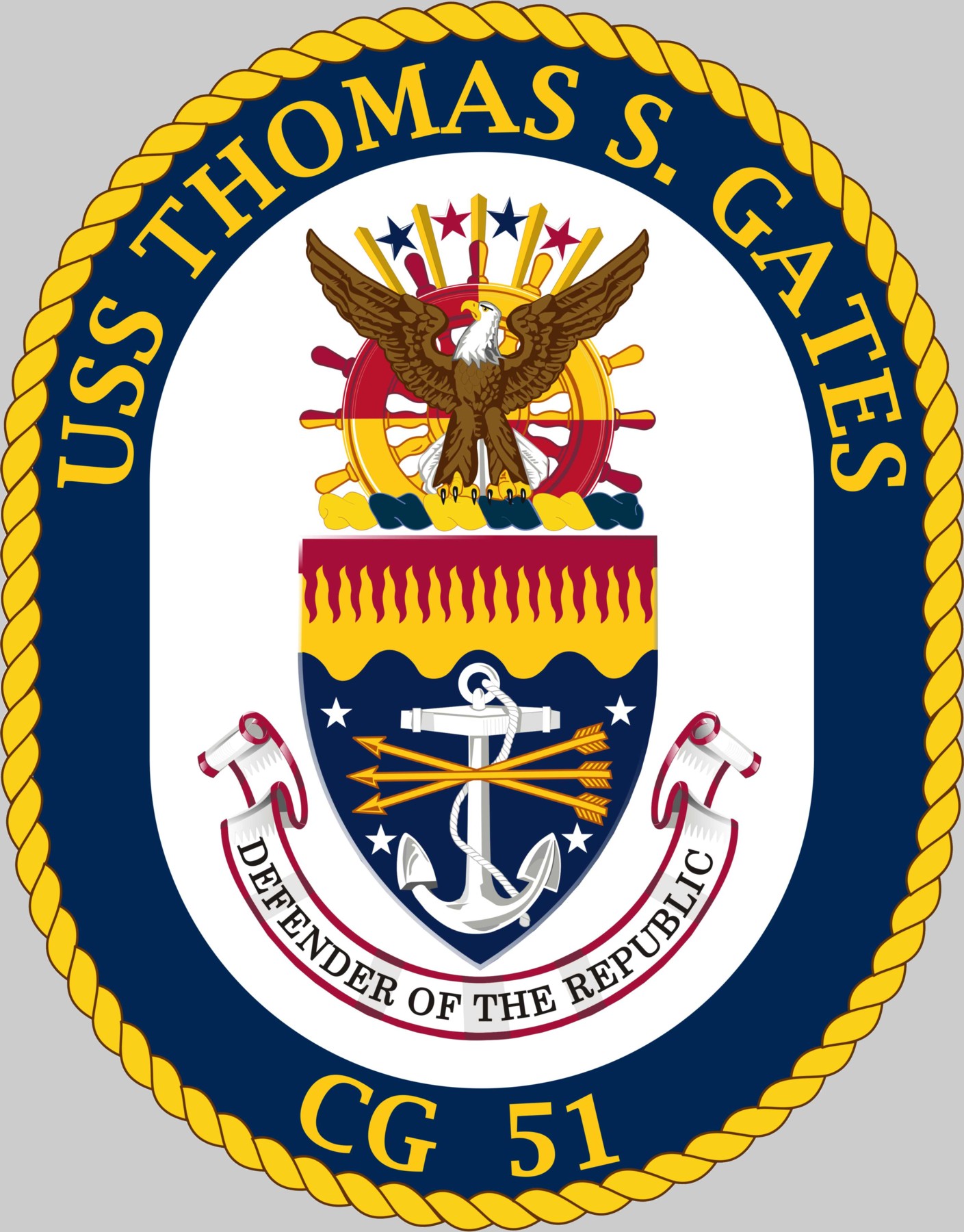 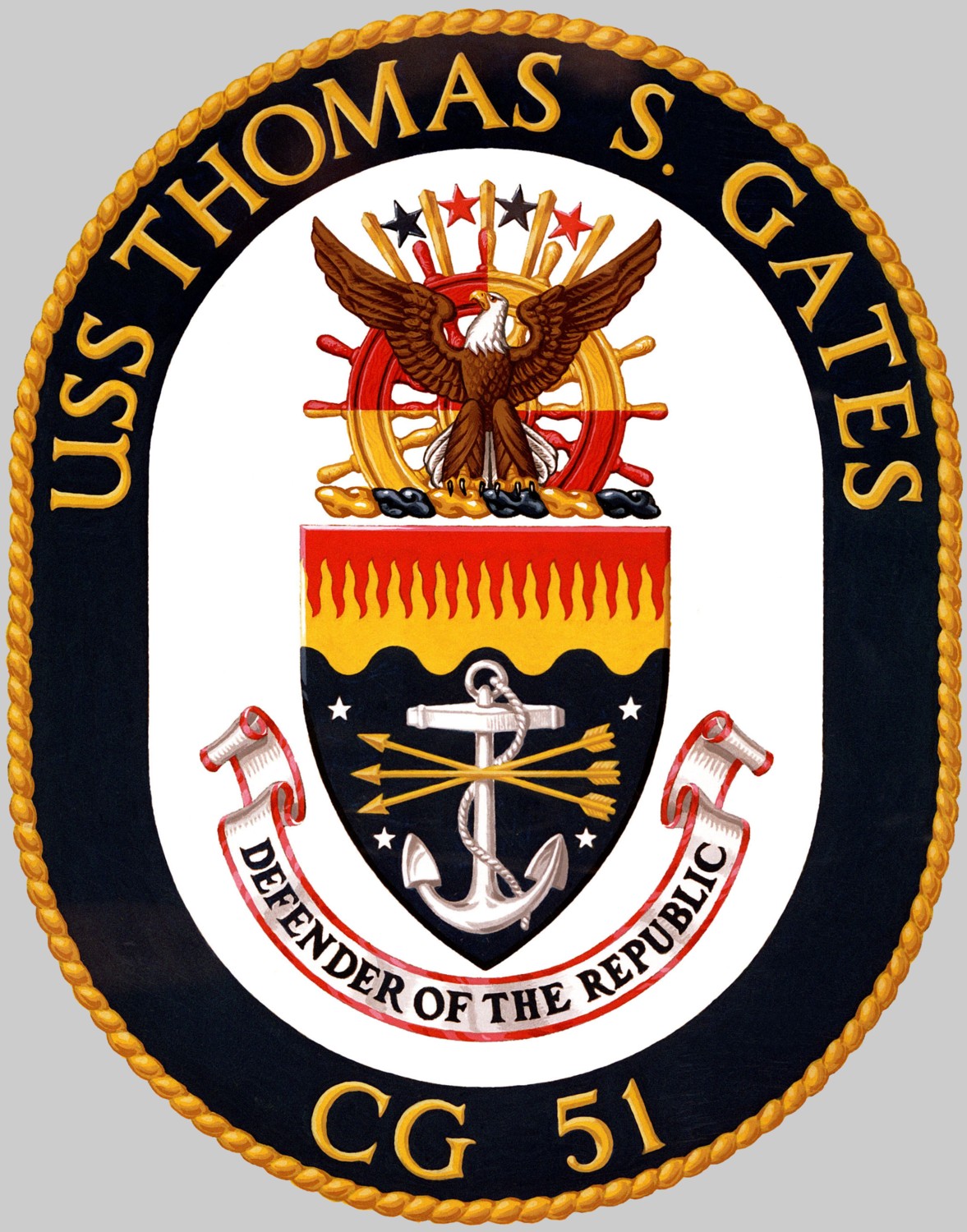 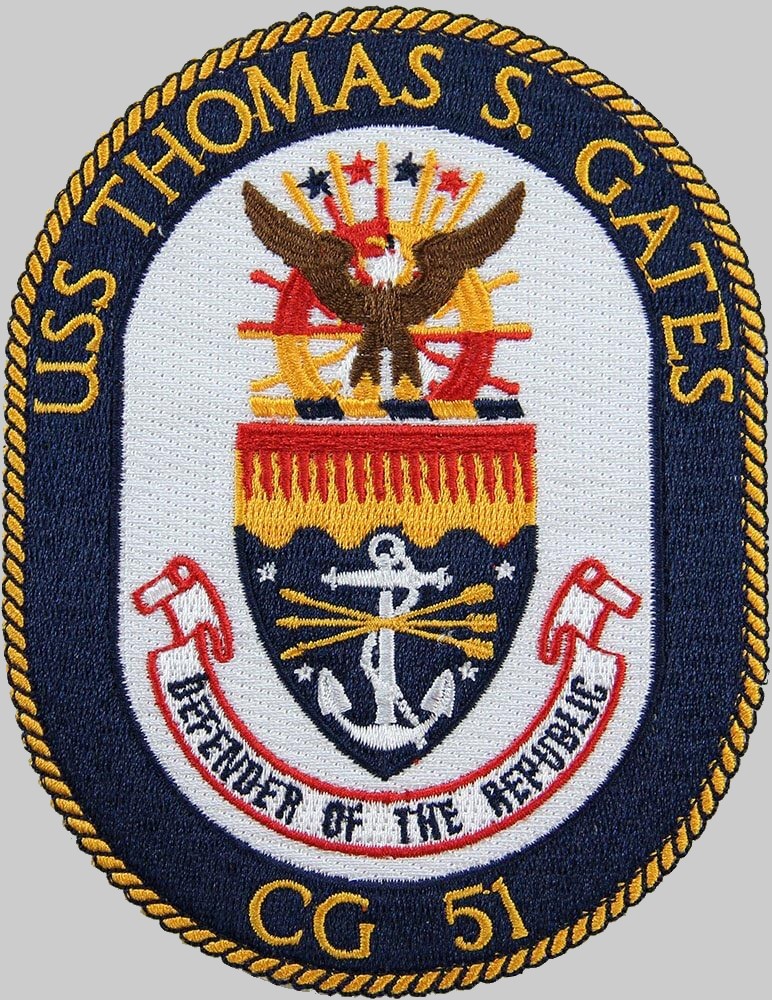 |
||||
|
|
seaforces.org |
USN ships
start page | |
